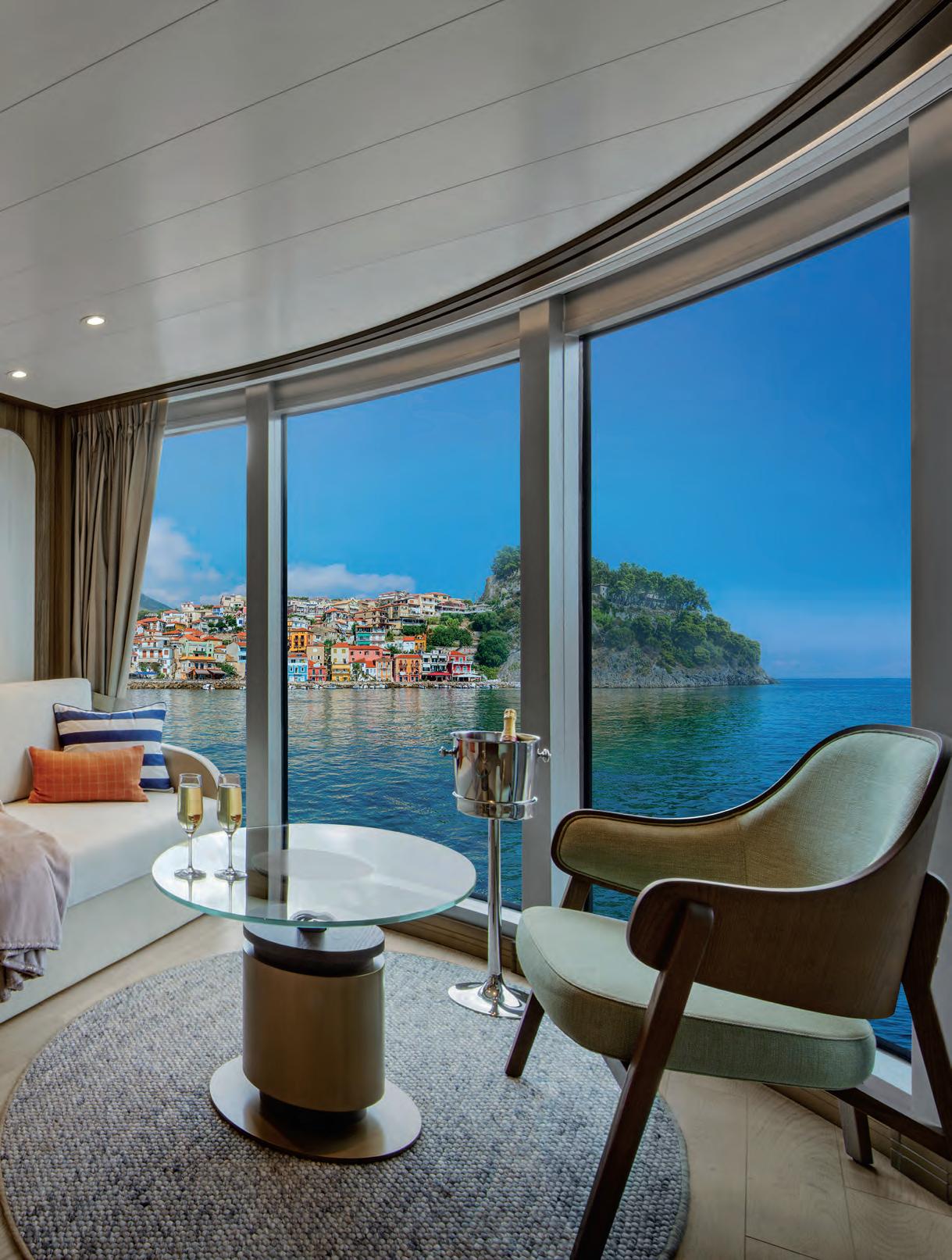







What can you find in Bermuda? Cotton candy skies. Pink sand beaches. Crystal-clear blue waters. The chance to disappear. Sway to the rhythm of island life as you discover the natural wonders, rich history and vibrant culture. Take the time to slow down and get lost in each moment, knowing that another will reveal itself all too soon. That’s the magic of Bermuda.



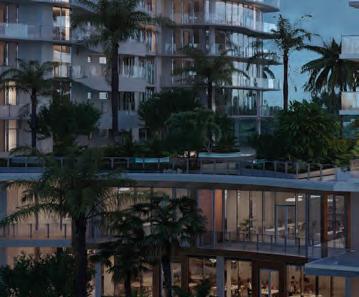
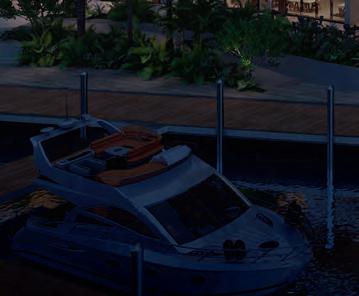

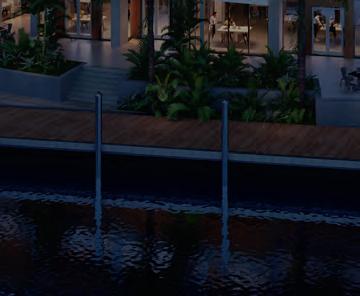

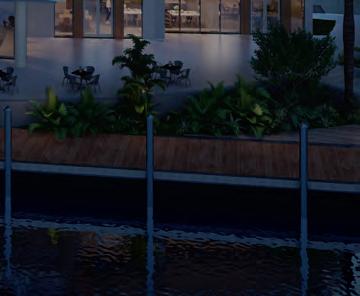














Indulge in the tranquility of knowing your assets are secured. We address the vulnerabilities that threaten your lifestyle, ofering customized protection for your private aircraft, residence, yacht and valuables. Experience a full service, direct path to peace of mind.

ROBERT KERDASHA DIRECTOR
CHAIRMAN
Jim McCann
CHIEF EXECUTIVE OFFICER
Josh Kampel
PRESIDENT
Paul Stamoulis
EDITORIAL DIRECTOR
EXECUTIVE EDITOR
STAFF EDITOR
ASSISTANT EDITOR
CREATIVE DIRECTOR
CONTRIBUTORS
Dan Costa
Seán Captain
Eva Crouse
Gabrielle Doré
Nicole Dudka
Christopher Allbritton, Samson R. Amore, Jason Allen Ashlock, Meehika Barua, Abigail Bassett, Cait Bazemore, James Chen, Kirsten Cluthe, Bob Diamond, Deborah Grayson, Marshall Honorof, Max Isaacman, Larry Kantor, Michael Puttré, Jonathan Russo, Adina Solomon, Tim Stevens
VP OF PARTNERSHIPS & DIRECTOR OF LEADING ADVISORS
VP OF PARTNERSHIPS
VP OF PARTNERSHIPS
VP OF LEADING ADVISORS
DIRECTOR OF ACCOUNT MANAGEMENT
JEWELRY & WATCH SALES DIRECTOR
Greg Licciardi
Dan Figura
Ron Stern
Kevin Haniffy
Kendall Wyckoff
Heather Hanson
HEAD OF MARKETING
MARKETING COORDINATOR
DIRECTOR OF HOSPITALITY
Clyde Lee III
Payton Turkeltaub
Kimberly Anderson-Marichal
Our Mission Is Building Worth Beyond Wealth
Worth helps our influential, successful community better invest their time and money. We believe business is a lever for social and economic progress. From practical financial advice to exclusive profiles of industry leaders, Worth inspires our readers to lead more purpose-driven lives. Through our conferences, digital channels, and quarterly print publication, we connect the people and companies that are building the future. We showcase products and services that are indulgent, luxurious, and sustainable.










Advisors you can count on no matter where your journey takes you. Wilmington Trust is by your side in the communities where you live, work, and thrive, creating a deep connection that you can count on to help bring your wealth plan to life.
Let's start the conversation.



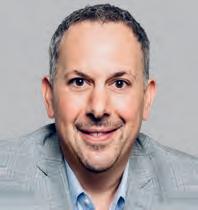
BY JOSH KAMPEL
At Worth, we continue to navigate the ever-evolving landscape of wealth and economic influence, so it was imperative to examine the current generational wealth transfer and its massive impact on millennials. Our latest research underscores a significant shift in the financial paradigm, driven by a potent combination of this wealth transfer and entrepreneurial success. This rise in Millennial wealth not only reshapes our economy but also redefines the societal values and priorities that underpin it.
We were proud to collaborate with Boston Consulting Group on this project. BCG’s extensive experience conducting research for leading organizations across industries, combined with Worth’s direct access to an affluent millennial audience, creates a powerful partnership for this pioneering study.
This exclusive research is highlighted throughout this issue. It will inform our ongoing content strategy and help us better serve
our brand partners with unique insights that will assist them in refining their messaging and engaging with this influential generation.
In addition to exploring how Millennials earn, invest, and spend their money, we studied their attitudes toward philanthropy, purpose, and other interests and attitudes that influence their decisions.
Now 28-42 years of age, millennials continue to emerge as a powerful economic force. While a significant portion of their wealth is inherited, Millennials are also distinguished by their entrepreneurial spirit; many are building substantial wealth through innovative ventures and investments. This generation prefers to selfmanage their investments, with a significant focus on alternative assets like private equity and cryptocurrency. Their investment strategies are diverse and reflect a forward-thinking approach.
While wealth accumulation is a priority, Millennials are notably
more engaged in social justice initiatives and political activities, with many valuing involvement in social causes. This highlights a shift towards a more socially responsible and politically active generation. At the same time, fewer millennials donate money compared to older generations; they prefer to contribute their time and expertise to philanthropic causes.
Findings like this represent a broader narrative about the future of our economy and society. Millennials’ emphasis on sustainability, social justice, and health is driving new market trends and setting the stage for a more conscientious and dynamic economic environment.
As we look ahead, it is clear that the financial decisions and values of Millennials will play a crucial role in shaping the economic and social landscape. Their innovative approach to wealth generation and investment, coupled with their commitment to societal wellbeing, promises to foster a more inclusive and forward-thinking world.
At Worth, we are dedicated to exploring and understanding these trends to better serve our readers and the broader community. We believe that by highlighting the transformative power of Millennial wealth, we can contribute to a more informed and inspired discourse on the future of our economy and society.
For more about our Millennial research, visit Worth.com/millennial.
— Josh Kampel CEO, WORTH MEDIA josh.kampel@worth.com
“Journeys are the midwives of thought.” –Alain de Botton, The Art of Travel
BY DAN COSTA


The best job I ever had didn’t pay me a dime.
Years ago, while running PC Magazine, I got an offer from the U.S. State Department to serve as a cultural attache. The job required giving presentations two or three times a day, organized by the local embassy. The hours would be long, and there would be no pay, but travel would be covered. Sold! Over the years, I have visited Hong Kong, Taiwan, Oman, Portugal, and Uruguay. The people I met on those trips have shaped my career and how I look at the world.
Perhaps it is no coincidence that my current job also comes with some travel benefits. On page 32, you can read about my recent trip to Rome and Crete. Americans tend to have a myopic view of history. It is almost inevitable when your country is only 250 years old. In high school, all of U.S. History was broken into two courses, pre and post 1945. We can barely think in centuries,
but in Rome, the history goes back millennia.
Spending time in Rome causes time to slip, the current and the past colliding in weird ways. An amphora decorating a hotel lobby could be a thousand years old. Or it could be from Pottery Barn. I made fresh pasta in the basement of a restaurant that was also part of the ruins of the theater where Julius Cesar was killed.
Sadly, I can’t take all of the trips myself. We also sent Worth regulars Jonthan Russo and Deborah Grayson to enjoy the serene and stunning landscapes of French Polynesia via cruise ship.This collection of islands, scattered like jewels in the vast expanse of the Pacific Ocean, attracts around 200,000 visitors annually. While tourism is a vital part of the economy, there is a strong emphasis on sustainable practices to protect the natural beauty and cultural heritage. In part, this is because unlike in, say, the Hawaiian Islands, locals still own 85% of the land in French Polynesia. Indeed, with limited tourism infrastructure, a small cruise ship is probably the best way to explore the islands.
The Copal Tree Lodge in Punta Gorda, Belize, is also
trying to combine luxury with conservation to boost the local economy. This rainforest hideaway, with its 16 suites and one villa, employs 180 locals and produces rum, chocolate, and coffee. Its sustainability initiatives include ocean and rainforest conservation, debt-for-nature agreements, and supporting local organizations. Worth’s Eva Crouse visited the Lodge and spoke with its chief sustainability officer. And while she expected to talk about the threat of climate change and overfishing, the growing pirate threat was a surprise. These stories remind us that travel is not just about the destinations we visit but the connections we make and the stories we carry with us. At Worth, we aim to inspire thoughtful and responsible travel that enriches both the traveler and the communities they explore. As we continue to uncover the world’s wonders, we remain committed to promoting sustainability and cultural appreciation, ensuring that the beauty we experience today is preserved for future generations.
— Dan Costa EDITORIAL DIRECTOR dan.costa@worth.com

















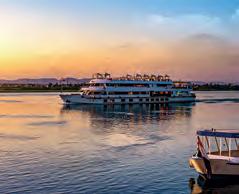



























































Samson is a journalist based in Southern California. His reporting has been featured in outlets including The Advocate Magazine, The Boston Globe, The Los Angeles Blade, The Los Angeles and San Fernando Valley Business Journals.
In addition to his business reporting, Samson covers beats including crime, culture, and labor. He has reported on the entertainment business for TheWrap and lends his skills to the private sector as a content strategist and media trainer.
Samson was a 2023 data fellow at the University of Southern California’s Center for Health Journalism, investigating the public health impact of anti-LGBTQ+ hate crimes in Los Angeles. He is a member of Investigative Reporters and Editors and the Trans Journalists Associations.
When not on deadline, Samson can be found on the golf course, exploring his local National Parks, or entertaining his adopted kittens, Merry and Pippin. His hidden talent is wiggling his ears.
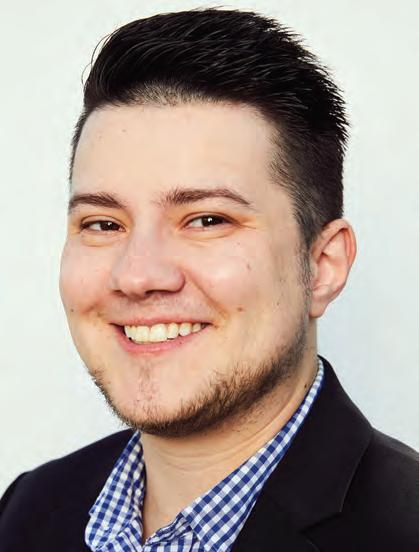
Meehika is a freelance journalist writing for Vogue magazine, The Guardian, Cosmopolitan, Business Insider, Grazia, The Washington Post, Elle, Al Jazeera, Harper’s Bazaar, Reader’s Digest, Allure, and TimeOut, among other publications.
She covers culture, lifestyle, travel, and social issues, sometimes through the lens of tech and human rights. Her coverage has ranged from the rise of accent coaches in the UK to opinion pieces on starter marriages.
Meehika won the 2018 Journalism Now competition for a fellowship with Thomson Reuters. She was also nominated for the 2022 Journalist of the Year award at the Asian Media Awards. She has appeared on many panels to talk about freelance journalism and also teaches freelance writing classes to mentor writers. Some of her workshops have also centered around career change, as Barua changed from studying architecture in university to becoming a journalist after graduation. When not chasing stories, she can be found working on her memoir. Follow her on X(Twitter) and Instagram @meehikabarua

Tim Stevens
Stevens is a freelance automotive and technology journalist with more than 25 years of experience. He is a frequent contributor to major domestic and international online, print, and broadcast news outlets including MotorTrend, TechCrunch, Wired, CBS, and AP, sharing his insights and perspectives on everything from cybersecurity to supercars.
Tim also serves as a juror for the World Car Awards and regularly acts as speaker and moderator at major industry events like CES, Web Summit, SXSW, NAIAS, and AutoMobility LA. He formerly served as editor-at-large and VP of content at CNET. Before that, he was editor-in-chief of Engadget and editorial director at AOL Tech.
A frequent traveler and avid cyclist, if he’s not on a plane he’s probably out putting in miles on his road bike.



Adopting new technology is risky when modernizing classic machines, but Icon 4X4’s Ward sees an EV future for the industry.
BY TIM STEVENS
The restomod business is booming, a burgeoning industry of makers who take vintage autos and make them drive better than new. Every day, a new boutique manufacturer seems to be entering the scene, promising some fresh take on a classic car. The idea is to deliver all the allure of the original machine with none of the vintage compromises, a “reimagining” that drives better than new.
LA-based Icon 4X4 was among the first wave of restomod companies, earning co-founder and CEO Jonathan Ward a position as one of the most respected builders in the world. Now, despite flourishing in an industry with an obsessive reverence for all things vintage, he’s embarking on a potentially disruptive business pivot that even he’s a little nervous about.
Ward and Icon 4X4 are taking on EVs, pausing development on new internal combustion vehicles to focus on battery-powered ones.
Fifty-four-year-old Ward is a former child film and television star, regularly appearing in ‘80s TV classics like “Charles in Charge,” taking a leading role in the 1988 scifi comedy “Mac and Me,” and also playing a role in the 1989 tear-fest “Steel Magnolias.” After deciding Hollywood wasn’t his thing, Ward followed a circuitous path to automotive royalty. He founded Icon 4X4 in 2007 with his wife Jamie, building off their successes at recreating FJ-series Land Cruisers. Toyota’s 1960s-era off-roader is highly prized among retro-minded
collectors, and Icon’s reimagining of that rig, plus subsequent followons, cemented the company’s reputation as a brand that creates truly special modernizations of cars without losing their inherent classic feel.
Icon’s reborn classics come with major suspension and interior refinements and big power upgrades, usually in the form of large-displacement V8s. A modernized 1960s Bronco 4X4 built by Ward’s company can cost well over $300,000, a price tag typically reserved for Ferraris, not Fords.
I spoke with Ward while he was vacationing in San Miguel, Mexico, hunting for fabrics for another of his projects, Campfire Coats. It was a delightfully rambling conversation where we covered everything from in-vehicle networks to the challenges of retrofitting steering racks. Ward was all too happy to delve into his passion for this growing movement away from internal combustion and into electrification.

“You know, when Icon started, we were kind of the first goobers in this modern restomod space, followed by Singer and all these other companies,” he said. “But up until that point, and even today, people that haven’t heard of the brand discover it and go, ‘Oh my god, I can have the best of both worlds... I can have the vintage style and character and distinction and quality, but I can have modern drivability.’”
Increasingly, modern drivability means EVs. Though electric vehicles made up only 7.6% of the U.S. car market in 2023, sales of batterypowered machines jumped 50% over the prior year. Interest in EVs is surging, and Ward’s passions are similarly progressing past V8s.

“Despite flourishing in an industry with an obsessive reverence for all things vintage, Ward is embarking on a potentially disruptive business pivot to electrification that even he’s a little nervous about.
“When you introduce EV into the mix, it’s a whole different demographic that likely would have never known about us or engaged with us whatsoever,” Ward said. He’s aware of some of the recent negative press surrounding EVs, plus the compromises they require, but that’s less of a concern in this space. “Consumers who are going to buy an Icon EV, it’s not their daily driver. It’s for specific lifestyle or locale or mood or vibe or weekend.”
Icon’s first efforts on the EV restomod front were oddities, including a 1974 Volkswagen Thing, a slab-sided convertible with Beetle underpinnings; and a 1966 Fiat Giardiniera, a stretched version of the tiny Fiat 500 supermini. But it was something much larger, a
1949 Mercury Eight, where everything came together.
The Mercury Eight is a particularly significant model on the tuner scene, a long-time object of customizer obsession. The sedan’s already prodigious length is often visually augmented by dropping the roof and stripping away much of the chrome and badging, yielding gleaming, perfectly polished machines often called “lead sleds.”
Ward’s Mercury is different, showing as much rust as paint and sporting more patina than a Roman artifact. The magic, though, lies under that corroded bodywork, a complete mechanical reinvention of the sort you’d never imagine at a casual glance. Despite the lack of internal combustion, finding a way to cool all those electrical components was one of the biggest
headaches. Since the Mercury wasn’t designed for this kind of configuration, Ward and his team needed to come up with a completely custom solution.
“We actually ended up befriending a thermal dynamics flow engineer at a local college to help us through that brain drain,” he said. They ultimately sourced a compressor from an 18-wheeler to handle cooling duties.
Ward’s team filed patents for the way the powertrain connects to the wheels, a dual-motor setup that runs inline where the transmission had been.
While a restomod is all about maintaining character amidst a flurry of modern updates, Ward believes the manual transmission experience is not worth preserving in an EV. “You’re going to use a maximum of two forward gears, if any,” he said.
Despite all the headaches and challenges faced in building “the Merc,” Ward was not deterred. He was emboldened, pausing development on
an internal combustion project to instead develop an electric vehicle platform for the next generation of Icon restomods.
In the automotive world, a platform is the fundamental internal architecture of a car, a set of common components and the requisite software to connect them, which can be shared across multiple models. Large manufacturers use platforms to simplify new vehicle development. This is particularly important as more and more manufacturers embrace electrification, a pivot requiring stratospheric levels of investment.
Hyundai Group, for example, developed the E-GMP platform to underpin its current-generation EVs across all its brands. Cars running on that platform include everything from the slippery little Hyundai Ioniq 6 sedan to the luxurious Genesis GV60 crossover and even the big, three-row Kia EV9 SUV.
The company hopes to sell millions of E-GMP EVs across all its brands,

enough to recoup that initial investment readily. For Icon 4X4, which builds just 40 cars per year, the path to platform profitability is challenging.
Ward puts it more succinctly: “Because my volume is so low, we can’t amortize anything for shit.”
For its own EV pivot, Icon is starting with its most popular products. “We intend to electrify our whole fleet of the production vehicles we build, meaning the Broncos, the FJ series, and the 47 to 53 Chevy pickup line,” Ward said. The Ford, though, will come first. “The Bronco is just so on-trend culturally these days, it won out,” he said. “So, we’re currently building an all-wheel-drive, transmission-less, firstgeneration Icon Bronco EV.”
That shift to prioritize electrification when expanding the Icon 4X4 lineup was not a decision made lightly, and even now, Ward is not without doubt. Before this shift, Ward’s team had been working on a next-generation internal combustion project. “We put that on hold because the demand for the EV has been so strong. And then now I see all this negative EV press,” he said.
Ward said some EV criticism is justifiable, particularly regarding confusion around local and federal incentives, plus the sad state of the U.S. charging infrastructure: “But I really believe in it. As a business decision, I think it could prove to be quite interesting because I’ve already seen, just in early discussions, that it really brings a whole new demographic into our space.”
While that new, likely younger demo craves electrification, Icon can’t ignore the demand for more traditional powertrains. Those V8s aren’t going away anytime soon. “At this point, I don’t see the market being interested in us doing only electric,” Ward said.
For now, at least, it makes sense for Icon to cover all its bases, but the shifting demand will be interesting to watch. Just like you didn’t have to be a kid in the ‘60s to want a first-gen Bronco today, you certainly don’t have to be an environmentalist to want your next Sunday cruise to be battery-powered.

After a pandemic-era boom, many countries are tightening the rules.
BY MEEHIKA BARUA
Lately, there has been considerable debate on social media about leaving the U.S. or other countries like the UK or Australia for a better quality of life in Europe, Asia, and other regions. The rumblings have come from podcasts such as entrepreneur Steven Bartlett’s notable “Diary of a CEO,” as well as from Instagram and TikTok influencers. Kacie Rose Burns’ most popular video on leaving the U.S. for Italy was viewed 19.8 million times. The overriding theme: The new American dream is to leave America.
Record numbers of Americans already wanted to leave the U.S. when Donald Trump won the presidency in 2016, including 40% of women younger than 30, according to a 2019 Gallup Poll. Similar sentiment is seen among British people, as recent polls suggest that most are unhappy with the UK’s direction. In a survey by pollster Omnisis, 45% of British respondents said they would take up the opportunity to leave.
The wealthy are building passport portfolios by applying for second citizenship if they need to flee their home country due to financial instability. Recent high-profile examples include tech billionaires Peter Thiel, who added citizenship in New Zealand, and former Google CEO Eric Schmidt, who has applied in Cyprus.
Countries are constantly launching new visas to attract foreign residents and their economic contributions. In April 2024, Italy launched its digital nomad visa, providing extended residency to remote workers who derive their income from outside the country. Spain, Portugal, Norway, and 50 other countries already have such visas.
British digital PR specialist Laura Burns now lives in Malaga, thanks to Spain’s “teletrabajadora” (remote worker) digital nomad residency. After lockdown, Burns went on a short trip to Ibiza with her friend and realized she wanted to move to Spain. “I had lived in a city for five years, and I was ready to move closer to a beach,” she says.
Not everything about the process seemed rosy. “I waited four months for a form from the UK government, which slowed down my process,” she says. “Also, finding a long-term rental is very difficult in Malaga.”
A long-term rental is required to be registered for the program. Yet Burns has no regrets and says she was lucky to find a great lawyer who did everything from start to finish. “I was also fortunate to be granted three years residency—which is more than I thought I would be granted,” she says.
While there are several ways to get foreign residency, buying into it through a so-called ”golden visa” seems to be the most common one among the elite. This visa allows individuals to quickly obtain residence or citizenship in return for making qualifying investments. However, due to social pressures, those programs are now being eliminated in several countries.
On April 9, the Council of Ministers in Spain voted to end granting visas in exchange for purchasing properties valued at 500,000 euros (about $545,000) or more. In February 2022, the UK government closed its long-running Tier 1 Investor visa route, its version of a golden visa. The Home Office said that the visa category had failed to deliver for the UK people and provided opportunities for corrupt elites to access the country.
“In Spain, the reason exposed by the President during a public press conference was that they were going to focus on the constitutional right of having a home.” So says Marbella Solicitors Group
Law Offices senior partner Eduardo Pérez Mazuecos, who has assisted numerous clients in purchasing properties and obtaining the golden visa. “From the point of view of our many expert agents, this explanation of the measure is not reasonable.” He says properties over 500K are out of range for the average Spaniard, anyway, calling the luxury property and average property markets completely different.
37.4% of digital nomads come from the U.S.*
46 The average age of all expats**
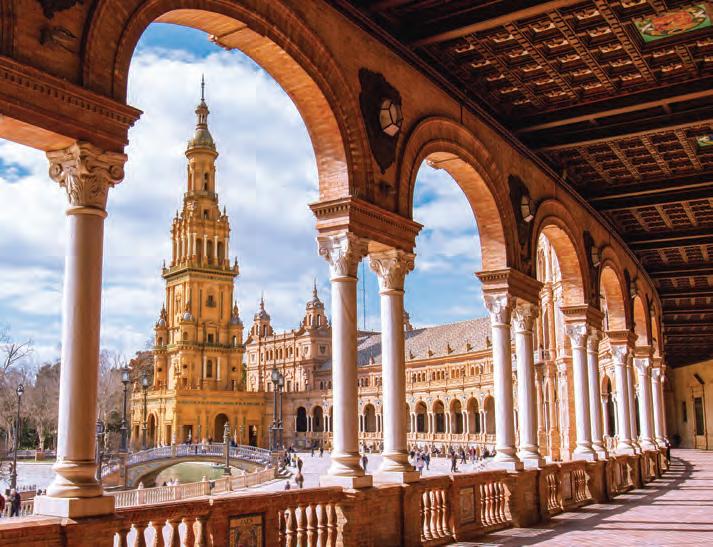
Mazuecos’ office specializes in advising English-speaking clients on legal and tax advice and mainly deals with real estate law. Apart from purchasing a property, foreigners could also access the golden visa by purchasing public debt or shares on Spanish properties or making bank deposits. However, Perez Mazuecos says that the investment amount must be considerably higher. “In any case, the policies of canceling the golden visa programs comes not only from the government but these decisions are also pushed by the EU Commission which is pointing in that direction.”
Patrick Mitchell, a U.S. citizen with a Spanish residence visa, says it took nine months to get the paperwork. His wife and children live in Spain, while he travels back and forth to the U.S. Patrick’s realtor in Spain (a Danish expat) was exceptionally helpful in navigating the process, he says, by introducing them to legal counsel in the country. His advice is to work with a reasonable attorney, since certain forms of residence visas are being abolished due to concerns about housing costs.
Portugal ended its golden visa last year after thousands of people took to the streets of Lisbon and other cities to protest skyrocketing rents and house prices. These come at a time when high inflation is making it even harder for people to make ends meet. “With the removal of nonhabitual residents in Portugal, and the increase of golden visa investment in Greece, our clients are starting to research other suitable countries to settle for their retirement,” says Ellie in an email. She asked that we use only her first name to protect her job at Praia Club, a company that helps people to immigrate throughout Europe. It’s used widely for destinations like Spain, Portugal, Italy, Greece, Cyprus, and Dubai. Portugal’s Non-Habitual Resident (NHR) special tax regime allows qualifying entrepreneurs, professionals, and retirees to enjoy reduced tax rates on Portuguese-source income and exemption on most foreign-source income for 10 years.
“In terms of visa options, we’re facing more difficulties. The government wants to receive qualified professionals or retired people who are willing to stay for a long time in the country,” says Giselle, who works in Praia Club’s legal team, in an email. She also asked that we use only her first name to protect her job. For example, three years ago the Portuguese consulates accepted Airbnb and Booking.com reservations as proof of accommodation.
“Today, for all the long-stay visas, which are longer than one year, it’s mandatory to have at least one year of rental accommodation or to buy your own house. Which means more investment and time before the visa application,” says Giselle. The requirements are getting more restrictive every year.
“We think the major challenge today is to face the bureaucracy and the stress involved in the visa process due to the increase in visa applications. We have changes in the law and on the directives every semester or year,” says Ellie. She adds that requirements are also common and differ by jurisdiction and consulate.
“But besides these difficulties, Portugal remains one of the most preferred countries to move abroad, and the good news is that these changes in the internal procedures means that the government is attentive to reduce these problems,” says Ellie. The immigration process for Italy, Greece, and Cyprus has its own challenges, too, especially if one manages them alone and from abroad, she says. However, Louise Carr, the founder of movetospainguide. com, a company specializing in the Spanish Digital Nomad Visa, thinks the process is getting easier. Since launching in early 2023, the program has had 10,000+ successful applications. “Until then, it was very difficult for non-EU passport
holders to come to Spain for work. There were lots of barriers,” says Carr. As Spain is a country with high unemployment and an excellent health service, it makes sense why these barriers exist. However, in the case of the digital nomad visa, the applicant’s employer or client must be located outside of Spain, which means that no jobs should be taken from Spanish citizens.
“Even though Spain has just modified (not yet abolished) the Golden Visa, that is a completely different kind of residency,” she says. “It was possible for golden visa holders to spend up to 182 days in Spain each year and avoid becoming a Spanish tax resident.” Digital nomad visa holders, on the other hand, must spend over six months in Spain each year, which means that they cannot avoid becoming tax residents.
For Burns, the Brit in Malaga, Facebook was the best resource for figuring out the ins and outs of the system. “I joined a group that was full of lawyers and people wanting to apply for the Spanish Digital Nomad Visa. There are several Facebook pages with information that simplifies all the important information you need. At first, I thought the process seemed very complicated, but it turned out to be much easier than I thought,” she says.
While Europe—especially Portugal and Spain—may be the most talked-about region in the press and social media, other continents also beckon digital nomads. South East Asia is also one of the most coveted destinations due to the low cost of living and ideal weather. People can live comfortably in Bangkok for just $1,400 monthly, including rent. Thailand’s digital nomad visa grants professionals up to 4 years of residency, but they must make at least $80,000 per year. With these stricter requirements, Thailand hopes to attract more affluent, highly skilled professionals.
Malaysia’s capital city, Kuala Lumpur, is considered one of the best destinations in Asia. The Malaysia digital nomad visa allows people to live in the country for up to two years. The Philippines also launched its digital nomad visa in June 2023, allowing applicants to live and work there for 12 months, with a possible extension for another year.
Effective April 1, Japan introduced a “Digital Nomad Visa” to qualifying foreign nationals to remotely work and stay in Japan for up to six months. It will be available to nationals of 49 countries, including the United Kingdom and the United States.
Giselle points out exceptionally favorable options in the United Arab Emirates. “Dubai offers visas for many different categories—it is also a very slick process. We can have someone’s residency permit approved and issued after just a two-week stay in Dubai.” Singapore also offers residency programs and tax benefits, as does Malaysia. “However, we do see that unless someone is relocating for professional purposes, the majority of emigrants are choosing to settle in Europe,” says Ellie.
12,718 Golden Visas issued in Portugal*
$7 billion Invested by Golden Visa holders in Portugal*
Many North Americans are also choosing to settle in Panama and South America, due to a preferential tax position in those countries, making their Social Security stretch that bit further, says Ellie
The profusion of options for living and working abroad has propelled nomadic living as an empowering alternative to traditional life. More people are choosing to live outside the norm, and the trend doesn’t seem to be slowing down anytime soon.
BY KIRSTEN CLUTHE
The first time I visited Kings Road in London, it was in pursuit of its counterculture reputation and the bands that embodied it. I was in high school and, with a friend, ditched my class field trip to find Kings Road, the notorious street where Malcolm McLaren and Vivienne Westwood held court among London’s punk rock elite. Hoping to run into one of the bands we loved, we found ourselves at the Chelsea Potter, a traditional pub established in 1760 that had become the epicenter of the antiestablishment movement by the time we showed up in the mid80s. We met a rockstar at the bar that evening—Mars Williams, the saxophonist for The Psychedelic Furs.
From William Blake to Damien Hirst, Banksy to The Rolling Stones, London has long been the birthplace and home of influential artistic movements and cultural revolutions. London’s richness lies in its diversity, with each neighborhood offering a unique slice of the city’s history while layering an appropriate amount of modernity into the experience. And so it was with the aforementioned friend that I recently spent a long weekend with in London in the fresh pursuit of art, culture, and great food. Kings Road may have changed since my last visit, but it’s still as interesting as ever.
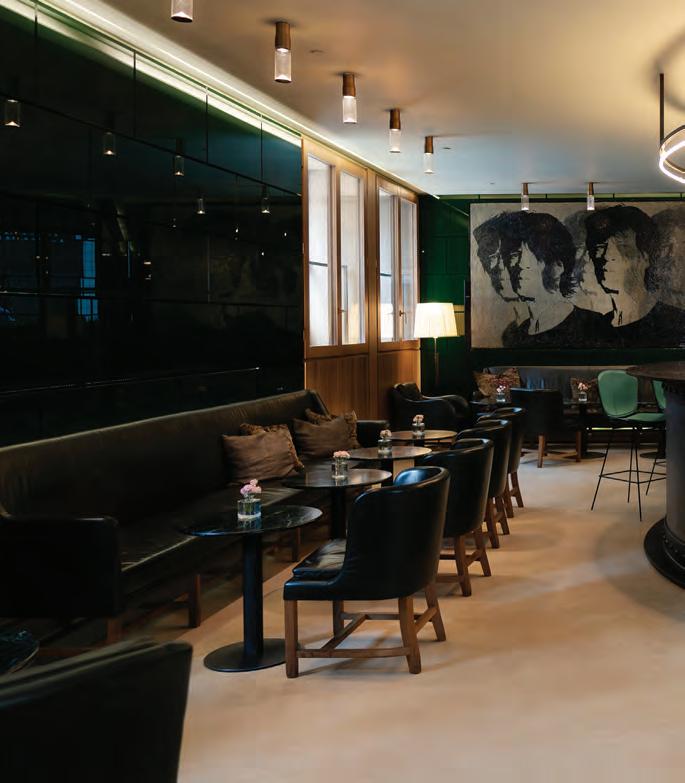
A daytime flight from New York to London always seems like a good idea until you arrive exhausted and need something to eat before heading to bed. Luckily, the Chelsea Townhouse was my first destination. Though the kitchen was closed by the time I arrived, the gracious front desk manager directed me to take away options nearby—and thus, I highlighted what distinguishes Chelsea Townhouse from other hotels in the city: location. The hotel is the latest addition to the Iconic Luxury Hotels collection in a residential part of Chelsea. Formerly known as the Draycott Hotel, the building has shed its oldworld style—characterized by heavy furnishings, ornate wallpapers, and chintz—favoring a sophisticated neutral palette, elegant mid-grey walls, and chic, modern amenities. It’s so cozy and comfortable that you may do nothing more than sleep in or chill out with a good book, occasionally padding your way to the dining salon
on the first floor to enjoy a meal and a drink by the garden. Because guests have access to 11 Cadogan Gardens around the corner, you don’t have to venture far to hit the gym, a bar that stays open late, and Hans Grill, a modern all-day cafe and bar for more food and beverage offerings.
Of course, there’s too much to do, and everything London offers is practically outside your door. Kings Road, now filled with stylish boutiques, hip cafes, and pubs—yes, the Chelsea Potter is still there—is a short walk from the hotel. Bustling Sloane Square is also nearby, a hub for high-end shopping, featuring flagship stores of renowned fashion brands and luxury brands like Diptyque, Balenciaga, Cartier, Dior, Hermes, and more. Need help figuring out where to go, or just want to keep the paparazzi away? Tap into the Sloane Street Concierge for assistance with restaurant recommendations and reservations or booking an out-of-hours appointment at a Sloane Street boutique.



While I was in town, the Saatchi Gallery hosted an exhibit on Edward Burtynsky, the renowned Canadian photographer known for his captivating and thought-provoking images of industrial landscapes. It was the largest showing of his work and featured 94 of Burtynsky’s large-format photographs as well as 13-foot high-resolution murals and an augmented reality (AR) experience. It was a powerful and stunning display of his work, beautifully detailed photographs of plundered landscapes. As luck would have it, my travel companion ran into the artist himself at the Hans Grill bar on our first evening in town.
Located around the corner from the hotel in the elegant Duke of York’s Headquarters in Chelsea, the Saatchi Gallery has become a prominent showcase for contemporary art since its inception in 1985 by Charles Saatchi. The gallery’s spacious, light-filled rooms provide an ideal backdrop for the everchanging exhibition roster featuring cutting-edge works by emerging and established artists like Burtynsky from around the world.
The Victoria & Albert and the Natural History Museum are within easy walking distance or just one stop away on the District line from the Chelsea Townhouse. The V&A Museum hosts exhibits that span “5,000 years of human creativity,” it says. Pop culture, fashion, architecture, music—even wallpaper and embroidery—are all subjects you might find at an exhibit. Current shows
include one dedicated to Naomi Campbell’s career in fashion and another that showcases a collection of photographs from the Sir Elton John and David Furnish Collection. Meanwhile, across the street is the Natural History Museum. Housed in a stunning Romanesque building in South Kensington, the museum is renowned for its impressive architecture as much as its vast collections. Visitors are greeted by the awe-inspiring Hintze Hall, featuring the magnificent blue whale skeleton suspended from the ceiling. Exhibits span a range of topics, from dinosaur fossils and rare gemstones to interactive displays about climate change and biodiversity. Right now, they’re featuring several guided tours focusing on women scientists who changed the world through their work in paleontology, space, and nature. You can also participate in some of the museum’s social activities, like a Silent Disco or a sleepover with food, drinks, and morning yoga when you wake up the next day.
All of the gallery-wandering will undoubtedly make you thirsty. Luckily, you can jump in a taxi and head to The Connaught in Mayfair for cocktail hour. The Connaught Bar, a celebrated destination in its own right, is renowned for its incredible design, inspired by 1920s English and Irish Cubist art. The cocktail program reflects the era, and you might order a Vintage White Lady—a Gin, Cointreau, and lemon juice concoction that was famously included in Harry Craddock’s Savoy Cocktail Book; or you might opt for the Connaught Martini, which is the classic aperitif served from their famous trolley, tailored to your taste with a selection of vermouths and handmade bitters. If cocktails aren’t your thing or you prefer an elegant glass of wine, the Red Room is The Connaught’s cocooning wine bar, accessible only through a velvet-curtained doorway from the Champagne Room. Showcasing a collection of creative works in red, the
stunning interior features a soft-hued palette that highlights art curated over several years by four visionary female artists. Follow the hand-cut mosaic runway, crafted by Italian artisans, to the striking pink onyx bar or marvel at the red-flecked marble fireplace, dominated by Louise Bourgeois’ piece “I Am Rouge.” Bourgeois’ work is complemented by crimson and scarlet creations from Jenny Holzer, Tia- Thuy Nguyen, and a singular photographic piece by Trina McKillen. Flanking the fireplace are two dramatic glass panels in vivid reds and blues by celebrated British artist Brian Clarke, the only male artist represented in the Red Room.
It’s an ideal backdrop for enjoying a world-class wine served from a custom-crafted marble trolley alongside a capsule collection of six cocktails, each inspired by the wine selection and crafted to reflect the changing seasons. The menu features imaginative small plates such as charcuterie, veal carpaccio, and kale tempura, which is all you need with such an extensive wine list at your disposal.
To mix things up, we headed across town to Hotel Café Royal, where we would stay for the remainder of the trip. Once a vibrant hub of high society in the late 19th and early 20th centuries, Café Royal has been meticulously restored by architect David Chipperfield into a superlative hotel, while preserving its historic charm. The hotel effortlessly blends period charm with contemporary sophistication, with rooms clad in mock Portland stone or pale English oak. Each space exudes understated luxury, from the Tudor Suite boasting an original 16th-century fireplace to the Dome Penthouse, which features a private cinema and expansive terrace overlooking the city.
My room, a Regent Suite, was essentially a one-bedroom, two-bath apartment with more closet space than any home I have ever lived in. I didn’t even discover the second bathroom until my second day in the hotel. The ambiance is quietly sophisticated, lean-
ing towards minimalism, except for the unexpected touch of leather sofas in charming dusky pink and khaki green hues. However, luxury reigns supreme, evident in the fine details such as Frette linens—my initials were embroidered on the pillowcases—spacious bathtubs carved from single slabs of stone, discreetly integrated TVs within bathroom mirrors, bedside-controlled curtains, and cutting-edge Bang & Olufsen technology.
What truly astonishes is the tranquility within the rooms. Despite the building’s proximity to the vibrant Piccadilly Circus billboard, its tripleglazed windows ensure absolute silence. It’s truly an oasis amidst the lively cityscape. The main entrance is discreetly situated on Air Street, and its location in the heart of Piccadilly means you can easily move from one neighborhood to the other.
Intrigued by the description, “an Absinthe wonderland,” we opted to visit Green Bar in the hotel, where meticulously crafted cocktails are served in delicate glasses, and the lush green hues of the bar provide a serene, Alice In Wonderland-like environment. The cocktail menu reads like a storybook, and our server guided us towards three absinthe cocktails, all different, as a way to taste the variety. It was an experience you won’t find elsewhere, and even if you aren’t a fan of absinthe, the cocktail program at the Green Bar is exquisite.
Mayfair, known for its refined elegance, is home to some of London’s most prestigious addresses. Take a leisurely walk around Grosvenor Square and enjoy the beautiful architecture. Visit the Royal Academy of Arts for a dose of culture, or unwind in the tranquil Green Park, which offers a peaceful respite amidst the urban bustle.
In contrast, Soho is the beating heart of London’s entertainment scene. This area is a cultural melting pot, offering everything from vibrant nightlife to eclectic eateries and

quirky shops. Catch a show in the West End, explore the independent boutiques on Carnaby Street, and soak in the lively atmosphere of this iconic neighborhood. You’re in the center of the theater district— London’s version of Times Square, though thankfully, much smaller and less gritty. If world-class theater is your idea of the perfect evening out, look no further. The energy and creativity of London’s theatre scene are truly unparalleled.
BOB BOB RICARD
Bob Bob Ricard is a three-minute walk from Café Royal, a glamorous restaurant famous for its “Press for Champagne” button at every table. The interior resembles the fine dining car of a train, comfortable yet ornate and a lot of fun. Elevated comfort food is on the menu, a fine pairing for the champagne you will undoubtedly order. It is worth visiting despite what might seem like a lavish price for chicken pot pie. The pot pie is outstanding.
BÉBÉ BOB
Bébé Bob, Bob Bob Ricard’s scaledback rotisserie chicken, caviar, and champagne spot next door, designed in the style of a mid-century airport lounge, is also fun if you’re in the mood for something more casual.
Café Royal will provide you with a personal chauffeur and a luxury car for up to 10 hours per day for those staying in Deluxe Suites and above. It rained on the day we had a chauffeur, which isn’t surprising in London, but it made us appreciate the comfortable ride around town all the more. Our driver, Ameen, knew the city well, was a wonderful conversationalist, and waited patiently while we explored Camden Town and its iconic market.
Set along the banks of the Regent’s Canal, Camden Market is a cultural hub where music, art, and fashion collide. Live music performances echo through the narrow alleyways while street artists showcase their talents on every corner. Graffiti murals adorn the walls, adding color to the bustling atmosphere. There’s a reason why Camden is known as the best neighborhood for live music in London—it’s home to Camden Palace, the venue where bands like The Sex Pistols, The Clash, The Cure, and Madness got their start. Amy Winehouse called it home, and it’s rumored that the infamous feud between Oasis and Blur began in the Good Mixer pub.
The market’s culinary diversity mirrors its multicultural ambiance. At The Cheese Bar, a counter-only space awaits, beckoning with British and London cheeses in thoughtfully crafted
dishes. Nearby, Chin Chin Labs presents innovation in the form of ice cream— flavors like tonka bean and Valrhona chocolate are adorned with gourmet touches like fleur de sel caramel and bee pollen honeycomb, and the special offering is a brioche waffle pour-over. If you descend into the depths of Delancey Street, you’ll discover Yokoya, one of London’s rare izakayas, a subterranean sanctuary with cozy wooden booths and ample bar stools where shochu, sake, and beer lead the charge, complemented by a respectable selection of Japanese single malts. The culinary offerings are equally enticing, from delicate mackerel and sea bass sashimi to hearty servings of chicken karaage and grilled onglet with sweet yakiniku sauce.
We grabbed coffee with a Londonbased friend at Luminary Bakery, a social enterprise that empowers women facing social and economic disadvantages. Luminary helps women gain employability and entrepreneurship skills, offering courses, work experience, and paid employment in its bakery. The coffee and pastries were delicious, and the place was packed.
As I strolled through Camden Town, I was reminded that London’s magic lies in its ability to seamlessly blend history with modernity. From the rebellious spirit of Kings Road to the sophisticated charm of Mayfair, London’s artistic soul remains as captivating and diverse as ever.

The business hasn’t gone as smoothly as hoped, but new players are promising new types of rides with lower prices.
BY ABIGAIL BASSETT
For the affluent adventurer, space offers a unique allure: exorbitant prices, stringent physical prerequisites, a scarce number of seats, and the compelling “overview effect.” Getting high above the Earth changes how we see everything from our own selfhood to borders, politics, and our interconnectedness.
Space tourism provides an exceptionally rarefied experience for those who have already conquered Everest or explored Antarctica in luxury. While the sector has encountered significant financial and technical challenges, new companies are joining the fray, offering (comparatively) more affordable escapades for those willing to make a substantial investment.
The market is divided into two segments: orbital and suborbital. The former is considerably more expensive and rare. Only state-owned Roscosmos out of Russia, and Axiom Space and Elon Musk’s SpaceX out of the U.S. have been able to offer those trips, which require vehicles to reach a speed of 17,400 mph and punch out of the Earth’s atmosphere. There have been roughly ten orbital space launches with tourists on board since the early 2000s. Musk’s SpaceX successfully sent astronauts to the International Space Station for the first time in 2020. Then, in 2021, it launched its first tourist flight in collaboration with Axiom Space, with four civilians orbiting the Earth for three days during the Inspiration4 mission, without any professional astronauts on board. Two subsequent missions have taken tourists to the International Space Station. Tickets are in the $50-$70 million range.
In suborbital flight—which requires less power, speed, and money—a vehicle crosses what is known as the Kármán line, a proposed boundary that is roughly 330,000 feet above sea level. The main players have been Richard Branson’s Virgin Galactic and Jeff Bezos’s Blue Origin, at prices above $200,000 per ride, but several new providers are poised to enter this space.
According to NSR, a global satellite and space market research firm based in Europe, the suborbital space tourism sector is projected to reach $2 to $2.2 billion by 2033, and the pricier orbital sector is expected to approach nearly $20 billion. While that sounds tremendous, analysts say space tourism is still in a very nascent stage, and the industry continues to encounter challenges.
“I think we’re in a bit of a stall pattern right now,” Dallas Kasaboski, principal analyst at NSR, said, underlining that Virgin Galactic has been around for more than 20 years. It has made 11 crewed missions with tourists. “We’ve made a lot of progress in the last five years,” Kasaboski said, “but there have been a few stalls since.” Blue Origin had six crewed flights since July 2021, but a 2022 malfunction on an unmanned mission caused it to ground operations for nearly two years. Blue Origin finally resumed human flight on May 19.
Branson’s Virgin Galactic has become mired in the ongoing Boeing scandal, suing over shoddy work on its next-generation mothership that carries the space planes on the first part of their journey. And it faces serious financial troubles. However, the company is currently working on a new suborbital plane.
Kasaboski notes that there is a lot of pressure to get these space flights right. “I think we’ve moved past the period of early technological development. We’ve seen two
prominent companies [Virgin and SpaceX] flying people to space several times…but there’s a lot of caution and a lot of checks and rechecks that are being done before this market truly takes off,” Kasaboski said. “Public perception of risk is a major challenge, and I think, practically speaking, it may inhibit funding, which then slows these companies down from developing their vehicles.”
Despite these challenges, Kasaboski notes that the industry is in a unique place, as demand is currently significantly outstripping supply. “People are willing to spend several percentages of their yearly worth, or their full net worth, just for this once-in-alifetime experience,” he says, noting that NSR estimates suborbital demand at around 200,000 people, and orbital trip demand is likely less than 100 people. As space tourism becomes more accessible, those numbers will likely go up, according to Kasaboski.
There are currently a few ways to get to (or at least close to) space as a tourist: via orbital and suborbital rocket (SpaceX and Blue Origin, respectively), or suborbital plane (Virgin Galactic). Now, a slew of companies like Space Perspective, Halo Space, and WorldView are aiming to use high-altitude balloons to gently lift tourists to suborbital heights, 100,000 feet above the Earth.
Roman Chiporukha is the cofounder of SpaceVIP, a bespoke tour operator that recently announced plans to host a Michelin-star dinner aboard Space Perspective’s Spaceship Neptune for $495,000 per person. Chiporukha says that a few years ago, he was approached by a space company (which he declined to name) to help promote the first private mission to the International Space Station in 2022. Chiporukha placed
one of the tourists on that trip and has since built a successful space travel business that works alongside wealthy tourists looking to the stars for their next adventure.
Roman & Erica, Inc., the lifestyle management company he and his wife run, already had a reputation for working closely with well-heeled consumers looking for unique experiences, like coordinating exclusive access to Paris Fashion Week with the Alexander McQueen team.
Chiporukha notes that space travel on suborbital balloons can be similar to flying on an airplane. However, there are many physical and financial hoops to jump through if you want to get on the next rocket into orbit. “First, you need to show your serious intent to go to space, and that’s typically done financially,” Chiporukha said. “There are some hard costs to do a proper medical [evaluation] and training. All of those things cost tens of thousands of dollars to do in a proper setting. If you are not qualified, you don’t get that money back.” Chiporukha notes that companies will financially vet travelers to ensure that they have the liquid assets required to pay for their space flight.
As NSR analyst Kasaboski points out, even if you do invest in an orbital trip, there’s no guarantee that you’ll actually go. “There are people who bought tickets over a decade ago, who are finally getting a chance to fly now. So expect that kind of window,” he said.
Suborbital trips, like those that Virgin Galactic and Space Perspective offer, require far less physical preparation and cost less. Balloon trips are especially easy, according to Jane Poynter. The Space Perspective founder and co-CEO got her start in otherworldly adventure as part of the team that lived and worked from 1991 to 1993 in Biosphere 2, a hermetically sealed environment in the Arizona desert.
Poynter says that as long as you are physically fit enough to travel in an airplane, you can travel in their capsule, which hangs below a space balloon. That is, if you can afford the $125,000 per-person ticket. That gets you a six-hour excursion—two hours each for lift-off and landing—and two hours hovering above the Earth.
The balloons launch from boats off the coast of Florida and splash down again in the ocean upon return. The technology is the same that NASA has used for decades to launch research equipment, such as telescopes (though not astronauts), according to Poynter, who says it is a much gentler way to get the overview effect. The balloons are filled with hydrogen to lift off passengers, But the company rejects comparison to the Hindenburg. Hydrogen is the gas of choice for balloonists around the world, it says, explaining that the balloon is designed to keep the flammable gas from mixing with oxygen in the ambient air. Space Perspective is also aiming to be carbon neutral—thanks to using balloons instead of fuel-burning rockets, and through other measures, such as carbon offsets.
Space Perspective plans to take people up in a comfortable pressurized capsule, designed to provide 360-degree views through huge windows. Passengers will not experience weightlessness, however.
The trip, Poynter promises, should be breathtaking. “As the sun starts coming up, it creates these wild rainbows on a planetary scale that are just crazy,” she says, “and then eventually, you’ll have the sun in that classic black sky, and you will see that iridescent thin blue line of our atmosphere, the curved horizon that astronauts talk about.”
The gentle ride and long duration of the trip allow for plenty of luxury experiences, too, like the one that Chiporukha and his partners are putting together. In addition to that Michelin-Star dinner, there’s discussion of bringing musicians, celebrities, and more to drum up more

demand for the exceedingly expensive escapades.
Poynter says she anticipates Space Perspective flights to begin sometime in 2025, pending clearance from the FAA and the Office of Commercial Transportation. The company plans around 50 flights in its first year, and double that in the second. As of May, Space Perspective said it had booked nearly 1,800 seats.
The reality, however, as Kasaboski points out, is much more nuanced. “Theoretically, the [balloon] technology should be easier to develop and launch more often at a cheaper price than rockets or rocket planes, however, a number of factors have held this market back,” he says.
Balloon technology can be easier to deploy because the hydrogen used to lift the balloons to space is more affordable than rocket fuel, but it is far more limited thanks to short supply around the world. There are also intellectual property litigation issues, he adds. “In short, the technology is interesting and should take off, but the market remains underdeveloped, underinvested, and slower to develop than other forms of space tourism,” says Kasaboski.
Space Perspective’s Spaceship Neptune capsule
The space tourism business has passed the initial hurdle of demonstrating that these trips are possible, says Kasaboski, but it’s far from fully established. “With this market, it’s more that we know there’s demand and people are lining up to buy tickets,” he says, “but the flights are not ready yet.”
Though there’s been plenty of criticism about billionaires going to space rather than solving hunger or homelessness right here on Earth, those working in the space tourism industry claim that it can benefit society. They underline that many of our modern comforts and tools have come as a direct result of space exploration—everything from the GPS in your car to the exercise bike in your bedroom.
Providers also defend the intangible benefits of the overview effect. “It is our job to give them the most extraordinary experience,” Poynter said. “We anticipate that some fairly large percentage of those people will be deeply moved and come back and do something extraordinary with that experience.”


Teaching poker to women, Jenny Just fosters confidence and strategic thinking in traditionally male-dominated fields.
BY EVA CROUSE
Jenny Just, co-founder of Peak6 Investments and visionary behind Poker Power, has found a unique and shockingly effective way to empower women in male-dominated fields. With a career spanning over two decades in finance and technology, Just has made significant strides not only in business but also in the fight for true financial and cultural gender equality. Her distinctive approach involves teaching women and girls to play poker—a game traditionally played by men—to develop crucial skills such as risk assessment, strategic thinking, and confidence. What started as a small experiment soon evolved into an initiative that has reached over 280 companies in more than 40 countries.
Worth recently spoke with Just about her business philosophy and how she helps women and girls build their confidence. This interview has been edited for length and clarity.
When did you know you wanted to teach women and girls to play poker? Why?
I started because of my daughter, who was losing a tennis match… Her dad was watching her play, and she was losing, even though she was probably the better athlete. He was frustrated that she was losing, but he didn’t want to tell her. So he came home and let his frustration out with me. [He] said she just hadn’t realized that she was playing against someone who’s thinking and strategizing based on not only what they brought to the game but also what’s happening in the game. He said she needed to learn to play poker.
From lesson one to lesson four, literally the skies opened; it was that impactful. What those girls experienced and what I saw in [them] really was about their confidence. It grew [exponentially] from lesson one to lesson four—we’re talking about four one-hour lessons.
I always knew that if I had something tangible that could really benefit women around money and taking risks…I would do it.
When I started to learn, I realized: here it is. This silly little card game called poker was really the answer. For women to get comfortable taking risks, allocating capital, [and] strategizing, it could really change their whole approach to this idea of perfection and what it means to fail—and pick yourself back up again. Men and boys are practicing this for 10 years before they get to the workplace.
People say women are more riskaverse when it comes to investing. I’ve noticed that it’s often framed as a positive thing. What are your thoughts on that?
It’s a stat I would hope we would get away from…In poker, every hand is a risk. Which hands am I going to play? …If I never get a good hand, which is possible, I could be sitting for an hour [waiting]. Am I not going to play? If [I walk] into a meeting, and the perfect situation never happens, I never open my mouth, am I going to be asked to the next meeting? Maybe. But what about the next one? And the next one? I have to
figure out how to play even when I don’t have a good hand. And those are risks that we have to start to take over and over and over again.
What do you feel are the outside forces shaping your business the most right now?
The outside forces are always technology and people. We are constantly forcing ourselves to compete with the person who’s in the garage, who’s thinking about new ways of trying to solve problems.
The difference between good and great is amazing people. [We want] to find those people, educate those people, and have them bring us their expertise from their experiences…Since the market changed in April of 2022, there have been unique opportunities to get fabulous people because of all the layoffs. We’re fortunate at Peak6 to have a lot of people stay for a really long time, but we also don’t want to be insular, and we know we can learn a lot from great people.
How do you keep tabs on what the people in their garages are working on?
I try to become my own worst competitor—or best competitor— however you want to say that. But if I wanted to beat me, I think, “what would I do?”
How do you measure success for yourself?
It always starts with financial because we’re a for-profit company. But we’ve had the good fortune of having financial success, which has led us to be able to do some of those other non-financial, [impactful things]—like Poker Power. Poker Power is about getting a million women and girls to play poker, and ultimately, that’s not a financial metric.
What keeps you awake at night? How do you prepare for those challenges that you’re anticipating?
Definitely complacency. We’ve been around for 27 years now, and our trading business has never had a losing year, which is quite extraordinary. But it’s easy to take things for granted when you are on a winning team. We want the next generation of people to come into Peak6 to have that entrepreneurial spirit that allows us to succeed for 27 more years.
Our mantra here at Worth is “Worth Beyond Wealth.” Does that resonate with you, and if so, in what capacity?
I think what’s most interesting to me about it, at least at this time and place, is that “worth,” or I’ll call it a sort of “non-monetary value creation,” comes in all different sizes, shapes, and packages. I think it can come from top-down ideas. I think it comes from bottom-up ideas. I think it can come in unexpected ways. But we have to look for them and then acknowledge them when they come. What we’re doing through poker is a perfect example. It was completely unexpected and nontraditional, and I’m hoping your readers open their eyes to how we are making young girls and women feel about themselves. That is true worth.
If you could give our readers one piece of advice to help make the world a better place, what would it be?
Play poker. I eat my own cooking—and I know how valuable it has become to me. I say this all the time. If I had learned poker years ago, I would have saved 10 years of losses and failures in my career for sure. I would totally have thought about [everything] differently.
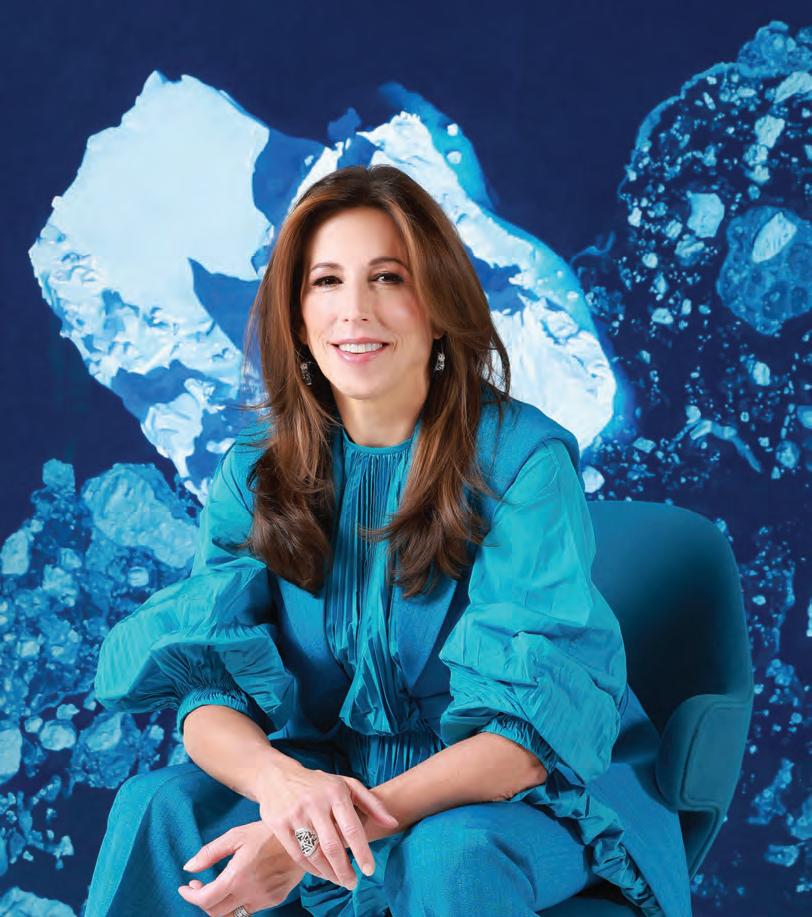
“This silly little card game called poker was the answer. For women to get comfortable taking risks, allocating capital, [and] strategizing, it could really change their whole approach to this idea of perfection.”
The other thing is, I will tell them to be selfish. But not in the traditional way of being selfish. You are a unique, independent, thinking human, and you have different ideas. The reason why Peak6 exists and has employed however many thousands of people over the years and accomplished what it’s accomplished is because I was there. Myself and my co-founder brought two totally different thought processes to the entity.
Do you have any advice for how people can trust that their opinions and ideas are valid and worth sharing?
If you think it’s valid, it’s valid. It actually doesn’t matter what other people think.
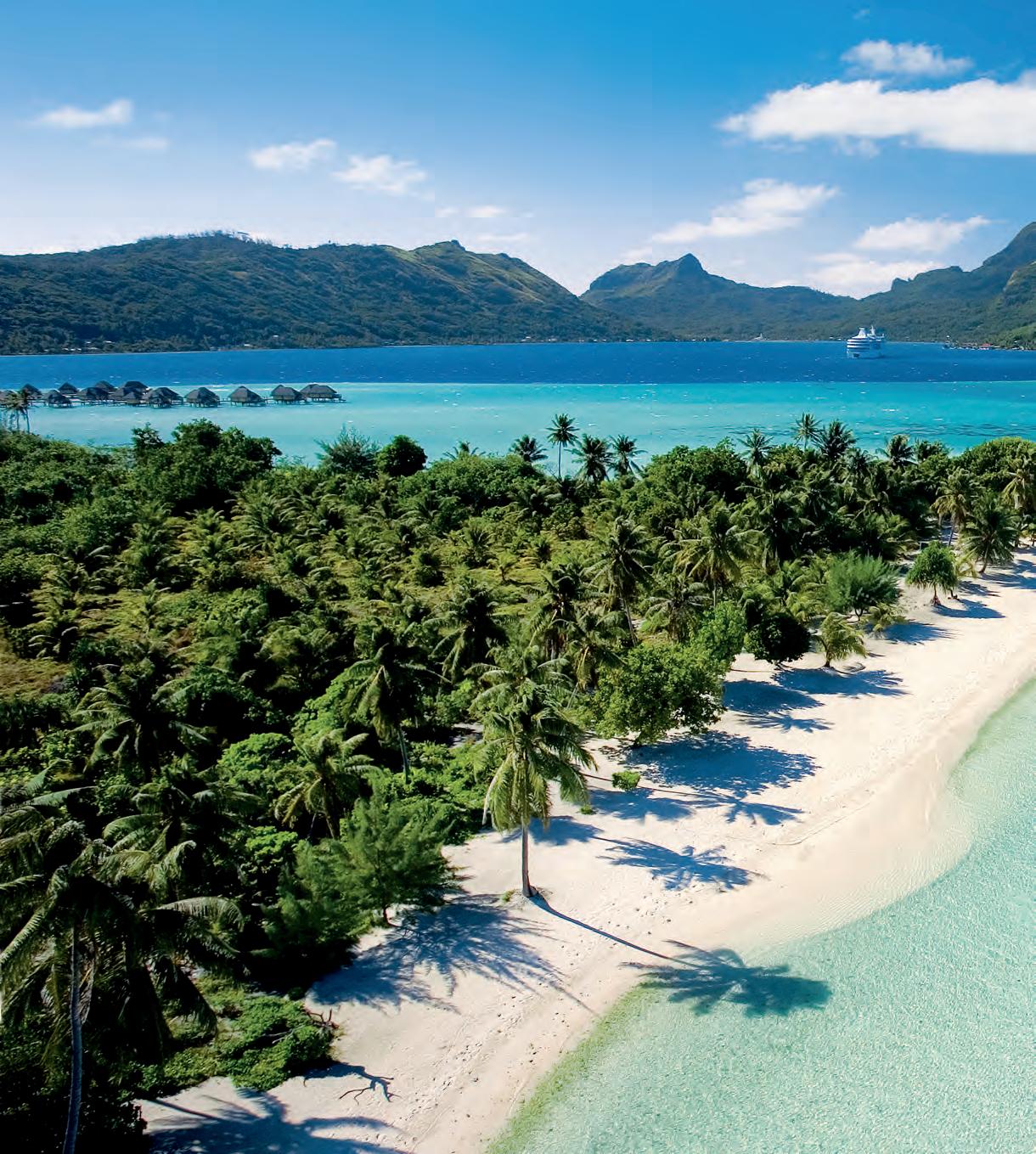
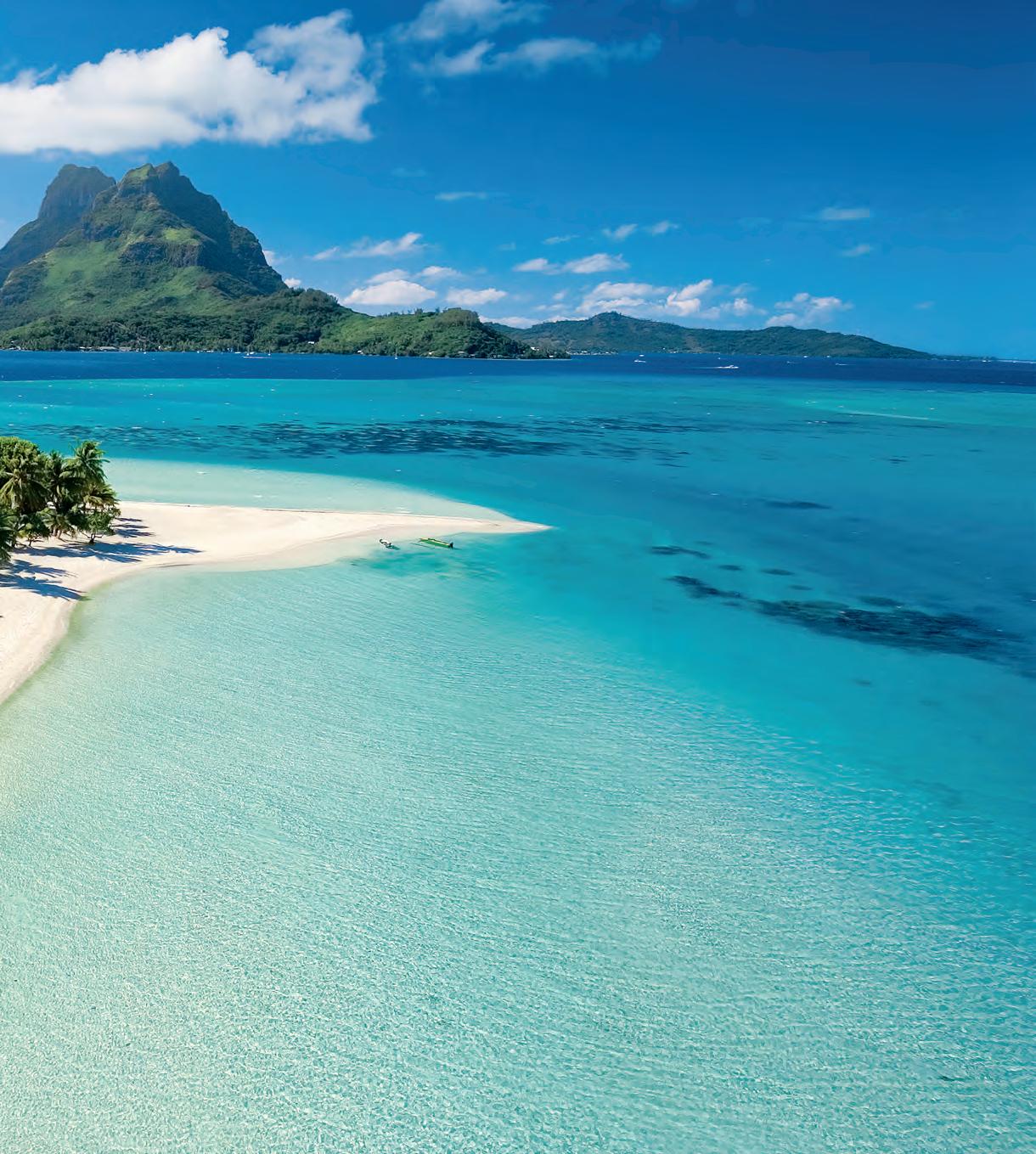
Whether it’s relaxation, connecting to nature, community service, or exploration, luxury travel—like everything else—follows trend cycles. This year, it was difficult to pin down exactly what we were seeing; the dots didn’t seem to connect. That is because classic values are so integrated, they become invisible. Privacy is a staple of luxury experiences (the velvet rope was created for a reason), but this year is different. It is not just about taking off on a private jet to a private island (although we walk you through how to do just that). This year, luxury travel demands true escapism. Whether you are looking to avoid the summer siege of European tourists by fleeing to the remote islands of French Polynesia (page 42), are looking for serenity while absorbing thousands of years of history and mythology in Crete (page 32), or perhaps are looking for a boozier adventure to a rainforest hideaway in Belize (page 48), we’ve got you covered. Plus, for more luxurious stays, check out our list of the Best New Hotels worldwide (page 52).
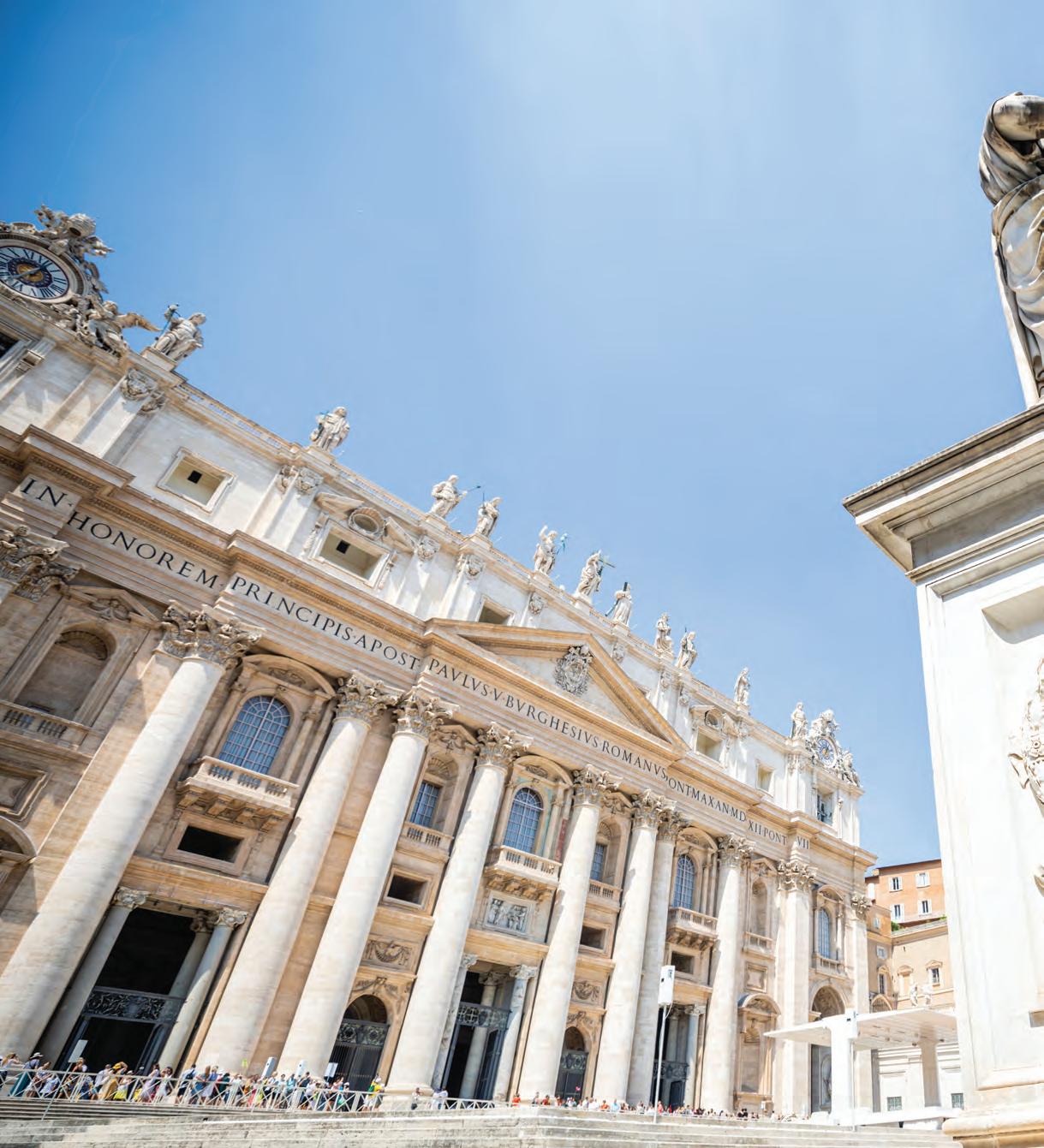
An Exploration of Rome and Crete Via Private Jet Takes You Back and Forth Through the Millennia.
BY DAN COSTA

Embarking on a journey with a group of strangers can be a challenge. This was my situation when I joined fellow travel writers for an exclusive tour of Rome and the Cretan countryside. After a delightful dinner of prawns, smoked salmon, sautéed dorado, and a generous amount of Mazzei Zisola Noto Rosso, I joked with my colleagues that the only unforgivable sin on a press trip was to make the group late for the next stop. Little did I know that I would be the one to commit this cardinal sin the next day when our guide, Kapi, called me at 8:30 am to say, “We are all waiting for you.”
Thinking our departure was at 9 a.m., not 8 a.m. I’d been awake for hours in my room checking email, oblivious to my fellow journalists waiting in the vans on the street just one floor below me. Roman traffic is never predictable; rush hour makes it worse. It was a long, uncomfortable ride to the airport. But as rude as my tardiness was, we were unlikely to miss our flight. We were flying private.
Abercrombie and Kent, our tour organizers, has a unique way of showcasing their Wings over the World Journeys. These tours utilize private jets to transport guests between destinations like London, Paris, Rome, and Athens. The convenience of private flights cannot be overstated, but what truly sets these tours apart are the local guides. They are the key to unlocking the hidden gems of each location. A good guide can transform a trip, and A&K has the best. Thanks to them, I could travel through ancient Roman and Minoan civilizations while indulging in some of the world’s best street food.
And if I did sleep in, the plane would wait.
Fortunately, I was more punctual for my commercial flight into Rome. At the airport, I was greeted by Kapi, an Abercrombie & Kent representative who stayed with us for the entire trip. The drive to Hotel de la Ville was easy, if not particularly swift. Rome has no freeways, and every street is a winding road. It’s best to sit back and enjoy the ride.
Perched atop the Spanish Steps, Hotel de la Ville blends historical grandeur and contemporary luxury. The central courtyard, which serves breakfast and lunch, and refined interiors provide a serene retreat from the bustling streets of Rome.
It is also worth stopping by the rooftop bar for great views of the Roman skyline and a playful cocktail menu. I opted for the Abbronzatissima, described by the hotel as: “Sunshine, Wild Turkey, Bourbon— and you’re already in pole position—fresh lemon juice, London Essense white peach, and jasmine soda. Libidine.” In Italian it means “very tanned,” but it could also be a reference to the 1963 single by Edoardo Vianello. Regardless, it was lovely.
Our first stop was a truly exclusive visit to San Lorenzo in Miranda, a site not open to the public. Originally constructed as the Temple of Antoninus and Faustina in 141 AD, it was a tribute to Emperor Antoninus Pius and his wife, Faustina. The temple underwent a transformation during the Middle Ages, around the 7th century when it was converted into the Church of San Lorenzo in Miranda. Over the years, it evolved into a hub for medicinal practices and the apothecary arts, reflecting the medieval and Renaissance periods’ reliance on herbal medicine. Today, it is a treasure trove of beautifully crafted glass and ceramic bottles that store essential oils, tinctures, and extracts derived from rosemary, sage, and lavender. The jar of “merucio ossido giallo” was marketed “veleno” with a skull and crossbones.
This evolution of San Lorenzo is part of a broader trend in which many ancient Roman structures were repurposed for Christian worship, turned into storehouses of natural knowledge, and are now used as tourist attractions.
San Lorenzo sits at the edge of the Forum, the epicenter of Roman public life. The forum hosted triumphal processions, elections, public speeches, criminal trials, and gladiatorial matches. The Forum dates back to around the 7th century BC and continued to be used until the 4th century AD. The area subsequently fell into disrepair, becoming a pasture known as the “Campo Vaccino” (Cow Field) during the Middle Ages.
Excavations at the Roman Forum began in earnest in the early 19th century, driven by a thriving market for relics from classical antiquity. The Italian archaeologist, Carlo Fea, led the first efforts to clear the area in 1803. However, it wasn’t until the unification of Italy and the subsequent establishment of Rome as the capital in 1870 that more systematic and state-sponsored excavations were initiated.
Excavations in the Forum have revealed layers of history; for example, the San Lorenzo on the Miranda floor sits five meters above the floor of the Roman Forum, all of which have been excavated. These archaeological efforts often spark controversy, particularly when intersecting modern infrastructure projects. The construction of the new metro line near the Forum has faced significant delays due to the discovery of ancient artifacts and structures. When I asked our local guide, Eva, when the project would be completed, she just laughed.
The quest to uncover the Roman Forum’s secrets has not been without its losses. Early excavators often removed or destroyed layers of history in their eagerness to reach the most ancient remains. Medieval and Renaissance structures that had developed on top of the ancient ruins were often demolished to get to the more ancient relics, erasing centuries of historical layers. For instance, the 16th-century church of Santa Maria Liberatrice was demolished in 1900 to reveal the ancient church of Santa Maria Antiqua beneath it.
Today, the Roman Forum is an open-air museum with ongoing excavations and restoration efforts to preserve its history. Modern archaeologists use advanced technologies such as ground-penetrating radar and 3D modeling to explore the site with minimal disturbance. These efforts are helping to uncover new insights while preserving the delicate balance of the historical layers.
The following morning began with an exclusive tour of Castel Sant’Angelo. Originally designed as Emperor Hadrian’s grand tomb, the massive stone rotunda grew to become the fortress from which popes defended the city. Although Sant’Angelo served as an escape room for popes in times of invasion, the papal apartments are quite grand, featuring the best art of every age. As one of the most secure buildings in the city, it was also used to hold the Vatican’s treasury.
Abercrombie & Kent can sometimes arrange access to the secret passages connecting the castle to the Vatican, but the gates were sealed on our trip. Nevertheless, the Castello’s roof offers some of the best views of St. Peter’s Basilica and the Tiber River in Rome. It is a great place to snap photos and get a feel for the city’s layout.


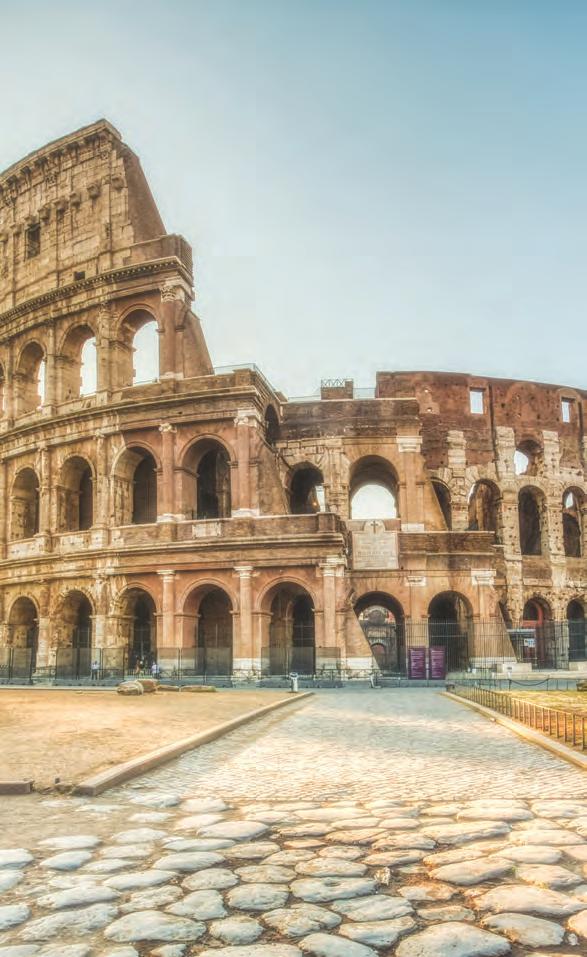

After immersing ourselves in Rome’s ancient splendors, we ventured into Trastevere, one of the city’s most charming and vibrant neighborhoods, for a culinary journey like no other. Our guides, Toni and Walter from culinary tour company Eating Europe, introduced us to the unique food culture of Rome with their extensive knowledge and passion for local cuisine. Like all the best guides, they brought us to attractions we would never have been able to find on our own.
Our first stop was at La Norcineria di Iacozzilli, a haven for meat lovers. We learned the nuanced differences between Parmigiano Reggiano and pecorino romano, two of Italy’s most beloved cheeses. But the highlight was undoubtedly the porchetta—succulent, slow-roasted pork seasoned with aromatic herbs. Roasted daily in a small town outside Rome, it was soft, fatty, salty, and perfect. It is cliché to say this dish was “the best thing I have tasted,” but my mouth waters every time I edit these words. I was reaching for a second slice when a local Nonna scolded us in Italian for taking up all the sidewalk space on the narrow street in front of the shop. One perfect bite would have to suffice.
Leaving the cozy confines of La Norcineria, we crossed the Tiber River and arrived at Campo de Fiori, Rome’s most famous open-air market. It buzzed with activity, a vibrant tapestry of colors, smells, and sounds. La Norcineria was like a farmers market anywhere in the world but loaded with Italian staples—eggplant, artichokes, and, of course, tomatoes. After the meatiness of the porchetta, a few bites of Caprese salad with local tomatoes, buffalo mozzarella, and basil was the perfect palate cleanser.
From there, we headed a few blocks to the Ristorante di Pancrazio, where we were led to the basement and handed an apron. In addition to being travel guides, Toni and Walter were chefs who helped us make homemade ravioli filled with lemon-scented ricotta and tagliatelle all’amatriciana. The best way to appreciate a place’s food is to eat it, but making it yourself gets your hands dirty.
I was so focused on kneading and rolling pasta that I almost forgot to look up and see the past. The Ristorante di Pancrazio was built on the ruins of the Theater of Pompey, a venue built entirely of marble that could hold more than 20,000 spectators. Perhaps most infamously, this was the theater where Brutus and Cassius assassinated Julius Caesar. Walking down the steps to the basement, we stepped back to 55 BC. I can’t say why, but it made our pasta taste better.
I flew from Rome to Heraklion on a private plane, and as we arrived at the executive terminal at Rome’s Ciampino Airport, it didn’t feel like we were late. The plane would leave when we were ready. We breezed through security as our luggage was loaded onto the plane. We sat, gave a thumbs-up, and rolled down the tarmac in minutes. I have heard mixed things about safety protocols on private flights, but both times I have flown private, we took off without formal safety briefings. Just get on and go.
The plane itself was everything you would expect in a private jet. The Bombardier Challenger 850 has a range of approximately 2,800 miles and seats 14 passengers in its VIP configuration. To give you a sense of size, the 850 is based on the Bombardier CRJ-200 regional jet that can seat 50. You will have room to stretch out.
Approaching Crete by plane can be bumpy, at least when the south winds are blowing, and they were blowing hard when we arrived. Known as the “Livas” or “Sirocco,” these warm winds from the Sahara Desert can raise temperatures significantly and often carry dust and sand from North Africa. The Livas typically occur in the spring and autumn, influencing the island’s climate and occasionally causing discomfort due to their dryness and heat.
Although merely curious to tourists like me, Cretan natives took the South Winds very seriously. My visit was at the first blush of spring; all the olive trees were starting to bloom. A long, harsh south wind can disrupt the bloom and damage the leaves and fruit. The results can be catastrophic. During the 2013-2014 season, for example, crop yields dropped from 100,000 tons to less than 40,000 tons. The crash crushed many local producers.
The winds died off after a day, but I had to wash the sand off my contacts that first night.
Though only three miles from the center of Heraklion, the Palace of Knossos feels like the middle of nowhere. A few homes and trinket shops in the small valley are all you see when you park. “Is the Palace really near here?” asked one member of our party. Indeed it was, but think more palace ruins than Palace. This isn’t the Renaissance or ancient Rome; we were exploring a civilization that existed two thousand years before Christ. A people more myth than memory.
It was the myth I was most interested in. I grew up on Greek mythology. Theseus used a thread to navigate the Labyrinth and slay the half-man, half-bull beast, which seemed to be the height of cleverness and heroism for my 10-year-old self. And now, a few millennia later, I would get the chance to walk those same tunnels.

Or on top of them, as it turns out. They no longer let tourists in the maze, although our guide, Kapi, has brought people there and even gotten lost. Nonetheless, the Palace is amazing. At this point, the structure combines ruins and recreations that replicate the colors and art of the time. At its peak, the palace was the home of up to 1,500 residents, with an even larger community around the building to support it.
While I did not see a Minotaur, I did see the Bull-Leaping Fresco, one of the most iconic and well-preserved pieces of Minoan art. It depicts a ceremony in which men and women leap over the back of a charging bull.
I also discovered what is undoubtedly one of many controversies about the inventor of the flushable toilet. Conventional wisdom holds that it was invented by Sir John Harington, an English courtier, and godson of Queen Elizabeth I, who devised a flushing toilet system in 1596. Indeed, this design persists today in most forms.

But maybe the Minoans got there first? They used a series of aqueducts and cisterns to channel fresh water into the more luxurious parts of the palace. The palace also included toilets that led to a gravity-driven system of terracotta pipes that would channel waste away from living quarters to a cesspit outside the residence. This knowledge was lost to time. It would be thousands of years before the English flushed their first loo.
Today, the real palace on Crete is Daios Cove, the resort. Nestled in a private bay on the northeast coast of Crete, near the town of Agios Nikolaos, Daios Cove offers breathtaking views of the Aegean Sea from nearly all of its 290 villas. In 2022, it elevated its status with the unveiling of Kēpos by Goco, a 27,00-square-foot wellness sanctuary that merges holistic healing with advanced medical technology.
Daios Cove founder Dimitris Daios and GOCO Hospitality CEO Ingo Schweder created Kēpos by Goco after Schweder’s cancer diagnosis led him to blend Western medicine with holistic treatments. They spent four years developing this innovative wellness center, sensing the rising demand for health-focused travel. Today, Kēpos features a resident doctor and a team of skilled therapists offering treatments from cryotherapy and hyperbaric oxygen therapy to epigenetic analysis, establishing it as a cutting-edge wellness destination.
My stay at Daios Cove was short, and I didn’t partake in any of these treatments, but I ate and drank very well. Taverna serves traditional Greek dishes with fresh, local ingredients, while Ocean Restaurant provides a Mediterranean fine dining experience. The Pangea buffet restaurant offers international cuisine with a variety of options for breakfast and dinner.


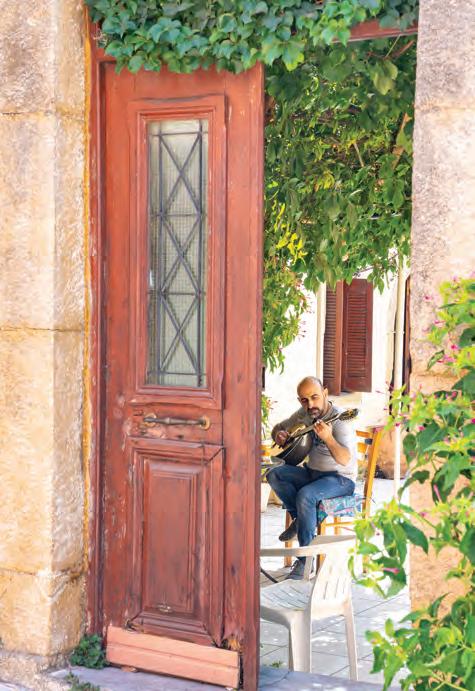
The cocktail menu is curated by the Athens-based masters, The Clumsies, who take inspiration from the Cretan terroir. As I would soon learn, Crete is rich with herbs, and many of them find their way into the cocktail menu. The classic option is the “Summer in Crete,” a blend of rum, locally grown sage, lemongrass, pineapple, and Salicornia, a local flowering succulant. Of course, finishing with raki, a local spirit that tastes like a softer, sweeter version of grappa, is always polite.
The next morning, an exhilarating off-road safari awaited. It was called a JeepTour, much to the dismay of Geoff, our driver and guide, as the vehicles were, in fact, Landrover Defenders. The road was bumpy, as any safari should be. As we climbed, we drove through the island’s largest forest towards mountains soaring nearly 5,000 feet above sea level. Ski competitions are held on the hill during the winter.
We drove along winding dirt roads framed by ancient olive trees and fragrant wild herbs, which led us deeper into a world that felt lost in
another era. We spotted old shepherds tending a flock of goats, but mostly, we saw goats doing whatever they wanted. We watched women collecting Horta, the wild greens that are a staple of Cretan cuisine. Whenever we stopped, we could hear the gentle tinkling of bells as goats moved leisurely across the hillside, nibbling at the lush greenery. We saw two other cars the entire morning we spent in the hills. It was a scene reminiscent of the turn of the century—any century.
We stopped at a rustic hillside taverna for lunch. The table was set with fresh tomatoes, cucumbers, and olives, drizzled with robust olive oil. Then came slow-roasted lamb seasoned with aromatic herbs including garlic, oregano, and thyme. Complementing the lamb is a selection of local cheeses, such as graviera and mizithra, which offer a range of textures from creamy to crumbly. And, of course, we had a hearty serving of Horta sautéed with garlic and lemon. Is it too early for a raki to conclude? It would be rude to refuse.
As our off-road safari drew to a close, we stood in a grove of ancient olive trees, their gnarled trunks and silvery leaves whispering secrets of the ages. To call it a grove is a bit of a misnomer. The entire island of Crete is a grove of olive trees; they cover the landside like a farm. Crete has an estimated 30 million olive trees—nearly 50 for every person who lives on the island. Almost every tree is a human-constructed graft.
Although the roots of all of these olive trees are native, they have been grafted to imported scions, basically young shoots or twigs. The native variety often used for rootstock is the wild olive tree, known as “aurelia” or “oleaster” (Olea europaea). The grafted variety that produces edible fruit is typically the “Koroneiki” olive, renowned for its high-quality oil.
And the trees simply don’t die. Although some locals told me they now needed to irrigate because of climate change, irrigation is only required if the tree is to produce fruit. Indeed, even if the dreadful south winds disrupt the pollination cycle of the crop, the olive trees will survive. They just wait.
After a week of racing from modern luxury and ancient ruins and back, the olive tree seems like a thread that stretches among them all. The foundation product of the Minoan civilization was also served at every meal I had. There are living trees on Crete that were blooming as Caesar bled out in the Theater of Pompeii. They bore silent witnesses to everything I saw on this journey. I wanted more time.
But I had a plane back to New York to catch. And this time, the plane would not wait.
BY DAN COSTA
As a young man, Geoffrey Kent took a solo motorcycle journey from Nairobi to Cape Town, a 5,000-mile trek across treacherous terrain and through unpredictable weather. This audacious adventure, undertaken at just 16 years old, was a sign of things to come.
Now 81, Kent has established himself as the visionary founder and chairman emeritus of Abercrombie & Kent (A&K), a company pushing luxury travel’s boundaries since 1962. Born into the adventurous backdrop of the Aberdare Highlands in Kenya, Kent’s early life was steeped in exploration and discovery. His innovative approach to safaris, transforming them from traditional hunts into photographic adventures, set a new standard in the industry.
In this exclusive interview, Kent reflects on the evolution of luxury travel, emphasizing the shift from opulence to meaningful, transformative experiences. He shares insights on how Abercrombie & Kent has adapted to these changes, focusing on experiential travel, eco-conscious lodging, and philanthropy. Kent also discusses the power of travel to foster personal growth and cultural understanding, recounting stories of how travel has transformed lives, including his own.
Abercrombie & Kent has been a leader in luxury travel for decades. What sets your company apart from other luxury travel providers?
What sets A&K apart is our unparalleled expertise and extensive global network, which we have developed over 60 years. Our on-the-ground presence with more than 55 offices in over 30 countries allows us to offer insider access, exceptional service, and meticulous attention to detail. We don’t just show destinations. We create immersive, transformative travel experiences tailored to each guest’s interests and desires.
Reflecting on Abercrombie & Kent’s journey, how have you witnessed the evolution of luxury travel since the company’s inception, and how has the company adapted to these changes?
In 1962, I founded Abercrombie & Kent to offer a new kind of travel experience—adventure by day and luxury by night. I wanted to create both comfortable and highly experiential journeys, taking travelers off the beaten path to discover the world’s most incredible destinations. That hasn’t changed. That vision has only grown to showcase more of what our beautiful world offers by leveraging our local connections to provide exclusive, behindthe-scenes access you can’t get elsewhere and focusing on philanthropy. What began in Africa over 60 years ago has evolved into an operation with the same level of touch, service, and intimacy with nature, but offered across all seven continents—via land, sea, and even flight with our Private Jet and Wings Over the World itineraries. Luxury travel has evolved from simply seeking opulent accommodations to craving authentic, meaningful experiences. Travelers now want to connect with destinations and make a deep positive impact. A&K has adapted by focusing on experiential travel, eco-conscious lodging, philanthropy, and leveraging our local connections to offer exclusive, behind-the-scenes access you can’t get elsewhere. These elements have always been pillars of what we do, and these threads remain woven through the fabric of the company still today.
From your experiences, how have you seen travel contribute to personal growth and transformation?
Travel has changed dramatically over the past six decades, but one thing that hasn’t changed is the transformative power of experiencing new cultures and environments. Travel uniquely connects us with the world’s most precious cultural and natural treasures and inspires us to become better global citizens. My travels have taken me to some of the world’s most remote and fascinating destinations, from the Serengeti to the Arctic, and each journey has shaped my worldview in profound ways. I’ve learned that despite our differences, people worldwide share common hopes, dreams, and values. Travel has the power to break down barriers and foster understanding and empathy.
Over the years, I’ve heard countless stories from guests about how travel has transformed their lives. One that stands out is a couple who took their first A&K trip to East Africa for their honeymoon. They were so inspired by the experience that they decided to quit their jobs and start a non-profit organization dedicated to supporting conservation efforts in the region. Stories like these remind me of the incredible power of travel to change lives and make a difference in the world.
What is the biggest mistake people make when they travel?
The biggest mistake is over-scheduling and not allowing enough time to discover a destination spontaneously. While having a thoughtful plan is good, leave room for serendipity and getting off the beaten path. Those unscripted moments often become the most cherished memories. Also, not being present—don’t view your whole trip through a camera lens! As much as I love sharing my travels on Instagram (@geoffrey_kent), I make it a point to put my phone away and be in the moment, especially with my family.
How does Abercrombie & Kent incorporate sustainable and responsible tourism practices into its travel experiences?
Responsible tourism is at the core of A&K’s operations. We support conservation efforts, partner with eco-conscious properties, and educate guests on positively impactful tourism practices. Through Abercrombie & Kent Philanthropy, we partner with 55 local organizations across all seven continents to fund education, healthcare, and community development projects in the places we visit. It’s our way
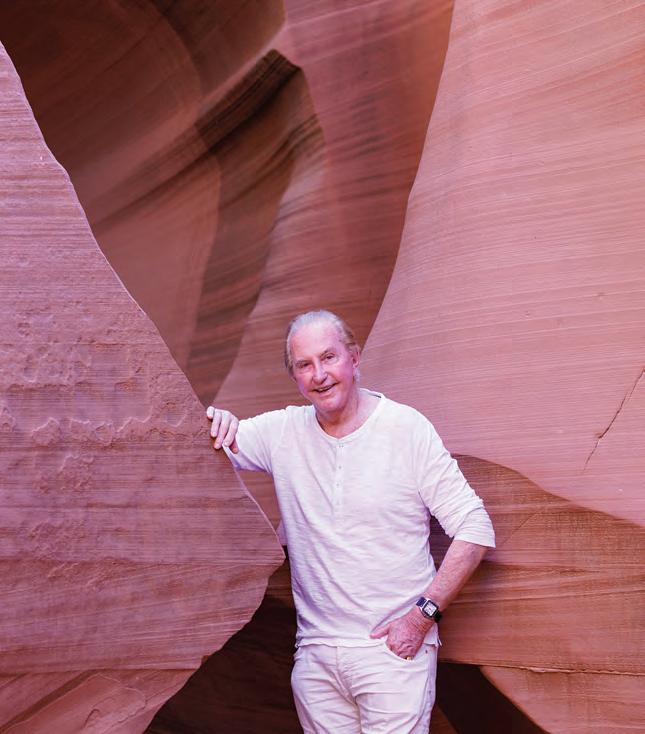
of ensuring that the benefits of tourism are shared with the people who call these destinations home. I believe that travel will continue to be a force for positive change in the world, and I’m honored to be a part of that journey.
Abercrombie & Kent is known for its philanthropic efforts. Can you highlight some of the key initiatives you’re most proud of and their impact on local communities?
I’m incredibly proud of our work with local communities, particularly in education, healthcare, and enterprise. For example, we’ve built schools in rural Cambodia, supported women’s empowerment programs in India, and built an entire hospital, nursing school, and maternity unit in Uganda. By uplifting communities, we create a ripple effect of positive change and more meaningful travel experiences.
What new trends do you see in luxury travel?
I foresee further emphasis on purposeful, transformative travel. Luxury will be less about thread count and more about authentic connection, access, and impact. We’ll see more far-flung, bucket-list trips post-pandemic. Sustainability and wellness will also be key—luxury is now aligned with personal values and self-care.
Journey through the unspoiled beauty of French Polynesia, where lush jungles and vibrant coral reefs beckon nature-loving explorers.
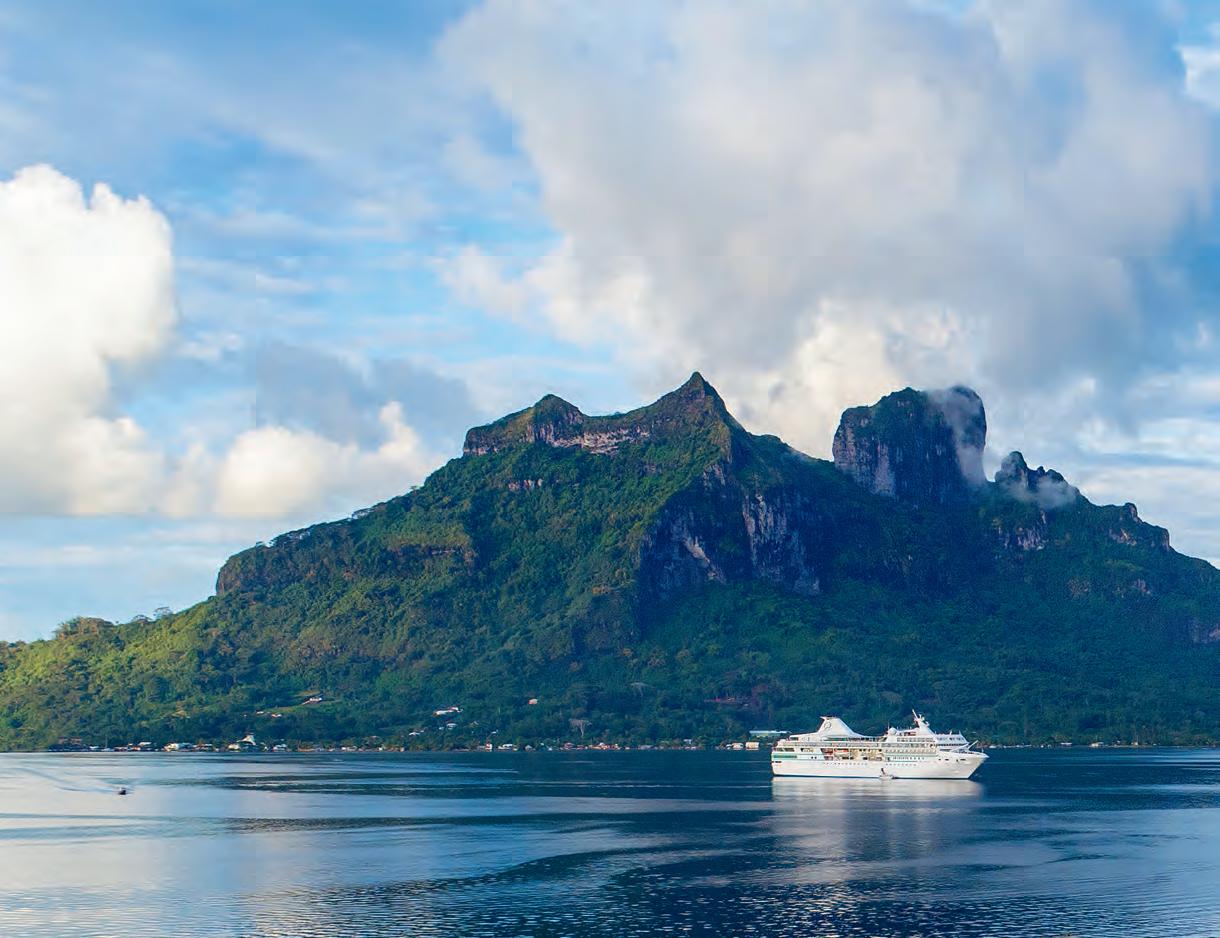
BY DEBORAH GRAYSON AND JONATHAN RUSSO
Over-tourism is increasingly acknowledged as an ecological crisis. In the summer, much of Europe and places as seemingly far-flung as Machu Picchu feel they are under siege. With its approximately 20,000,000 annual visitors, Venice recently instituted a tourist tax to compensate for the environmental degradation that the swarms bring.
French Polynesia is not that.
The five archipelagos traverse 2,000,000 sq miles of ocean in the middle of the Pacific, the world’s largest body of water. Widely scattered islands (118 of them) cover less than 1% of the Pacific Ocean’s surface. In 2023, there were only 261,000 tourists.
Having fought crowds in Seville in February, which used to be an “off” month, we were delighted to find our small ship, a 330-passenger Paul Gauguin, the only cruise in all but one harbor. Among our stops were the iconic paradises of Bora Bora and Tahiti. Privately experiencing their harbors, vistas, and landings made the moments feel uniquely special and inspiring.
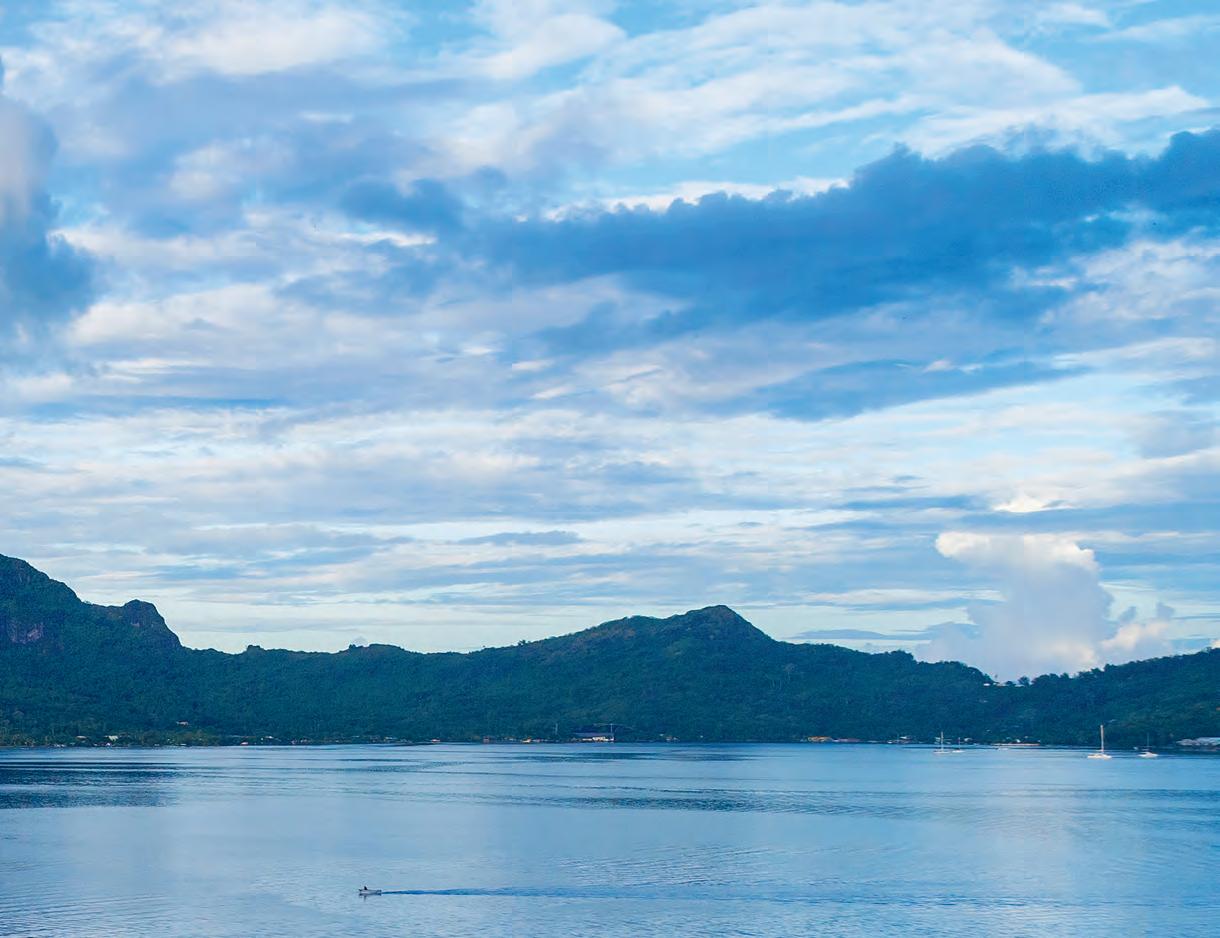
Unless you live on the West Coast, where nonstop flights are available, the time and expense to get here from the U.S. are the only impediments to profound rewards.
Having been formed by volcanic eruptions pushing their way through shifting underwater tectonic plates millions of years ago, the islands follow a geological “formula.” Each chain is almost straight (as the plates progressed, in assembly-line fashion under the volcanic source). The result is mountainous, inaccessible, jagged, cloud-shrouded interiors encircled by narrow ribbons of flat land. The “ribbons” contain each island’s road, housing, and businesses. Sadly, this geologic happenstance precludes more than a few small, sandy beaches, making it our one disappointment with the trip. Some islands, like the Polynesian spiritual center Raiatea, don’t have any sandy entry points.
The dense vegetation is daunting; unless cleared, the jungle proves impenetrable, with undergrowth, overgrowth, and growth in between. Parking the car at a random spot means finding yourself next to a mango, papaya, or banana tree, a fact our rental car agents warned us about, adding that coverage from falling coconut damage was an additional expense.
The waters around French Polynesia are home to 21 shark species and a reef system supporting 176 coral and 1,024 fish species. Visiting one of the islands means leaving the vast, cobalt-blue ocean via a gap in the barrier reef, locatable by the absence of a ridge of white-foamed breaking waves. Once inside, the water changes dramatically to a vivid turquoise. When they can enter at all, boats must weave their way through serpentine, natural channels, surrounded by ominous black coral-head outcroppings that are, thankfully, well-marked.
Observing Captain Michel Quioc give instructions from the ship’s bridge as we entered the lagoon surrounding Moorea, we understood that a single compass degree made a difference. He explained, “These breaks in the reef are convoluted because they were carved over millennia by rivers flowing from the volcanic mountains.”
The underwater world is infinitely more accessible than the mountainous one. During a single snorkeling excursion in Bora Bora’s nature-docworthy, clear water lagoon, we saw 20 eagle rays relaxing on the bottom. The rays appeared close, even though the water was 40 feet deep. We also encountered a female manta ray with a 12-foot wingspan, slowly swimming back and forth while receiving her daily cleaning by wrasse fish. An area known as “the aquarium” was inhabited by an overwhelming number of colorfully diverse fish. Finally, the most remarkable sight of all: a “coral garden.” Seeing such a diversely shaped, textured, sized, and colored assortment of inhabitants, all eight of us on the swim agreed it was more than enough reason to have traveled thousands of miles to witness this magic.
Memorable underwater sights are everywhere. On our first swim, in Huahine, there was bright purple coral just feet from a public beach, and in Raiatea, on an unplanned swim next to a commercial marina, we shared the water with yellow and white striped angelfish. Swimming in the shallows of a motu (island) near Taha’a, we spotted sand dabs that almost let us touch them before burying themselves.
Due to global warming, the water, which should range from 74-82 degrees, averaged about 84 dregrees, requiring no acclimation when entering or leaving it. We imagined ourselves as aquatic mammals, equally comfortable in the wet environment as on land.
Over the last few years, the French Polynesian government has instituted policies reflecting their concern for ocean conservation. They’ve eliminated foreign fishing fleets, net trawling, and long-line fishing. Additionally, 95% of the catch must remain in French Polynesia because seafood is an inexpensive mainstay of the local diet.
For centuries, Westerners have fallen in love with the romance of a ukulele-playing, lei-clad, welcoming people. Historically, ship-wrecked sailors, taken with the beauty and the culture of Polynesia, have chosen to remake their lives on these islands. This remains true today. Throughout our almost three-week visit, we met numerous ex-pats who embraced the Polynesian lifestyle, often marrying a local and remaining to raise their families.
Unlike Hawaii, where most of the land is owned by newcomers, biologist Dr. Michael Poole, an American who lives on Moorea, told us that locals retain 85% of the land. And, although French is taught in school, people converse in Polynesian. The culture feels intact. Many women wear hair flowers, and not for a tourist photo-op. Flowing, floral-printed garments are seen everywhere. Children learn tra-
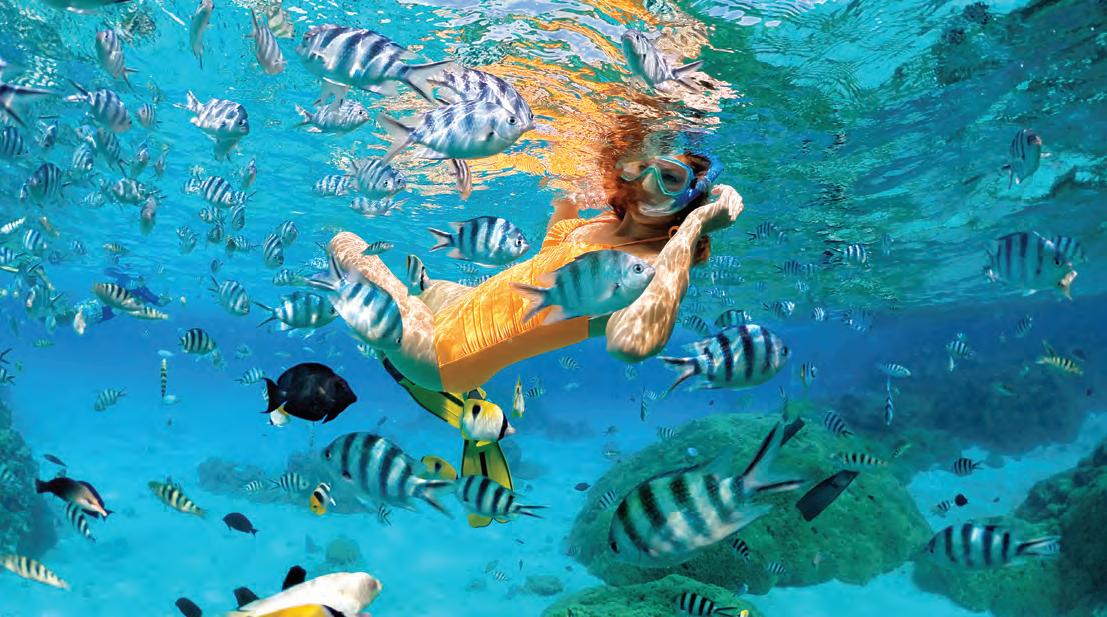
We were aloft in The Brando’s private plane for fifteen minutes, flying over French Polynesia’s unique cobalt blue water, when we spotted an oasis of pale jade and turquoise in the distance. It had to be Tetiaroa, an archipelago of 12 motus (islands) 30 miles from Tahiti. It’s a captivating sight. No wonder a smitten Marlon Brando knew he had to buy it.
Brando’s legacy of authenticity and sense of place are hallmarks of one of the world’s most unique and completely private resorts. It’s where Barack Obama spent a month writing his memoir, and A-list celebrities often reside.
What makes the Brando unique is not the world-class villas, the award-winning food, the 1:3 guest-to-staff ratio, or the amenities like the sybaritic wellness center located at the spiritual epicenter on a lily-pad-surrounded island or the green mission. It’s the fact that The Brando facilitates the Tetiaroa Society’s extensive agenda of habitat restoration, reef preservation, biological research, education, and cultural preservation. They collaborate closely with the Nature Conservancy.
Sixty percent of Tetiaroa Society’s operating budget comes from The Brando—the remainder from grants and donations. For example, impressed by the Society’s mission, Johnny Depp recently made a $200,000 contribution.
Brando owner and Polynesian multi-hotel developer Richard Bailey told Worth, “My goal is for the guests to discover the island because it’s a natural history treasure, both in and out of the water.”
ditional dances and practice for months for interisland competitions. We even watched an outrigger race one day from our boat.
Paul Gauguin embraces this by having six Polynesian performers travel with the boat. Along with providing entertainment, they give classes in ukulele playing, otea-haka dance, pareo tying, language, lei making, shell and seed jewelry, and hair picks.
According to an on-board “enrichment lecture” from noted archeologist Mark Eddowes, Polynesian genius exhibited itself in discovery and navigation. Without the help of a written language or metals, they explored the vast waters in sailing outriggers and “discovered” New Zealand and Hawaii. Using the stars, winds, waterborne markers, and currents, their world expanded to include islands thousands of miles away, primarily for trading and new population settlements.
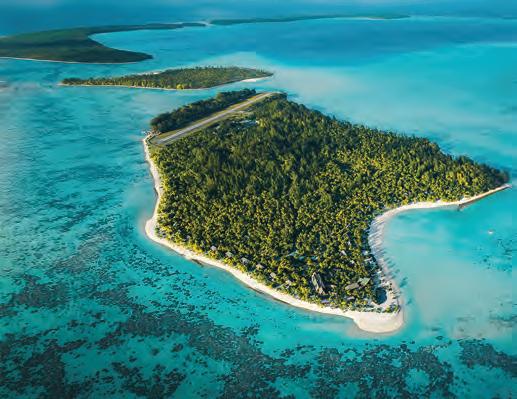
Millennia before Marlon chose Tetiaroa, the atoll was the meeting ground for Polynesian royalty. We heard they came from thousands of miles away to arrange marriages, settle tribal feuds, and restore themselves at the sacred site. Another likely scenario is that it was the “Hamptons” of nearby Tahiti, a place of beauty to relax and have fun. Either way, it was ideal and has archeological remains to prove it.
Guests can sign up for tours of the lagoon and islands (we saw bright orange coconut crabs on one), cultural immersions, and bird watching. We were offered a 6:00 am wake-up call if hatching turtles were spotted.
The resort operates advanced energy-saving systems. We toured its SWAC (saltwater air conditioning) plant, where cold water from great ocean depths cools fresh water that air-conditions the entire complex. Polynesia’s largest solar array provides most of The Brando's electricity needs.
Sylvia Earle, Jacques Cousteau’s heir apparent, has named Tetiaroa one of her Mission Blue Hope Spots, meaning it’s a place where people can live in harmony with nature.
Richard is extremely pleased with this and other positive feedback his project has received, saying, “My hope is to offer guests the chance to have an exquisite and ethical vacation.”
Traveling between islands in Polynesia is typical, with planes, ferries, and charter boats serving all the major ones. However, the tourist infrastructure leaves much to be desired. While Bora Bora offers luxurious over-water cottages from top-shelf hotels, many other islands depend on small pensions and a handful of lackluster vacation rentals. Raiatea, for example, boasts a UNESCO sacred archeological site but lacks notable restaurants or hotels.
Chartering a catamaran is an option for sailors, with leading companies having bases here. However, with speeds averaging 7 knots/hour, exploring more than a few islands would take weeks. Given the vast distances, island approaches through treacherous reefs can be tricky. On land, cars are a necessity to explore beyond tiny towns.
If sailing isn’t your forte, aligning your schedule with interisland ferries or planes presents challenges,
as they don’t run daily. A local businessman shared that even simple items like nails or screws can take up to two weeks to arrive. He counseled “patience.”
For us, small cruise ships are the ideal way to see Polynesia. A boat this size has amenities (spa and gym), activities (diving, snorkeling, and numerous land-based excursions), lectures, and infinite culinary selections (the executive chef told us he’d developed 2,000 recipes that range from vegan to steak with foie gras). Yet, it is small enough to thread through the reefs for inner-harbor anchorage.
Following the cruise, we had a few land-based nights in Moorea and discovered another plus for life asea. No matter the wind direction, there is always a breeze on a boat, so it doesn’t matter whether the boat is on the windward or leeward side of an island. Also, the ceaselessly astonishing, iconic Polynesian views are front and center from every deck.
On land, however, half the island is on the windless, stiflingly hot, and humid leeward side. Also, from land, you’re likely to have a view of the water, missing out on the towering, cloud-covered volcanic peaks, one of the primary reasons to be here.
Our ship was purpose-built with a shallow draft for these waters. Other cruise lines seasonally move their fleet to varying international locations. This boat stays in Polynesia.
Launched in 1997, it resembles a mid-century ocean liner in many ways, feeling like a large yacht, not a Disney or Carnival Cruise boat. The cabins have ship-wright-quality mahogany cabi-
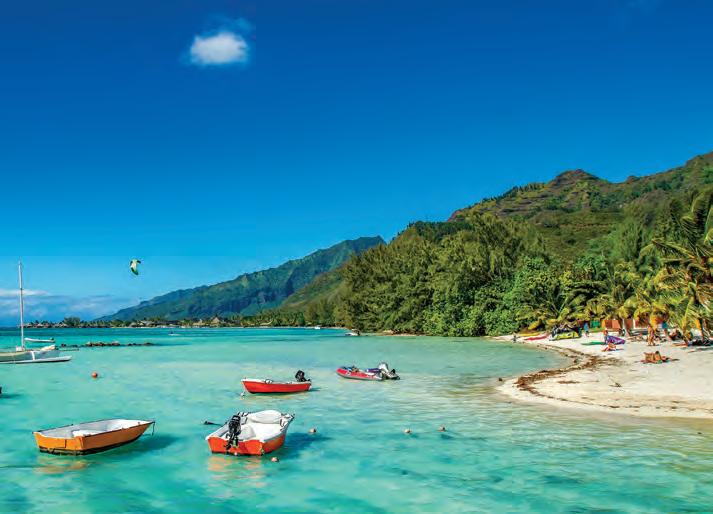
netry. Some of the graceful wooden deck chairs are reminiscent of sea voyages past. (The crew knows the lost art of varnishing.) Rather than anodyne, tropical graphics, passageways, and cabins are decorated with beautifully framed, historically evocative Polynesian lithographs.
What’s the first thing people discuss when reviewing the highlights of their cruise? Probably the nearly ever-present food and drink. Like on all cruise ships, there’s an overabundance of choices, magnified by the fact that executive chef Paul Elias has to satisfy French (foie gras please), American (beef!), and a variety of other palates, as well as people with dietary restrictions. However, his CIA training, time as the Kennedy’s private chef, 11 years with Paul Gauguin, and 35 well-trained long-time staff enable him to make all this food prep appear easy. When possible, he sources locally. Almost all the fish are sustainably caught in nearby waters and served fresh. Ninety percent of everything is made from scratch, even the multi-layered Middle Eastern dessert baklava, which requires time, skill, and patience. One day, chef Elias gave the passengers an impromptu demonstration of how to filet an enormous moonfish, destined to feed 70 people that night.
As opposed to more-formal cruises, the atmosphere is casual. It encompasses not only the dress code—flip flops allowed everywhere except two of the three dining rooms at dinner—but the banter and comfort level passengers have with the crew, many having worked for Paul Gauguin for more than a decade, enhance the experience that French Polynesia is a relaxed, welcoming place. Especially helpful are the onboard excursion directors, all Polynesianians who had lived on the islands we visited. They provided inside info on what to see and do.
Paul Gauguin has an extensive dive program with four certified onboard instructors, making them one of the few that doesn’t contract out to local dive companies. They believe the continuity of instructors ensures safety and learning. Depending on the itinerary, 5-10% of the passengers are on board to dive. When in port, the ship’s stern transforms into “the marina” with multiple dive boats and all the required scuba gear. Lessons are given to pool-trained beginners. Turtles, sharks, dolphins, manta rays, and shear reef cliffs are the sighting goals.
In our nearly three weeks there, we had several transformative experiences prompted by the stunning, natural beauty of the sky, land, water, and underwater world. You would have to be a jaded, calloused soul not to respond to Polynesia. However, unlike ship-wrecked sailors, Gauguin (the painter for whom our boat is named), and the many ex-pats we met, we couldn’t remake our lives on these islands. But we understand why they did.















#1 EVENT TO ATTEND DURING SUPER BOWL

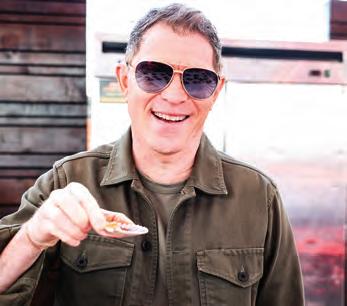









Celebrity chefs amazing food player appearances



PARTNER WITH BULLSEYE EVENT GROUP
SPONSORSHIP OPPORTUNITIES | PRIVATE CABANAS | CORPORATE PACKAGES, EXCLUSIVE EXPERIENCES & PREMIUM GAME TICKETS
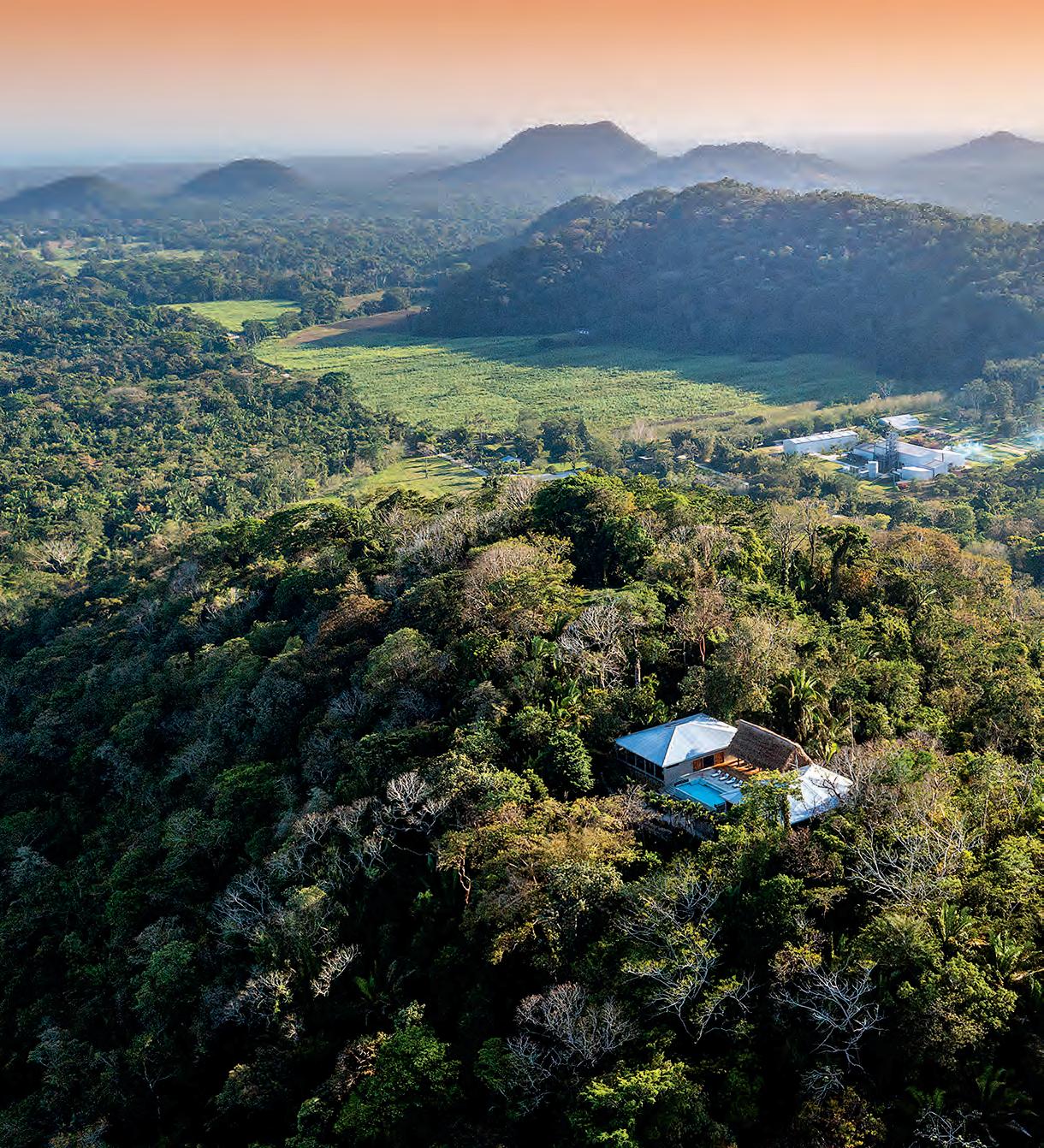
Traveling to the Copal Tree Lodge helps protect against illegal fishing, gives adults a second chance at school, and funds some of the best-paying jobs in Southern Belize. Plus, their rum is fantastic.
BY EVA CROUSE


Sitting on a bench at the prow of a small but comfortable speedboat, I watch the sun drop behind the tree line, immediately lowering the temperature and enveloping our small party in flickering, orange light. Besides our little group, there isn’t another soul around…unless you count the army of crocodiles lurking just below the surface of the wide, slow river. Or perhaps the occasional swooping heron that grants us the privilege of a passing glimpse. These trees bank the Rio Grande River, which flows through Punta Gorda, Belize, and opens its mouth to the Caribbean Sea. Our guide, Will, tells me that the land here is protected by a debt-for-nature agreement negotiated between the U.S. and Belize. Belize is a favorite winter destination for many bird species native to North America. Rather than risk those birds’ return during the spring and summer months, and the flocks of tourists they bring, the United States government agreed to preserve approximately 23,000 acres of rainforest in exchange for the reduction of $9.7 million owed by Belize. This debt-for-nature swap in 2001 was the first agreement of its kind under the Tropical Forest Conservation Act (TFCA). Cruising down the river, banked by protected land, it became clear that the idyllic scene floating above an army of dangerous reptiles mirrored the essence of this place. The safe, luxurious rainforest hideaway is pressed from all sides by the dangers its management strives to keep at bay— from climate change to poaching…to pirates.
Two days earlier, I asked Will about his official title at Copal Tree. He laughed and proceeded to hem and haw about doing “a little bit of everything.” After some prying, he eventually told me, with a look of profound disappointment at the phonetic stodginess of the words—”chief sustainability officer.” By the time I left the small South American village, I had (privately) issued Will a new title: The Sustainability Pirate.
Copal Tree Lodge is a luxury resort that produces rum, chocolate, and coffee. But mostly rum. Situated in the middle of the Punta Gorda rainforest, each room overlooks the vast tree canopy sprawling around and below the hilltop perch of the complex. With 16 private suites (more like luxury cottages) and one three-bedroom villa, Copal Tree employs 180 locals, making it the largest non-governmental employer in the region. The range of job opportunities is vast, from the resort to the distillery to the sugarcane fields and cacao and coffee farms. But what makes this multifaceted company truly extraordinary is not the toptier service, delectable food, stunning location, or even the outstanding rum. It’s their mission to be a means of prosperity for the surrounding region. They support seven local organizations ranging from hillside medical services to adult education to rainforest preservation. They sell their rum at cost to surrounding bars and restaurants and have been paying above the legal minimum wage since before there was one. By catering to the highest standard of American luxury in a far-from-affluent region, Copal Tree aims to generate an influx in tourism and economic prosperity for the entire community in Punta Gorda.
For Copal Tree, and Will, the key to success is sustainability. Operating sustainably serves three main purposes. First, by supporting ocean and rainforest conservation, they aim to preserve the resources and stand up to those looking to take advantage of them. Second, by creating a self-sustaining, closedloop system of farming sugarcane, they tap into the heritage of the land and secure independence. Finally, by marketing their genuine and rational way of life to Americans using familiar buzz words, such as “farm-to-table,” “organic,” and “sustainable,” they tap into a market eager to pump resources into establishments just like Copal Tree. Before joining the lodge, Will started and/or worked for several non-profits focused on ocean conservation. That debt-for-nature agreement? Will helped to facilitate it as the founder of TIDE, The Toledo Institute for Development and Environment. TIDE’s mission is to combat illegal fishing and guard four Protected Areas. It is a simple mission, but it comes with some serious risks.
“They are like the mafia,” Will told me when I asked who they were protecting the waters from. “Who are?” “The Chinese,” he responded with a dark look in his eye. “They just kept coming with their nets. Illegal nets. Kill everything.”
Despite he and his “guys” patrolling the Protected Areas, confiscating equipment and boats, and issuing fines, the fishermen hired by Chinese conglomerates with quotas to fill just kept coming. “We would see the same guys return again and again, with new equipment, new boats. The company would pay the fines and send them back to make up the difference,” Will said. “Eventually, things got nasty.” China possesses the world’s largest deep-sea fishing fleet and handles the majority of global processing. According to the Genuine Alaska Pollock Producers, half of the fish sticks served in U.S. public schools have been processed in China, despite it ranking as the greatest offender for illegal, unreported, and unregulated (IUU) fishing practices worldwide.
“They started bringing guns. Firing them in the air, trying to scare us.” I asked him if it worked. “Fuck yeah, it worked,” Will said. “But then my guys wanted to bring their own guns. So, I had to shut that down.” If he had allowed the TIDE rangers to bring weapons, even for self-defense, Will knew that things would escalate. “They [would] just bring bigger guns, and eventually, someone [was] going to get hurt,” he said. Although many rangers chose to leave the organization rather than risk an altercation, Will made it clear that a small crew is still patrolling. I looked at him, smiling as I realized that The Sustainability Pirate was never armed.
The most common, and detrimental, piece of illegal fishing equipment used in Punta Gorda is something called a “gill net.” Wide enough for only the fish’s head to fit through, the line gets wedged into their gills when they try to back out. These nets are prohibited because they snare everything, including dolphins, turtles, manatees, rays, and even whales. These animals are often thrown back into the water, either dead or dying. When gill nets are anchored to the ocean floor, they have been known to destroy fish habitats such as coral reefs, causing devastating damage to the underwater ecosystem and the communities that rely on the ocean’s resources.
“By catering to the highest standard of American luxury in a far-fromaffluent region, Copal Tree aims to generate an influx in tourism and economic prosperity for the entire community in Punta Gorda.”
On the third day, we went snorkeling. Or we would have—it was an overcast day, and our small party of journalists was having too much fun tasting Copalli rum and frolicking on a completely deserted island— about 45 minutes from the resort by boat. On our short ride to said island, Will took us on a brief detour to a TIDE ranger outpost. The structure, roughly the size of a 2-bedroom house with a tall wooden lookout mounted on top, serves as an office for two rangers at a time, plus two watchdogs. To apparently nobody’s surprise, the male and female tower guardians made good use of their spare time, and we were greeted by the cutest mixed-breed puppy I have ever seen. But something was wrong, the building took up almost the entire island. “Ten years ago, [the island outpost] was twice this size,” Will said, gesturing to the minuscule “island” and speaking over the low rumble of the motor. “Climate change is taking it,” he continued. “That’s why they are using the shells. Making a wall to keep the erosion back.” Sure enough, thousands of conch shells had been wedged deep in the sand, surrounding the sand bar supporting the structure in a transparently futile attempt to keep the water away from the tower. Regardless, the water keeps rising, and the lookout will eventually have to move.
Contrasting with TIDE’s fight against erosion, Copal Tree’s farming method is far from futile—it is a closed-loop system maximizing fertility. The two main ways they optimize the 3,000 acres of farmland are by leaving the stalk leaves where the canes are cut (typically cleared) and mixing the leftover stalk pith from the distillery with water to use as fertilizer. Will leads these operations and takes us to see the fields where workers aim to cut 1,000 stalks per day by hand. Workers use machetes and rest at midday to avoid risking their health during the hottest hours. “It is my job to ensure these guys are happy,” Will told me. “I am here with them every day.”
On our way to the distillery, we walked through the Lodge’s vegetable and livestock farms, utilized by the kitchen. The biodiversity of the garden mirrors that of the surrounding jungle. Herbs I was familiar with, like basil, thyme, and lemon balm, thrive there just as well as the grove of cacao trees—from which they make chocolate bars and a gorgeous cacaoinfused rum. The grove doesn’t grow in tidy rows; it is a natural section of forest where cacao trees intermingle with other vegetation. After harvesting, the beans are placed on large, rectangular trays that can be slid under a canopy to shelter from rain, or rolled back out on sunny days to enhance the drying process. Once dry, the beans are fermented in casks insulated with banana leaves. Both the chocolate and the infused rum are stunning. I recommend using the rum in a modified White Russian cocktail; a grate of Copal Tree chocolate on top wouldn’t hurt, either.

The farm-to-table dining experience at Copal Tree, combined with their numerous cocktail bars featuring an impressive array of flavor combinations—most created with Copalli rum—highlights how this resort has become practically self-sufficient. And even though it is remote, getting there is a breeze. After flying from JFK to BZE, I was met by a member of the Copal Tree team, who guided me to a charter flight. Soaring at 3,000 feet, rather than 10,000 feet, over southern Belize, the view was breathtaking, adding a sense of adventure to the luxury getaway.
With numerous activities such as kayaking on the Rio Grande (if you don’t mind crocodiles), snorkeling with a guide, a sunset riverboat cruise, a tour of the nearby Mayan ruins, and many more activities, Copal Tree is completely prepared to facilitate any level of adventure. The lodge is equipped with every amenity if a laid-back experience is more to your taste. An infinity pool overlooks the rainforest where, if you are lucky, you might catch sight of a toucan or chattering monkey. There are lounge chairs galore, multiple dining areas served by the same excellent kitchen, evening cultural education experiences, a gym, and a spa. Simply put, they know what they are doing. By seamlessly blending high-end comfort with a deep commitment to environmental and community sustainability, Copal Tree Lodge stands as a model for how tourism can benefit local economies while preserving natural resources. The dedication of individuals like Will, who embody the spirit of conservation and innovation, ensures that the lodge not only prospers but also uplifts the surrounding region. At Copal Tree Lodge, guests are invited to experience the beauty and tranquility of Belize, all while contributing to a brighter, more sustainable future for its people and environment.
From Cabo to London, Worth has tracked down the hottest accommodations.
BY PAUL TUMPOWSKY
Perhaps it is the result of our enhanced desire to travel while we were locked up during COVID, however, lists of luxury hotels that are about to open over the next 12 months have sprouted across the internet. In an attempt to garner pre-opening press, some hotels have a tendency to be overly optimistic. The result is often a list of places with great architectural renderings that may or may not open over the next year or two.
This new column only features hotels that actually opened and that we're very fond of. Focusing on future travel is nice, but why not pack your bags and head out now to experience these great destination properties?
From the stunning Four Seasons Resort and Residences at Cabo Del Sol in Cabo San Lucas, Mexico, to The Emory in London’s Knightsbridge, each featured hotel offers a unique blend of luxury, comfort, and innovative design. Whether it’s the immersive natural experience at ULUM Moab, Utah, or the serene elegance of Grand Hotel Son Net in Spain, these new properties promise to redefine your travel experience. Ready to explore? These are the best new hotels of 2024 that you can book right now.

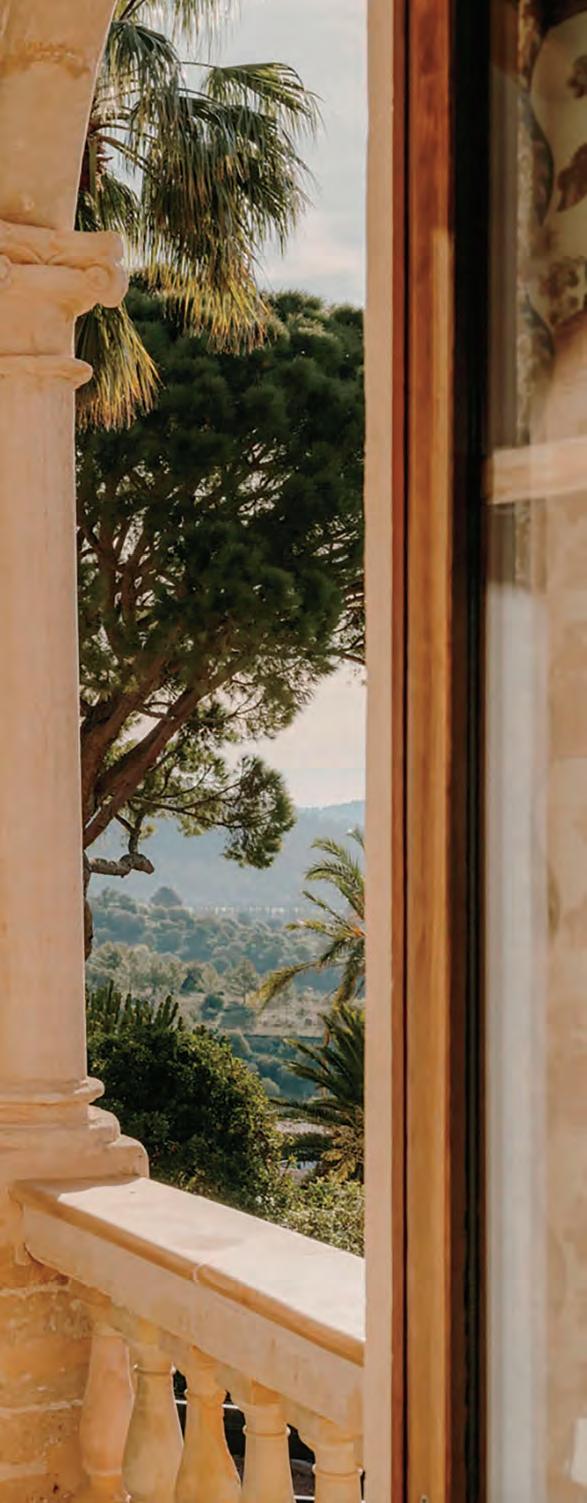
Cabo Del Sol has long been a central anchor of the Cabo San Lucas market, prized for its central location and top golf. It's about to get even better. With 96 guest rooms and suites alongside 61 residences, villas, and estates, this resort promises breathtaking vistas of the Sea of Cortez. Guests can indulge in world-class golf, rejuvenate at the full-service spa, enjoy the swimmable beach, and savor contemporary Latin cuisine curated by Richard Sandoval.
Sister resort to one of the most overlooked luxury properties in Spain, Finca Cortesin, with only 31 rooms and suites, Son Net combines elegant, palatial architecture dating back to 1672 with interiors by Lorenzo Castillo. Spend the mornings exploring the expansive gardens, with native orange and lemon trees, its own private vineyard, and fresh olive oil tastings offered from its century-old olive press. Son Net is set in the foothills of the UNESCO World Heritage Tramuntana Mountains.
Janu is the more approachable (relatively) brand of Aman. The first Janu has just opened in Tokyo’s vibrant Roppongi district. If Aman is about serenity, Janu is about energy. A great fit for a city second to none, when it comes to it. The hotel will keep you busy with Janu, which features a 40,000 sq ft spa and 3,500 sq ft gym, including a boxing studio and a golf simulator.


One&Only opens on one of the most charming Cycladic islands, but no need for ferries or small Greek air carriers. This island is only 30 minutes from Athens. The bungalows are spread across the property, each with private pools and gardens. Don’t sleep through breakfast here, the spread is worth setting your alarm for.
The Ranch at Malibu launched its first East Coast outpost in the Lower Hudson Valley— nestled amidst 200 acres, in a historic lakefront estate, 45 minutes from New York City. If you are looking for results but require some flexibility, the 3- and 4-day programs allow guests to select the stay and intensity that suits their schedule and goals (rumor is that the 4-day is much more intense). As with the original, the menu will consist of a nutrient-rich, plant-based menu, with many ingredients sourced from the onsite organic garden and local organic farmers.


QUINTANA ROO, MEXICO
Well ahead of its time and perhaps categorycreating, Sha Wellness in Spain unleashed the wellness trend 15 years ago. Now, Sha Wellness brings the concept to North America, 30 minutes north of Cancun. The 100-suite beachfront resort leverages the same SHA Method that has made the brand so famous. Be prepared to focus on yourself with a detailed fitness, spa, mindfulness, and calorie-counting schedule.
ZA’ABEEL, DUBAI
SIRO is the wellness brand from Kerzner, offering a contrast to its crown-jewel hotel brand, One&Only. An anchor tenant of Dubai’s posh One Za’abeel development, SIRO is focused on fitness and wellbeing while still making the most of this global city. At your request, SIRO will design customized programs and treatments by their fitness, mental health, nutrition, and sleep specialists.
LONDON, UK
The Maybourne Group's highly regarded fourth hotel in London introduces a contemporary aesthetic to its esteemed portfolio. Nestled in Knightsbridge, next to the sister hotel, the Berkeley, the Emory exudes modernity, setting itself apart from the collection's classical properties, Claridges and the Connaught. Featuring a limited 60 suites spread across nine floors, each floor boasts a distinct design by acclaimed designers such as Alexandra Champalimaud, André Fu, and Pierre Yves Rochon. Anticipated to offer one of the city's most panoramic vistas, the rooftop will host a bar with some of the city's best views, and the ground floor will have the inaugural outpost of Jean-Georges' renowned ABC Kitchen. Don't skip a visit (or three) to Surrenne, a private Members' Club dedicated to longevity and wellbeing, residing across four basement floors of the property.
LONDON, UK
Known globally for perhaps the best service of any luxury hotel brand, Peninsula has been on a bit of a growth spurt over the past few years. The property in Istanbul, for instance, has reset the bar in that city. When in residence in one of the 190 rooms in London, expect uncompromising service, the most user-friendly technology in your room, and a fresh but classical design by Peter Marino. The underground spa and pool are remarkably airy; and if you need the views, Brooklands, the rooftop restaurant, features investable vistas of the city.
Under Canvas unveiled ULUM in 2023, a luxury outdoor resort brand combining elegance and immersion in the natural world. The inaugural ULUM site in the American Southwest near Moab, Utah, provides unparalleled proximity to Canyonlands National Park. This extraordinary resort, featuring wellappointed suites (yes, tent suites), boasts a full-service restaurant serving inventive cuisine and cocktails, three thermal pools, and a wellness-focused itinerary encompassing sound bowl therapy, stargazing, and all the traditional activities in the park.
Renowned DJ and producer Steve Aoki calls his studio home, but he lives on the road.
BY DAN COSTA

In 2012, Steve Aoki played 161 shows in 41 countries, setting a record for being the most-traveled musician in a year. In 2014, he broke his own record with 168 shows. “There were times I couldn’t remember where I played,” Aoki says. He still plays 100+ shows a year, but now he focuses more on finding local collaborators and being present in the places he goes. Worth spoke to Aoki about his new travel habits, AI, music, and plans to visit the moon.
Dan Costa: Anybody that’s heard your music can tell you have been around the world. Anybody that looks at who you’ve collaborated with can tell that you travel a lot. How much have you traveled in the last week? What are you going to do next week?
Steve Aoki: This week is an exceptionally chill week, and I’m grateful for that. I am really grateful for that because my whole year has been pretty stacked. I make room in Japan. Although I do like a few shows out there. Last year I spent 10 days there. That’s the longest stretch of time I’ve been in one place in probably 20 years. Japan is the one place where I’m like, “we’re not doing any other shows.” I am going to focus here in my favorite place in the world.
I went to a show last night. The band came on at nine, they were done by 10:15, and I was home by 11. Your shows are a little later than that. How do you protect your sleep when you’re doing that many shows and that much travel?
That’s one of my main neurotic traits. I think about my sleep all the time. You know, I wear a whoop and always check my sleep data—actually, I didn’t check it last night. Let me check it right now. So I generally check it right when I wake up…..yeah, I got six hours of sleep. It’s pretty good. I got 49 minutes of REM, though, so it’s not great REM….
...I’ve got the Oura ring. I do the same thing. Six hours would not be enough for me.
It’s tough. When I’m in a good time zone, like in Europe, I actually get a pretty healthy amount of sleep, even if my show starts at 3:30 in the morning. That’s what happens with some of these gigs in Ibiza. My sets always start at 3:30 a.m. because that’s the peak time. That’s when the headliner starts.
You played in Japan, South Africa, and Ibiza last year. How do these locations shape your music?
You don’t need to be in South Africa to listen to Amapiano and Afrobeat. You really don’t. There’s plenty of music you hear in the studio. You hear all the drums, you hear all the sounds, you hear all the vocals, you hear all the rhythms, whatever it might be. You don’t need to be there, but a different kind of interest opens up when you’re there. Being there, I was so inspired. I wanted to feature some of these artists on the album as collaborators. That requires you actually to have a
human-to-human connection. You need to meet them. You need to be around their world. You need to be in it, and that’s the main difference. IRL versus digital, you know? Now, I have two South African artists on this new album.
You use a lot of technology to make your music. How are you using AI today, and how do you think you will use it in the future?
AI has helped with a few things in my space. First, there are great AI tools to separate all the stems of a track. Some plugins could do it, but they just did it poorly. Now AI does it pretty well. That’s a very useful tool for a lot of producers. For lyric generation, I’ve used ChatGPT since it launched. I’ll use AI to generate ideas if I’m stuck on some lyrics.
As far as music generation, I haven’t used it to help me write music melodies. I don’t work with complicated melodies anyway. Although I do like complicated melodies, I think it always adds that challenge to see if they’re something you want to include. But for the most part, my way of producing electronic music has always been the simplest approach, which is generally the best one.
Could you talk a little bit about the Aoki Foundation? Why did you start it and how did you decide to focus on brain health?
Three things need a lot of attention, funding, and awareness when it comes to health: the brain, the heart, and the gut. If we focus on those three things, then we’ll figure out how to live long enough to live forever. I am most excited about the brain. At 75 years of age, it’s a 50/50 chance, whether you get Alzheimer’s, dementia, or another degenerative brain disease. We don’t have a cure, but we have different long-term remedies and we need more. The foundation is all about supporting brain science and research.
This issue includes a story on space tourism. Are you interested in going into space as well?
I’m part of the Dear Moon project. [Editor's Note: Dear Moon is a private spaceflight organized by Japanese Entrepreneur Yusaku Maezawa. It was canceled shortly after this interview.] It took me close to two years of screenings to become one of the eight people to go to the moon, which was pretty intense. A million people auditioned to be part of this team, and I made it to the top eight, which was very exciting. When and if it happens, I don’t have any information on that, but I know the trip would be a sevenday voyage. It’s a trip that goes around the moon. It’s a trip that has only happened two times before trained astronauts. This would be a full-civilian trip.
Our tagline at Worth is “worth beyond wealth.” What does that phrase mean to you?
“My way of producing electronic music has always been the simplest approach, which is generally the best one.”
It’s family. It’s everything outside of my public life. My public life is extremely valuable to me. It allows me to pursue my dreams and continues to push me as a human. But my heart and soul go to my family and my personal and intimate relationships.
BY KIRSTEN CLUTHE
After a few down years, 2024 is shaping into one of the busiest travel seasons in decades. And though traveling is one of life’s greatest joys, it often presents its own hurdles. The right travel gear can transform any situation, even as simple as having the right charger when stuck in an overseas airport.
We’ve curated a list of 20 products—from travel-size skincare for in-flight facials to a travel jacket that can practically shapeshift—that will make the journey part of traveling more comfortable. These items are all TSA-compliant; most are compact enough to fit in your carry-on, ensuring you get the most out of your trip.

Short of wearing pajamas while you travel, there are a few items that can make you comfortable as you navigate different temperatures (hot and humid to air conditioning, for example): a good jacket, comfortable shoes, a scarf for layering, and a hat to protect you from the elements.
$198
Elevate your travel wardrobe with the Nadaam Signature Cashmere Scarf. Luxurious and versatile, it’s a musthave accessory for staying warm and stylish on the go.
$179




$125

The Baubax Travel Jacket is a multifunctional marvel with built-in features like a neck pillow, eye mask, gloves, and pockets for all your essentials. It’s the ultimate travel companion for convenience and comfort.

Protect yourself from the elements. This hat's wide brim and durable material offer excellent sun protection, making it ideal for outdoor adventures. Constructed from durable waxed shelter cloth, the Field Hat can be packed for travel, and a 2.5” brim provides 360-degree sun protection. It is finished with a leather hat band and eyelets for breathability
$248


Why wear sneakers when you can wear the podiatrist-designed–but stylish!--Frankie4 Saint Black Loafer. Made for allday wear, these loafers provide support and sophistication, making them perfect for exploring new cities. The Saint features an exaggerated chain detail, luxe leather, four layers of support and cushioning, and a utilityinspired sole complemented by a sleek upper. This pair defies expectations with perfectly weighted construction.
I have searched for the ultimate headphones to travel with and have chosen the over-ear model for several reasons: 1) I won’t lose them between the seats or when taking them out of their case, 2) my seatmates can see when I’m listening to something, and 3) The sound is more immersive. Great headphones plus a charger that works in different countries while feeding multiple devices simultaneously? That’s pretty much all you need.
$22
Global compatibility—an all-inone adapter that includes 4 different plugs that cover 200+ countries & regions, plus versatile charging. Say goodbye to tangled cords and limited outlets. This adapter allows you to charge up to 6 devices at once. One and done, as they say.





Two things are important when traveling by any method, whether on a plane, train, automobile (or even a boat)—resting en route and freshening up when you arrive. These two products can help you stay relaxed and rejuvenated on the move.
$250
Maintain your skincare routine with the NuFace Mini Kit. This portable device offers facial toning and rejuvenation, perfect for keeping your glow while traveling. The sleek, FDA-cleared MINI+ Smart Device is ideal for lifting and firming on the go.
$429
Enjoy superior sound quality and noise-canceling technology with the Bose QuietComfort Ultra Headphones. They offer immersive audio experiences while packing light, perfect for long flights or noisy environments.




$20
Ensure a restful sleep on long flights with the Nidra Deep Rest Eye Mask. Its contoured design blocks out light without putting pressure on your eyes, helping you arrive refreshed. Ergonomically designed, it provides maximum comfort and complete darkness for better sleep.



Bags are essential for travel; their size and style depend on the journey. We’ve curated a selection of bags that cover every need, from checking in luggage to carrying on, navigating the streets of a foreign city with your laptop, and shopping in Paris.
$52
Spotted while walking in Manhattan one day, the Baggu Crescent bag is the epitome of a perfect cross-body bag—stylish, lightweight, and available in three sizes. Ideal for city outings and day trips, its minimalist design and vibrant colors make it a trendy yet practical choice. Plus, you can roll it up and throw it into your
$155
This iconic bag by Longchamp has been a favorite among stylish women worldwide for years. Known for its durability and chic design, its foldable feature makes it perfect for saving space when not in use. Versatile and elegant, it’s suitable for any travel scenario —as a carry-on, beach bag, or daily companion.










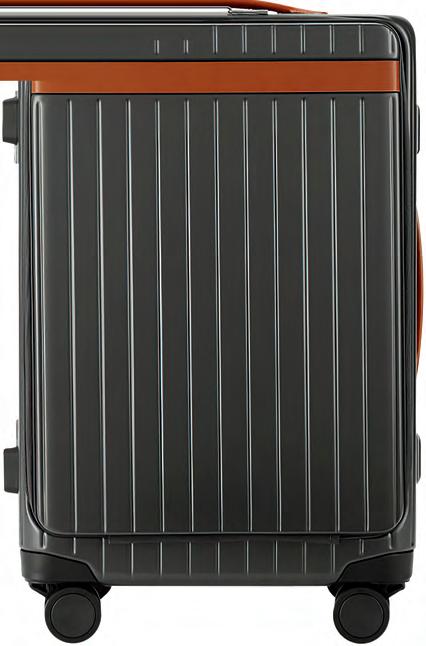
$595
Combining elegance with practicality, the Carl Friedrik Carry-on X is a frequent flyer’s dream. Its sleek design, durable materials, and smart interior organization ensure you never mistake your bag on the luggage carousel. With an integrated hard-shell front pocket for quick access to your laptop and travel documents, an aluminum frame with lock closure, 360° spinner wheels, and an impact-resistant polycarbonate shell, this cabin case is perfect for trips up to five days.
$199
The X Anti-theft 25L backpack embodies minimalist style while offering practical organization, featuring an 11-inch tablet sleeve and multiple pockets. The trusted anti-theft technology ensures you can move seamlessly from meetings to social events, confident that your valuables are secure.
$250
The No. 540 East West Tote features a spacious, open main compartment complemented by wide organization pockets to keep smaller items neatly arranged. Constructed from high-quality materials such as 10.10oz waxed cotton canvas, tubular military-spec nylon webbing, and full-grain leather, this tote is light, with lowprofile handles and a fixed shoulder strap, which can be conveniently stashed in an interior pocket when not in use.


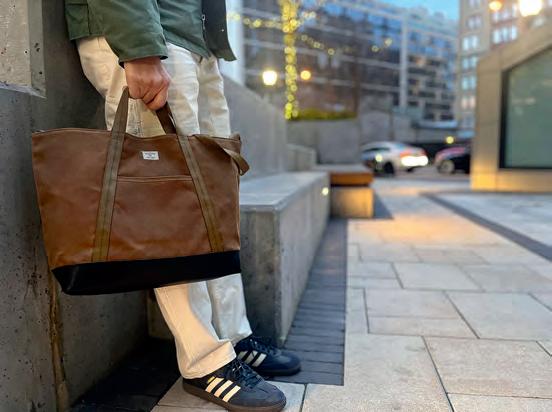


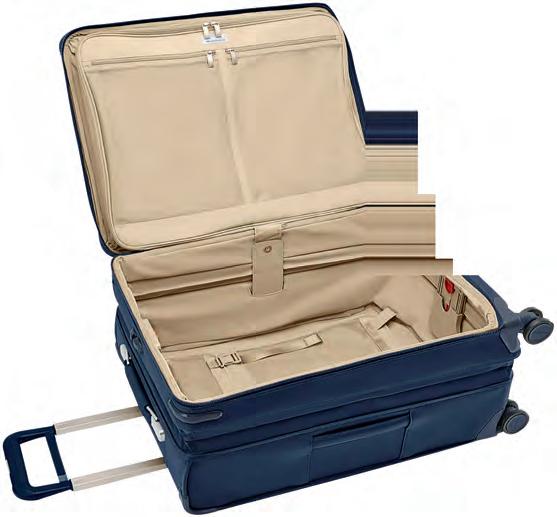

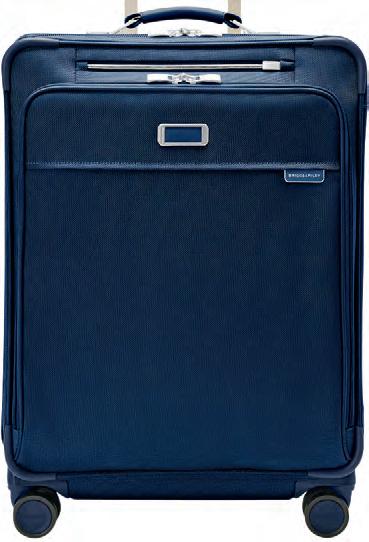
$799
The Briggs & Riley Medium Expandable Spinner offers ample space and effortless mobility for longer trips. Its expansion feature provides extra packing capacity, while high-quality wheels ensure smooth airport navigation. The Baseline Medium Expandable Spinner allows for flat packing with its Outsider® handle, minimizing wrinkles and keeping clothes looking pristine.
Traveling efficiently hinges on organization. Even if you can fly private, you must manage your essentials effectively. These products can help you stay organized on the go.
$695
This versatile organizer keeps your essentials in order with multiple compartments and a sleek design, perfect for travel documents, electronics, and other small items. Its trolley sleeve/strap lets it slip onto your wheeled suitcase, making travel a breeze.
$48
Keep your tech gadgets safe and accessible with the Ekster Tech Case. Designed to hold cables, chargers, and other tech accessories, this case ensures you stay connected and organized on the go. Stretch mesh pockets, elastic cable organizers, and rugged padding offer protection and easy access.













$40 Say goodbye to messy toiletry bags. The compartments and pouches of the Mila keep toiletries neatly arranged, making it easy to find what you need. This eco-friendly pouch is made from REPREVE recycled polyester and is perfect for travel and athome organization.
$89
Packing cubes are travel MVPs, and this Hanging Expandable Packing Cube takes it to the next level. It organizes your clothes and doubles as a hanging shelf, providing stylish and efficient storage.
$85
For a sleeker alternative than the Tumi Zip, the Dagne Dover Accordion Travel Wallet is perfect for organizing documents and currency. With pockets for your passport and cash, card slots, and a magnetic closure, your essentials are secure but easily accessible.
$225
The Tumi Zip Around Continental Wallet offers both style and security. It features multiple card slots, a zippered coin pocket, and RFID protection, keeping your financial essentials safe.







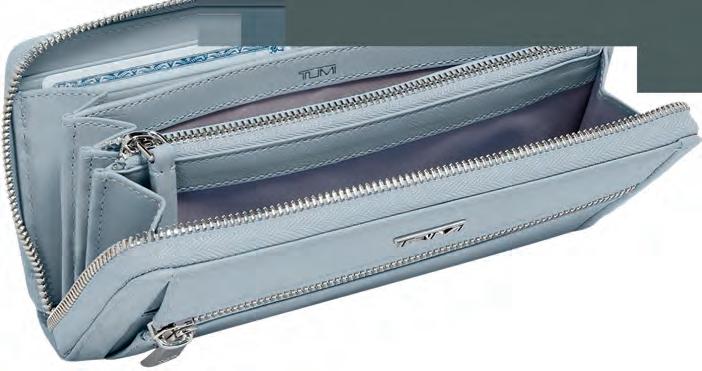

































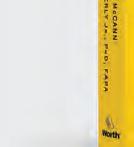


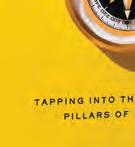

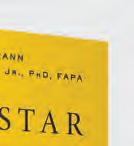
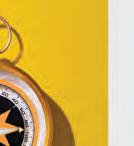
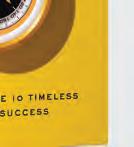






















































The financial world is changing, in part due to the rising might of Millennials—the subject of an exclusive Worth research collaboration with BCG (p. 66). One finding: They’re giving away less money, which philanthropist James Chen urges them to reconsider (p. 84). And a new project will channel philanthropy to science research (p. 86). We also explore stubborn inflation (p. 70), smaller-company stock returns (p. 80), whether any city is safe from climate change (p. 75), how wealthy investors are (or aren’t) using AI (p. 72), and how they’re rebalancing portfolios to match global changes (p. 78).

Worth’s Millennial Mindset Report reveals what makes well-off folks around their thirties stand out from earlier generations and mainstream peers.
BY SEÁN CAPTAIN
Millennials and the wealthy are sometimes overlapping groups subject to plenty of stereotyping. A new survey by Worth, in collaboration with BCG, shows that some of those preconceived notions have weight. People aged 28-43 care more about sustaining the planet and their image. Rich folks buy more and like luxury products.
But dig deeper, and the picture, by age or income bracket, isn’t so simple or predictable. Some wealthy millennials are excited to buy fancy new cars, but a sizable portion prefer to rent or grab a rideshare. On the giving side, they are more skeptical of and reluctant to send money to charity. However, they are more inclined to give their time to the right organizations with which they have developed closer relationships. (For a perspective on this, see p. 84.)
Worth’s “Millennial Mindset Report” paints a rich picture of wealthy millennials’ values and actions and will help shape our journalism well into the future. Here are the broad outlines of what we’ve found and will pursue deeper in later issues and online.
No longer kids, Millennials are moving into midlife. While the youngest are still in their twenties (at 28) the oldest have now hit 43 years of age. With age come new priorities. Eighty-six percent of our affluent survey takers are married, and 71% have at least one child. Nearly all (94%) own a home. Financial fortune has afforded this level of family stability. For instance, homeownership among all Millennials is about 51.5%, according to data from the U.S. Census Bureau.
What qualifies as wealthy in this study? We gathered insights from 1,989 Millennials in the U.S. with annual household income over $250,000 (over $350,000 in high-cost cities); household net worth over $1M; or both. We learned some interesting things when we compared them to Generation X and Baby Boomer survey takers of similar wealth. (As the survey focused on Millennials, these other generation groups had smaller samples, of 298 and 299, respectively.) About a third of survey takers are ultra-wealthy, with a net worth of at least $3 million.
Despite (albeit incomplete) advances toward gender income parity in the country overall, it’s slid back among wealthy millennials. While men comprise 48% of the U.S. population, they make up 61% of our sample, just one point less than the Boomers we spoke to, but well ahead of the 53% for men in the Gen X group. Our sample skews a bit White, at 84% (the same as for Gen X) vs. 76% in the
country as a whole. Black people and the “other” race/ethnicity category were the least represented, each down 5% vs. the whole country.
Many wealthy Millennials are starting off from a good position. Fortythree percent say they grew up in an upper-income household. The figure was only 18% for Xers and 13% for Boomers. Twenty-eight percent of wealthy Millennials in the survey derive at least some of their wealth from inheritance; that’s not significantly more than Gen X (25%) and significantly less than Boomers (39%).
Considering how much younger they (and probably their parents and grandparents) are, Millennials may ultimately get a bigger windfall. The much-hyped “great generational wealth transfer” of over $53 trillion from Baby Boomers (according to Cerulli Associates) is picking up steam and will last through 2045. Moreover, 9% of our Millennials benefit from
Maintaining a healthy lifestyle is important to me
I like to invest in myself
It is important for me to own a home someday versus renting
I care about climate and sustainability
I prefer to spend money on experiences rather than physical items
I favor a more understated approach in my possessions and lifestyle
It’s important to me what impression I make on others / what others think
I selectively share information about myself on social media
It is important for me to engage in activities that promote social justice
I consider myself to be religious / spiritual
I follow public figures whom I consider my role models that influence me
I consider myself to be politically active
I like to show off my wealth and success
I prefer to have a lower paying job that gives me work-life balance
I live a minimalistic lifestyle and prefer to rent or share items
* +/- represents delta vs. Millennials
Source: Worth Millennial Mindset Report
gifted money or possessions, vs. 4% and 2% for Gen X and Boomers respectively.
When making their own money, this generation stands apart for entrepreneurship. Fortyone percent derive some of their wealth from business ownership, vs. just 18% for Gen X and 15% for Boomers. While virtually all of these later generations list salary as a source of income, just 81% of the Millennials do.
Investment returns are the second most-cited source of income in our Millennial group (at 77%), and they are investing their money rather differently than other generations. The public market—such as stocks, bonds, and bundled investments in exchange-traded funds (ETFs)—is still the biggest single category. But at 31%, they are way below the 53% for Xers and 61% for Boomers
in the survey.
Every other category is higher than for previous generations, led by cash and savings (high-interest savings accounts rival even resurgent bond returns) and real estate. Private equity and crypto are also on the rise, though still pretty small, at 5% and 4%, respectively. (Private equity is also growing strong among family offices of the ultra-wealthy, especially in the U.S., as we cover on p. 78.)
Where are Millennials getting these investment ideas? Less and less from professional advisors. Just 30% said they engage a wealth manager or financial advisor—well below Gen X and at just half the rate of Boomer respondents. More than twice as many Millennials (61%) prefer to do the work themselves (a figure that stays the same for the ultrawealthy subset, with net worth of $3 million or more). A big chunk
/
Source: Worth Millennial Mindset Report
(28%) identify as professional investors. A small portion of Millennials’ information comes from social media and digital ads.
One of the top reasons for doing their own homework is that Millennials think their finances just aren’t that complicated, and they don’t see the value of an advisor. Among those who do go that route, higher returns and customized advice were the biggest reasons (with about half listing each of them.)
JP Morgan and Bank of America are the most popular of the 20 major advisory companies we asked about, with 34% and 24% listing them, respectively. Fourteen percent of our Millennials go to independent advisors.
These choices could change, though, based on a 2022 PwC survey of all high-net-worth generations in the U.S. Thirty-
nine percent said that they had switched advisors, and 46% said they would in the next one to two years. Given the souring attitudes we found, millennials may make up a big chunk of that.
A few studies and a lot of press over the past year indicate that Millennials (and Gen Z) prefer to pay for experiences like concerts and travel than for stuff. That’s true overall in our survey, with 76% ascribing to that view (a skosh more than Boomers and especially Gen Xers said).
But how wealthy Millennials spend may be a bit different, with 54% putting money towards experiences in the past 12 months, vs. 63% splurging on luxury goods. Usual suspects dominate here, including Gucci, Louis Vuitton, and Prada. Gucci is joined by Buccellati, Cartier, and Pandora in
the jewelry category. For luxury watches, standards like Breitling, Patek Philippe, Rolex, and Panerai lead.
The love of prominent brands may gibe with other priorities. Seventy percent said making a good impression is important to them, with 54% saying they like showing off their wealth and success. Perhaps quiet luxury is dying or never applied as much to this generation? But highlighting significant splits—even in their own minds—74% say they favor a more understated approach in their possessions and lifestyle (in line with Xers and Boomers).
Wealthy Millennials are not just attention-seeking slaves to fashion, though. The biggest spending category, at 68%, was health and wellness. And 46% said they live a “minimalist lifestyle” and prefer to rent or share. This shows up in cars, for instance. Thirty-six percent of Millennials prefer to use apps or subscriptions or to rent cars rather than to own one. When wealthy Millennials do buy, the choices they face may be different. Toyota is the brand with the highest recognition among those who made a purchase in the previous year, and they are only about half as aware as Gen X and Boomers of ultra-luxe brands Bentley, Maserati, and Aston Martin (as well as Porsche and electric truck maker Rivian).
In the previous 12 months, just 61% of Millennials spent on air travel, vs. around 80% for the earlier generations. When they do fly, they tend to go with the big brands, especially Delta, American, and United. Few have taken or even heard of private charter brands VistaJet, JSX, and XO.
Like other generations, wealthy Millennials aren’t cruising much, at just 23% in the past year (the same as for Gen Xers).
Wealthy millennials mostly go with mainstream lines when they sail. Royal Caribbean and Disney had both the highest brand recognition (in the 70s percent) and all-time spending (in the 50s). Remember, most of these people have kids. Next comes budget line Carnival (spending in the 40s), followed by Princess and Norwegian (in the 30s). At the lowest end (with a large enough sample size to assess) are luxury lines Seabourn and Ritz-Carlton Yacht Collection, which have been recognized in the 20s percent, with spending in the teens.
On a personal level, living clean is the number one value in our Millennial group, with 89% saying that maintaining a healthy lifestyle is important to them. That’s identical to Gen Xers and a mere 2% behind Boomers. The days of young people living hard may be tapering off for this group. For example, 33% of them have decreased spending on alcohol in the past year. They stand out from earlier generations regarding values in the wider world, with 79% saying they care about climate and sustainability—ahead of Gen X
“On a personal level, living clean is the number one value in our Millennial Group, with 89% saying that maintaining a healthy lifestyle is important to them.”
by 14% and Boomers by 15%. This may be ahead of Millennials at large, who face challenges closer to home. In Deloitte’s new 2024 “Gen Z and Millennial Survey” of about 22,800 respondents in 44 countries, 23% of the Millennials listed climate change as a top concern, while 40% listed the cost of living. And 17% said companies should commit to net-zero greenhouse gas emissions within the next decade. In our survey, 67% of wealthy Millennials say engaging in activities promoting social justice is important, 29% ahead of Gen Xers and 37% ahead of Boomers.
They are less inclined to put their money where their mouths are—at least in traditional philanthropy. Just 24% have contributed in the past year. Of the majority that hasn’t donated, 32% say they are skeptical about the impact of philanthropic organizations, 29% say they are overwhelmed by all the options, 16% say they have not considered it, and 9% say they don’t have enough money. But almost half of those who don’t give money will give their time: 44% said they value that kind of contribution more (vs. 31% for Xers and 21% for Boomers. Engagement with an organization is also more important for those Millennials who do donate money, at 68%.
While not asked about in this survey, Worth’s reporting has found that wealthy millennials are also looking for other ways to channel their money towards good. They are showing interest, for instance, in remaking their family business or launching new ventures to be more sustainable and equitable. And they are putting resources into impact investing that promises financial and social returns.
Be it what they care about or how they fund those cares, wealthy U.S. Millennials are forging a new path. For more from our Millennial Mindset Report go to Worth.com/millennial.
Growth is slowing as the labor market cools and the COVID stimulus fades.
BY LARRY KANTOR AND BOB DIAMOND
COVID-19 and the subsequent policy stimulus have led to a business cycle that defies conventional expectations, continuing to surprise even the most seasoned analysts. Given the Federal Reserve’s decision to raise interest rates from zero to over 5% between March 2022 and July 2023, a recession was widely anticipated. However, the U.S. economy defied these predictions, growing by more than 2% in the first half of last year and accelerating to over 4% in the second half. This surge in growth, typically associated with higher inflation, was accompanied by a significant decline in inflation, reaching the Fed’s target of 2% over the final six months of 2023. The unexpected drop in inflation led to a sharp decrease in interest rates, but the economy’s robustness prevented the Fed from making any changes.
However, the dynamics have shifted this year. While growth has decelerated from the rapid pace of last summer and fall, inflation has surged, surpassing the Fed’s target. The most notable change is the Fed’s stance on rate cuts, which is now driven by the high inflation rate, not the state of the economy. It is expected that the Fed will maintain its current position at least until summer and possibly into the fall, with the potential for one or even two quarter-point cuts before the end of the year.
Inflation peaked in the summer of 2022 at around 9% for the CPI and a little over 7% for the personal consumption expenditure deflator (PCE), the Fed’s preferred measure. It dropped to 2% in the second half of last year and has rebounded to over 4% so far this year. These ups and downs are explained mainly by the behavior of goods prices, which account for around 40% of inflation measures (the rest is services). They soared during the highly infectious and deadly phase of COVID-19 when people were stuck at home and avoided services such as traveling and going out to restaurants and entertainment venues. Consumers bought lots of furniture and office supplies,
electronics, and exercise equipment to make home life more comfortable and accommodate working from home. This occurred just as the virus generated massive global supply bottlenecks. The combination of explosive demand and a sharp reduction in supply produced a surge in goods prices that brought inflation to levels not seen in over 40 years.
A sharp drop in inflation occurred after vaccinations increased and the health effects of the virus faded. Goods spending declined as people began to go out and about again and reengage in previously off-limit services. By the time the second half of last year rolled around, supply chains had returned to normal, and goods prices had fallen back to earth. This produced a significant decline in overall inflation.
The drop in goods prices is now mostly over. Meanwhile, the service sector has been on fire as people continue to make up for lost time by taking vacations and going to restaurants and entertainment venues in large numbers. Inflation in services has been running above 4%. The outright decline in goods prices brought inflation down to 2%, but overall inflation has moved back up now that goods prices are stabilizing.
Economic policy has also played a vital role in the gyrations of both inflation and growth since COVID-19 struck. Historic monetary and fiscal stimulus generated a powerful rebound after the economy collapsed in the spring of 2020. Without that impetus, the economy would have remained in a very depressed condition for much longer, and inflation would not have risen by nearly as much, if at all.
Fiscal stimulus amounted to over $5 trillion, more than five times what was applied in response to the financial crisis. Monetary policy was also much more stimulative, with quantitative easing (QE) employed again, but this time much more quickly and in larger quantities. Following a collapse in economic activity in February 2020 that saw the unemployment rate soar from 3.5 to 14.7% in a mere two months, the economy rebounded strongly and quickly. The COVID-19 stimulus policies lasted for years and created more than $2 trillion in excess savings as well as strong profits. COVID also generated a massive shortage of labor, allowing strong job growth to continue even as the housing and manufacturing sectors were crushed by the sharp rise in Fed policy rates.
The increase in wealth and income provided by strong job growth and massive policy stimulus allowed consumers and businesses to continue spending throughout last year, even in the face of historic monetary tightening and the expiration of the various COVID stimulus plans. The slowdown in growth this year reflects a cooling labor market as well as the dwindling of excess savings, which
Source: LLP, Bureau of Labor Statistics as of 5/27/2024
have mostly been drawn down. Strong job growth and an increase in labor supply, mostly due to increased immigration, have eased job shortages, and growth in payrolls is now slowing. The unemployment rate is edging up, and unemployment insurance claims are beginning to rise from very low levels. All of this has produced a slower pace of consumer and business spending. What we are experiencing now can be characterized as a normalization of the business cycle following the sharp swings caused by COVID-19 and the policies enacted in response. There are no signs of an imminent recession at this point, but GDP will probably grow at a pace of 2-2.5% this year, well below last year’s 3.2% pace.
The important question now, of course, is where we go from here. We are in a different economic environment than we experienced before COVID. Following the financial crisis, inflation and interest rates were unusually low, averaging less than 2% for inflation and under 1% for the Fed’s policy rate. Before that, inflation was in a 2-4% range, and the Fed funds rate averaged around 4%. Several factors that kept inflation below 2%—such as increasingly free
trade and just-in-time inventories—are now moving in the opposite direction. Tariffs and trade restrictions are the order of the day, and firms are maintaining higher inventories in the wake of the COVID-induced shortages. Businesses are also diversifying their supply chains and considering geopolitical risk and cost in deciding where to produce and source inputs. There’s also a push to produce at home.
Inflation is unlikely to get out of control, as it did during the 70s and early 80s. Technology—with investment now focused on AI—will continue to enhance productivity and provide an offset. However, inflation and interest rates should average higher levels than they did following the financial crisis. The U.S. economy has shown that it can handle policy rates much higher than the sub-1% average in the years before COVID-19.
Inflation will probably settle between 3% and 4%, and the Fed is likely to resist cutting rates for most of the year because that is above its 2% target. However, if inflation is relatively stable, the Fed will cut rates eventually, and the Federal funds rate will likely end up somewhere around 4%. With somewhat higher inflation and a much bigger budget deficit, 10-year U.S. Treasury yields should settle in a 4-5.5% range, consider-
ably higher than the 1.5-3% range that persisted for a decade before COVID-19. Stocks seem fairly priced despite the surge over the past year and a half, during which the S&P has risen nearly 50%. That pace is surely unsustainable, but it’s worth keeping in mind that it came after a 25% drop from December 2021 to October 2022, when a recession was widely anticipated. Recession has been avoided, and the S&P is up only around 11% over the past two and a half years. Productivity-enhancing investments in the latest AI technology should continue to boost many stocks, although a slowing economy and higher interest rates should mitigate gains in the future.
The U.S. economy has been massively outperforming every other major global economy. That remains the case, but the gap is narrowing. Just as GDP growth in the U.S. is slowing, it is picking up in both the Euro area and the UK, albeit from very weak levels. Economic activity grew in Europe in the first quarter, following flat to negative activity in the second half of last year. Asia is also performing better, spurred by currency depreciation against the dollar, boosting exports.

Wealthy investors, especially younger ones, are warming up to new tech, but many still want a human touch.
BY SAMSON AMORE
Recent developments in artificial intelligence have prompted executives to consider implementing it in seemingly every way possible.
However, high net worth ($1-5 million in liquid assets) and ultra-high net worth ($30 million or more) investors still demand a personal touch when managing their money, and that’s unlikely to change immediately.
AIs exist to monitor and explain portfolio performance and track specific holdings to recommend when to buy or sell. These tools can either be built in-house or purchased from a provider and can “at a minimum, explain what happened to a client’s portfolio in common sense, easy-to-understand language,” while also providing customized input, said Tom Davenport, professor at Babson College and research fellow at the Massachusetts Institute of Technology’s Initiative on the Digital Economy.
Morgan Stanley’s head of wealth management technology and chief information officer, Sal Cucchiara, told Worth that AI could be useful for estate and trust planning purposes, especially for older high or ultra-highnet-worth individuals worried about taxes. Clients’ desire for increased customization is prompting some firms, including Morgan Stanley’s wealth advisory business, to create their AIs from scratch. This is motivated in equal parts by a need for control over the system’s security and dominance in the market.
“While financial advisors always have a pulse on client needs, HNW clients have more complex financial situations that can’t be addressed with cookie-cutter solutions. That’s where AI can be a game changer for [financial advisory] practices,” Cucchiara said.
Instead of generative AI, most money managers for high- and ultra-highnet-worth individuals are using
analytical AI to augment their workflows.
Tools based on “analytical machine learning—not generative stuff that everybody’s so excited about now— [can] come up with a few recommended stocks, bonds, or funds, or an action if they perceive that to be the best move” Davenport said. “But it all goes through your financial advisors. There’s still a human at the end.”
That’s not to say financial institutions don’t employ that generative AI. It is commonly used for consumerfacing chatbots or internally to summarize regulatory reports or prepare pitch drafts. This form of AI could add between $200 billion and $340 billion in value annually, mainly through increased productivity, a March report from McKinsey found. McKinsey also reported in 2020 that all AI technologies could add up to $1 trillion in value to the global industry each year.
“We think the benefits are going to be primarily making advisory teams more productive,” said Mark Alexander, head of technology and operations for global family offices at Rockefeller Capital Management. The firm has $133 billion in assets under management across various divisions and advises high and ultra-high-networth clients in 30 markets throughout the U.S. and in London.
“When people are busy and have complex lives, as most high net worth and ultra-high net worth clients do, it makes it difficult for them to navigate alternatives and make decisions in a comprehensive and coherent manner,” Alexander said, adding that AI can help with “turbocharging the advisor-client relationship.”
The usage of AI in the financial sector gained popularity in the 1980s when Dupont began investing in expert systems to analyze markets and cut costs.
The cost-saving component is also a draw for money managers, even if it comes at the expense of human employees, as one AI can do the work of many. Using AI “was, initially, a way to provide wealth management
advice or recommendations at a substantially lower cost than humans could,” Davenport said.
He said that human wealth managers are often more costly. In contrast, automated systems charge less for advice and added, “I think it has moved from being something that lowered costs to something that just can much better handle all the complexity of investing.”
He added that “a lot of the main providers that are involved in that business will be using AI to combat cyber fraud.”
Most financial management companies do not use artificial intelligence for the purpose of making trades. The trepidation around AI is partly due to a lack of regulation and transparency. “It’s definitely a gray area,” said Vijay Raghavan, senior analyst at research firm Forrester. “The regulatory compliance point of view on the topic of AI and financial advice is evolving, and I don’t think they have the framework yet in place.”
Regulations are slow to catch up with technical progress, which makes them naturally reactionary. Some wealth management firms are cautious about implementing AI because of this and are concerned about relying on systems that could later be deemed to violate standards.
Raghavan noted that the European Union’s AI Act passed in March, assesses the risks of technologies and sets requirements for managing them. In the United States, President Joe Biden issued an Executive Order in October 2023 that mandated domestic AI companies share their safety tests with the government and develop stricter standards to keep AI systems safe.
“People are literally, by the minute, trying to figure out what to do with it,” Raghavan said of AI. The fast pace of development at private AI companies isn’t helping governments get up to speed.
Some companies build their own AIs from scratch, while others combine inhouse tools with third-party software. Providers that service this industry with AI systems include Kensho, a Cambridge, Mass.-based data analytics software company that analyzes trading and documents, and Canoe, a New York-based AI firm that tracks alternative investment data and counts high- and ultra-high-net-worth investors among its clients.
There are many companies making and selling financial AIs, many geared towards the general public. When it comes to high- or ultra-high-net-worth investors, though, there appear to be fewer public-facing services. Besides Morgan Stanley, the institutions interviewed for this article declined to comment on whether their AI systems are built in-house, from scratch, or both.
According to the latest PriceWaterhouseCoopers study, investors with portfolios in the double-digit millions are increasingly likely to shuffle their roster of financial planners if their needs aren’t being met. Forty-six percent of investors told PwC they plan to change or add to their financial advisory teams in the following two years.
And of those who had already switched, 28% said it was because their former managers couldn’t support their “changing financial circumstances,” which may include the desire for alternative investments.
PwC found that those who do decide to change wealth managers are often younger: High-net-worth people under 55 are more likely to switch, especially wealthy people in the 18-34 age bracket. This same age bracket is also more likely to embrace alternative investment income means.
Some 60% of high-net-worth investors surveyed by PwC said they desire more personalized service from their wealth management firms.
Raghavan said this focus on ultrapersonalized service necessitates AI. “In wealth management, a big challenge right now is that financial advisors are pressed for time,” Raghavan explained. He noted that using AI to prepare for
or financial advisor
Source: Worth Millennial Mindset Report
client meetings—which might number in the hundreds in a larger firm, could help reduce prep time.
Davenport said that in his dialogue with Morgan Stanley, some managers maintain books for 200 to 500 clients.
Some AI even attempt to add more human touches, like alerts prompting the manager to recall clients’ birthdays, significant anniversaries, or even recent weather in their area, Davenport noted. While it might seem odd that your financial planner would call you to warn you of a tornado, it might just happen—and proponents are betting that customized messaging could give them an edge with ultra-wealthy clientele.
Davenport routinely speaks with financial institutions about their technological advancements and is an independent advisor to Deloitte. He said he was aware of one such instance where Morgan Stanley created a system that “took 100,000 of their most important documents about wealth management and put them into a custom generative AI system that’s intended for financial advisors in their teams.”
“All of the ones I am familiar with, the big financial institutions, are building out their own [systems],” Davenport noted. “They might use consultants, but they’re not buying a third-party vendor’s system out of the box,” Davenport said, explaining that
Morgan Stanley, Fidelity, and Vanguard have all invested in proprietary AI systems in recent years.
High net-worth people are increasingly interested in nontraditional investments that could provide higher yields or less volatility than traditional capital markets.
“Given our high-net-worth investor data, we recommend wealth managers focus on building targeted service offerings, expanding their product shelves, and curating personalized, digital experiences to retain clients and capture money-in-motion,” PwC’s asset and wealth management consulting solutions leader Roland Kastoun said in its 2022 report.
Davenport said that a financial firm that can create an AI to better advise on these trends of nontraditional investments—like art, alternative energy, timber, or precious metals— would gain substantially.
AI for “these alternative investments that ultra-high net worth people tend to be interested in never really were the focus of the initial round of robo-advisors,” Davenport noted. “But there’s nothing that couldn’t make it possible to have a generative model just about investing in art or just about investing in timber or just about investing in cryptocurrency.”
Cucchiara said, “Advisors at Morgan Stanley can use the AI @ Morgan Stanley Assistant to search through Morgan Stanley content on advising a client on investing in art,” by providing talking points and data. He added, “This is especially helpful for advisors who may just be starting out catering to this client segment.”
However, younger investors are much more likely to bypass advisors. Worth’s Millennial Mindset survey found that 69% of Millennials selfmanage their investments, primarily because they are confident in their ability to do so. This is 16% higher than Gen X and 33% higher than Boomers. Customized advice and the prospect of higher returns are the main reasons Millennials will turn to advisors. The survey didn’t ask about their interest in using AI instead of human assistance. (Worth just completed an evaluation of registered independent advisors. See page 88 for the top 300 picks.)
That said, humans will still play an important role in managing high-networth assets for the time being. But as firms try to maintain a competitive advantage, they will increasingly embrace AI to augment their managers’ capabilities. While it’s clear that most financial institutions aren’t keen to let AI make all the decisions now, some advisory firms may further embrace the technology as more regulations and standards are developed.
As drought, flooding, and other severe weather proliferate, economic boosters market certain cities as safe outposts. Is anyone buying it?
BY ADINA SOLOMON
Laura Marland was sitting at her computer in West Lafayette, Indiana, in 2015. Looking out the window at mature maple trees, she read about the polar ice caps melting in the Arctic. “That was alarming,” Marland says. Melting ice caps, triggered by climate change, lead to further global warming. She had already begun to feel this heat. In the past, Indiana experienced only seven days per year at 95 degrees or more. Indiana University predicts that in the coming decades, that number could be 38 to 51 days.
The threat of further increasing temperatures pushed Marland to leave West Lafayette for the Lake Superior town of Duluth, Minnesota, a decision she has never regretted. “As a [professional] photographer, I liked it when I first came because there’s always something to take a picture of,” Marland says.
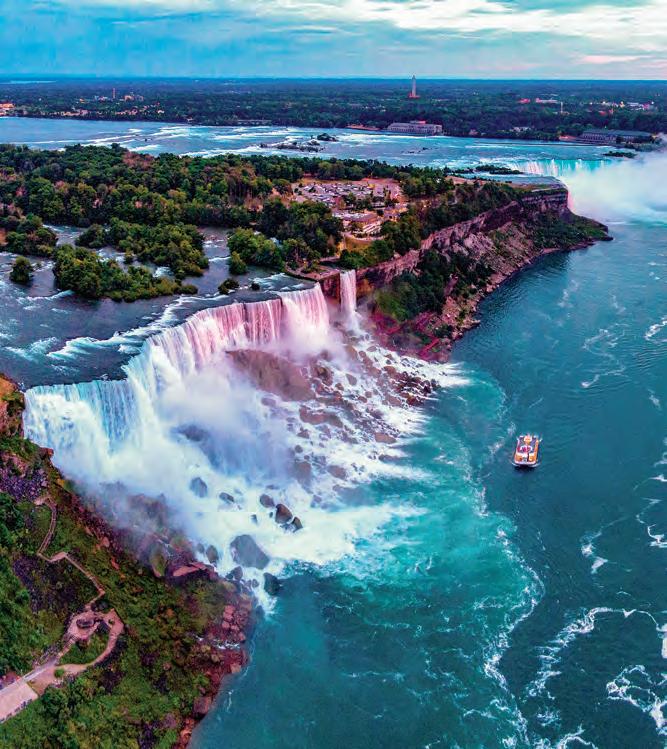
In 2019, then-Harvard professor Jesse Keenan, who studies climate adaptation and the built environment, identified Duluth as a potential spot for people escaping extreme weather. He traveled to Duluth to pitch his idea for the city to market itself as “Climate-Proof Duluth.” News outlets picked up the idea, with a 2019 New York Times article popularizing the term “climate refuge.” (Keenan now teaches at Tulane University in floodprone New Orleans.)
In the past five years, media and some climate researchers have called out a handful of cities as relatively safe from extreme weather events such as heat waves and hurricanes. So-called havens include Duluth; Ann Arbor, Michigan; Buffalo, New York; Burlington, Vermont; and Madison, Wisconsin.
Other climate researchers doubt whether any place can be safe from harsher elements. More complete data is needed on why people move to these cities, whether for climate, jobs, or another reason. But that hasn’t stopped regional economic boosters from latching onto the haven idea to attract businesses and residents.
Meanwhile, cities are evaluating what their new climate-safe status means for the future of their population and economy.
Buffalo is used to people defining it by weather—usually cold winters and lots of snow—but lately, the conversation has turned to something else. In 2019, Mayor Byron Brown called Buffalo a “climate refuge” in his State of the City address. After that, the idea took on a life of its own, says Brendan Mehaffy, executive director of the Buffalo Mayor’s Office of Strategic Planning. The city hasn’t used “Climate Haven” in its marketing, but economic development agencies such as Invest Buffalo Niagara have.
The city is looking at translating environmental threats into an opportunity for residents, says Kelley St. John, who serves as climate action
manager with Mehaffy. “We know the threats and the implications of climate change, and they’re certainly not things that would indicate you to be optimistic,” she says. “But we see there’s a lot of opportunity.”
Buffalo has already seen expanded workforce development and job opportunities, particularly in advanced manufacturing and health care. Mehaffy says being a climate haven could further boost the city’s growth.
He sees climate as a growing factor in people’s decision to live in Buffalo. For instance, about 3,000 people came to the city from Puerto Rico after Hurricane Maria hit the island in 2017, joining an already large Puerto Rican community. Some later returned to the island, but many stayed. Mehaffy’s office says this influx contributed to Buffalo’s first population growth in 70 years, as recorded in the 2020 census.
He adds that the city isn’t preparing differently because of its climate refuge status. It has already taken action to build the economy, revitalize its waterfront, and expand amenities such as parks and transit. But he says potential climate migration could quicken the pace of development.
According to Forbes, nearly a third of Americans cited climate change as a reason to move in 2022, but there is little evidence that it has caused mass migration. Sociologists at Rice University studied thousands of homeowners who sold their extremely flood-prone homes to the government through a Federal Emergency Management Agency program. The 2023 study found that most people stayed within a 20-minute drive of their original homes.
But for those who consider climate change, are they pushed away by factors like wildfires in California or pulled towards new cities by their climate-haven reputation?
Susan Clark, assistant professor of environment and sustainability at (coincidentally) the University of Buffalo, says push and pull are complicated factors to measure in studies of migration. After a major weather disaster, she says there’s often an uptick in people considering moving to somewhere more secure. However, Clark says factors like jobs or proximity to family also drive these decisions.
Source: Climate Impact Lab
She says Puerto Ricans who moved to Buffalo after Hurricane Maria did so because of the community that already existed in Western New York, although climate was a consideration among several.
“I have yet to hear anybody say that they moved to Buffalo based on climate factors,” she says. But she believes it could be a factor in picking between two otherwise equal cities. However, these places also get a boost from having more affordable housing than many other cities. “It’s the portfolio of these things that make places like Duluth and Buffalo attractive, and the climate haven narrative certainly helps.”
Until recently, refuges have primarily been around the Great Lakes and Northeast. But now Florida has joined the mix. Eighty miles from downtown Orlando, the north-central Florida town of Ocala is the fourth fastest-growing metro area in the country, according to the U.S. Census Bureau. Its population increased by more than 3% from 2022 to 2023.
Named the “Horse Capital of the World” for its large breeding and training industry, Ocala is developing another
reputation—climate haven—due to a 2023 Wall Street Journal article. Based on a collaboration with software company Climate Alpha, the Journal reported that Ocala has the lowest risk of coastal flooding of any Florida city.
New residents are coming for a variety of reasons, says Kevin Sheilley, president and CEO of the Ocala Metro Chamber & Economic Partnership. Climate change is a popular one, something that Sheilley often hears when individuals contact the chamber of commerce for information on relocating.
The Partnership has noticed and has included Ocala’s climate haven status in presentations to potential manufacturing companies. Sheilley says they show greater interest when they hear that the city is less prone to hurricanes and flooding.
“You instantly see a click with people, like ‘Hey, that’s important,’” he says. “We see it as a key competitive advantage, and I think we’re going to continue to see that become more and more so.”
In the last two years, the Partnership has seen more businesses from South Florida moving to Ocala. Sheilley says lower costs and weather are driving these decisions. Businesses can also easily access South Florida, Orlando, Tampa, and other major cities.
The marketing around climate refuges is strong, but the concept is on shakier ground. Clark of the University of Buffalo says the term can mislead people into thinking that they can escape climate change. “You’re just switching the type of vulnerability,” she says. “We’re just vulnerable to different things.”
Although Buffalo doesn’t have problems with rising sea levels, other threats still exist. In Western New York, the average number of days above 85 degrees per year rose from 15 in 1970 to 23 in 2022. And summer wildfires in nearby Canada damage Buffalo’s air quality. At the other extreme, a major blizzard in 2022 killed 47 people. Anticipating future severe weather, Buffalo has hired leaders to manage emergency
response and the city’s fleet of snowplows and emergency vehicles.
Six often-cited cities—Ann Arbor, Buffalo, Burlington, Duluth, Madison, and Minneapolis—will face some of the country’s most significant temperature increases in coming years, according to research from the University of Michigan. Warmer air can also hold higher quantities of water vapor, causing more frequent, intense, and longer-duration storms.
Marland says that the shift in weather patterns could reshape cities in ways that new residents didn’t bargain for. This past winter in Duluth was relatively warm and had less snowfall. December 2023 was the hottest December on record in almost 150 years.
“[People] might be coming up here for the scenic beauty of the Northland and find that climate change is altering or perhaps destroying a lot of that scenic beauty,” says Marland.
The marketing around climate refuges could raise awareness about these effects. Clark says it demonstrates how climate change is already affecting the U.S., not just places that seem far away, like the Arctic. It also shows how cities close to home are taking steps to prepare for more severe weather in the coming years.
As the possibility of an influx to havens grows, these cities must determine how best to prepare for the arrival of people and businesses that could strain their communities.
Climate gentrification has become a persistent concern in Duluth, which already has a housing shortage. People began talking when billionaire Kathy Cargill bought many homes for more than the assessed value in Duluth’s Park Point neighborhood, on the world’s largest freshwater sandbar. She demolished many of the houses. Some in Duluth are now worried about the future of Park Point, where people of all incomes could enjoy Lake Superior, and how the city could change, according to reporting by MPR News.
“Residents seem to be very taken by surprise by that,” Marland says. “And I personally don’t think they should be taken by surprise because that’s what’s going to happen. A lot of wealthy people are going to buy property here.”
More housing is under development to accommodate new people in Ocala, to the consternation of some current residents. Locals who value open land and isolation from others have chafed at new development in once-rural Ocala, according to coverage by PBS station WUFT in Florida. In the five years leading up to 2022, the Ocala StarBanner reported more than 50,000 residential units were approved in the county.
Buffalo has an expanding need for affordable housing as more people arrive. Over half of the city’s tenants spend 30% or more of their income on rent. In 2023, Buffalo acknowledged the challenge by creating the Affordable Housing Task Force. The group released policy recommendations such as increasing penalties for violations of the city’s fair housing law and funding a study into the quality and habitability of housing stock.
Buffalo has 7,700 vacant lots, according to numbers reported by the Buffalo News in 2023. The city and local partners are constructing 12 single-family homes on one of them, a process officials are considering replicating throughout Buffalo. State Sen. Sean Ryan has proposed building 2,000 one- and two-family houses on vacant lots.
Clark says there’s more urgency in climate refuge cities to pursue sustainable development, such as affordable housing, because of the potential population growth.
“We haven’t seen a huge influx yet, and I think it’s a real opportunity we can plan for,” Clark says. “Although I don’t love the idea of a climate haven, I think if we carefully and strategically prepare, it could be a huge economic boost for Western New York.”
Climate change can be a rallying call for so-called haven cities. It’s a chance for them to capture population and economic growth, rethink their housing strategy, improve infrastructure, and ensure all residents have equal access to parks and other amenities.
The latest UBS study finds swings in how and where family offices invest, reflecting economic, geopolitical, and environmental trends.
BY SEÁN CAPTAIN
The past few years have been marked by “great” trends. In labor, the Great Resignation was followed by the Great Reshuffling as people moved between sectors. At the other end of the wealth spectrum, we have the Great Rebalancing, as 37% of ultra-high net worth families said they would rejigger their investments in 2023, and 27% say they will in 2024.
That’s the takeaway from UBS’s fifth and largest annual Global Family Office survey. It polled 320 family investment offices in seven world regions, with an average net worth of $2.6 billion. Accounting for $600 billion of wealth, the survey offers a deep dive into how some of the wealthiest and best-equipped investors perceive business, economics, finance, the environment, tech, and geopolitics. It’s all the more relevant as family offices are proliferating.
“I think as they grow in popularity and prevalence globally, they’re going to increasingly be a leading indicator of what other investors are thinking, both ultra-high net worth investors, and probably high net worth investors,” said Jennifer Gabrielli, head of the Ultra High Net Worth Solutions Group at UBS Wealth Management Americas.
So where is the money going? Moving cash to fixed income is a big shift, growing at the highest rate in five years, mainly as government and high-grade corporate bonds. Returns have soared for bonds after decades of doldrums, so the move is unsurprising. However, it is also an indicator of possible future interest rate changes. Family offices are avoiding longer-duration bonds, which are more vulnerable to interest rate shifts, and focusing on durations under five years. Globally, family offices allocated 19% of funds to fixed income. It was especially popular in Latin America, at 34%, but mild in the U.S. at just 7%.
The U.S., however, is going big in private equity, making up 35% of investments, vs. a global rate of 22%. “The U.S. saw a considerable increase in private equity allocation year-on-year,” says Gabrielli. “And even the starting point for private equity for U.S. family offices is already higher than global peers. So we’re kind of over-indexed.” In the U.S., most private equity money goes to direct investments rather than to funds; it’s the opposite globally. (Worth’s Millennial Mindset Report also shows increased interest in PE.)
For overall investing, manager selection and active management are on the rise, with 39% of family offices relying more on that route, up 4% from 2022. This indicates concerns but also opportunities for market volatility.
“I think families are using that as an opportunity to take advantage of highquality managers with good track records as part of the diversification play,” says Gabrielli.
There’s been more worry about real estate slumping, especially in the U.S. With other asset classes doing better, it’s natural for U.S. offices to shift money into other options, says Gabrielli.
Another key differentiator for the U.S. is how popular it is for investment. Despite whatever pessimism there may be in politics and the press, the U.S. economy looks more promising than other regions to investors. Other stud-
Source: UBS
ies back this up. Late last year, Wilmington Trust issued “The Makings of U.S. Economic Exceptionalism” report, arguing that a strong stock market, flexible labor pool (see Great Reshuffling), and innovative businesses will keep the U.S. ahead. This is because economies like the EU and China are slowing. Of the family offices polled, 16% said they expect to increase investments in Greater China (primarily PRC and Taiwan) in the next five years. The figure is 17% for Western Europe and 4% for Eastern Europe. However, 35% of offices expect to invest more in the Asia-Pacific region (excluding Greater China). And 38% expect to pump more into North America.
U.S. family offices are the most prominent investors, with 82% of assets entering North American investments. There’s another reason: It’s easier. “If the U.S. is doing fine, why do we need to invest somewhere else?”
UBS quotes the president of a U.S. family office as saying. (The report features several quotes but doesn’t reveal who said them.)
Artificial intelligence is helping here, with giants like OpenAI, Google, Microsoft, and Meta, as well as a plethora of startups based in the U.S. Seventy-eight percent of family offices (and 83% in the U.S.) say they are likely to invest in AI in the next two to three years. It’s followed globally by health tech at 70% and automation and robotics at 67%.
However, there’s plenty of concern about where the global economy could be going. The biggest worry is major geopolitical conflicts, with 58% of family offices considering it a risk in the next 12 months—almost twice as high as worries of a global recession. Over the next five years, 62% of offices have that concern. However, the survey didn’t ask about particular regions or conflicts. These concerns gibe with “The Global Cooperation Barometer 2024,” a McKinsey and World Economic Forum report citing
Private equity funds
Private equity funds of funds
Direct investment(s) in private equity as an active shareholder
Direct investment(s) in private equity as a passive shareholder
Direct co-investments in private equity as an active shareholder
co-investments in private equity as a passive shareholder
Source: UBS
“sharp declines in peace and security” as the greatest threat.
Climate change jumps to the number two worry for family offices (one point ahead of a debt crisis) in the coming five years, with 49% of all offices seeing it as a risk (vs. 36% in the U.S.). As with geopolitics, the survey didn’t ask respondents to name specific areas of concern. However, “several family offices with large real estate holdings indicate that sustainability has become critical for them.”
Input from a Mexican family office’s (also anonymous) investment manager hints that keeping up with climate change is a big concern. “In Latin America, infrastructure for things like water does not develop as fast as in developed countries. It takes time,” they said. “If you can adapt the infrastructure to harbor resources, you can, at some level, mitigate the impact. If your infrastructure is 30–40 years old, though, the impact is huge.”
“Mexico has been in severe drought. And how does that impact how they’re thinking about everything from their investment portfolio—so the com-
panies that are impacted by climate change, positively or negatively, as well as their philanthropic leanings, but also their operating businesses,” says Gabrielli. (Worth, for instance, has reported on hedge fund’s efforts to develop AI weather prediction systems.)
SUSTAINABILITY’S FINANCIAL UPSOT Climate change also offers investment opportunities. These are spurred, in part, by sustainability regulations, says the report, again mentioning the real estate sector. Thirty-two percent of family offices said they want to focus on or better understand “net zero and the energy transition,” while 30% said that about “clean tech/green tech/climate tech.”
Wealthy families may be concerned about the environment personally, but for investing, it’s more and more about returns. “Close to two-thirds [of family offices] fully expect that, just because the investment is sustainable or has an impact angle, it should still be getting a market rate of return,” says Gabrielli. “Maybe a couple years back, there was this concept [that] those might be at a discount. There’s no more discount.”
Though their shares have been underperforming for years, valuations for smaller companies are so low that the prospects for returns cannot be ignored.
BY MAX ISAACMAN
The small-cap stock market sector has bewildered, disappointed, and frustrated some investors—both professionals and individuals—for about 20 years now. The sector, consisting of companies with a market cap of about $250 million to $2 billion, has just not performed well, compared with the big- and mid-cap sectors. Examples of such small-cap companies include specialty material company ATI Inc., and piping systems manufacturer Mueller Industries.
It now appears that small caps are cheaply valued compared to big-cap equities and could make a profitable addition to portfolios while also adding diversification. At some point, this could be true, but when? Looking at some statistics might help.
In early June, according to Morningstar, the small-cap S&P Exchange Traded Fund, or ETF (symbol: IJR), showed historical yearly earnings growth from the last five years of -0.06% (yes, negative). Morningstar estimates annual long-term earnings growth for the next 3-5 years at 11.20%. That is a total expected increase of 11.26%.
Compare that to earnings for the big-cap S&P 500 ETF (SPY) over the last five years, which were 7.32%. Its estimated yearly long-term earnings growth for the next 3-5 years is 11.70%, for a total expected growth increase of just 4.38%. (Disclosure: As an investor advisor representative, I have bought IJR and SPY, for clients.)
Consider another crucial measure: the price/earnings to growth ratio (PEG). This figure compares a company’s earnings growth to its market price. A ratio of 1 is considered reasonable, and the lower the PEG, the cheaper the valuation. Morningstar estimates a PEG of 1.32 for the smallcap IJR vs. 1.85 for the big-cap SPY. The small-cap asset class is selling at a lower PEG even though its earnings are expected to increase more than large-cap class earnings. Usually, you’d pay more for the faster
grower, but in this case, it’s the opposite.
However, there are problems with the small-cap asset class. And one of those is past earnings. Since 1990, stocks in the Russell 2000 smallcap index have included many non-earnings companies reporting operating losses. This has happened in a low-interest rate environment. Interest rates have increased recently, prompting some to think that times might get harder for the small-cap sector.
As Ryan Grabinski, portfolio manager for Strategas, told Worth in an email, “Higher long-term interest rates are likely to remain a headwind for unprofitable companies, especially those who have never earned profits before. The Russell 2000, in
particular, is home to a large share of these types of companies.”
Still, there is hope for small-cap performance because of cheap valuations. “The small-cap index sells at a 32 percent discount to the 20-year average relative price/earnings multiple to the S&P 500 Index,” said Sam Stovall, the chief investment strategist at CFRA Research.
He points out that many small-cap investors are waiting for the Fed to cut rates, which could help the stocks. However, there is also concern that rates will not be cut, perhaps triggering an economic slowdown. Stovall adds, “Small cap stocks get hit the hardest of all cap sizes during a recession.”
Being small is an advantage from the standpoint of starting from a smaller base, making it easier to achieve better growth. However, smaller companies may have a harder time raising capital than larger ones. This can be a limiting factor for operations and growth and is more costly when interest rates are rising.
There are additional risks. Smallcap stocks are usually more volatile (with greater price movements( than bigger-cap stocks. Some small caps have smaller numbers of outstanding shares, leading to those shares not being actively traded. This makes buying and selling positions harder, especially in times of low market activity.
Globalization destroyed many U.S. manufacturing communities that had flourished for years and caused pain for many middle-class and lowerincome families in large swaths of the country.
Binyamin Applebaum of the New York Times points out that in a small factory town in Illinois, the city’s population declined, and household income dropped 27% in 14 years. There are many other examples of workingclass areas declining throughout the U.S due to globalization.
But despite these setbacks, the U.S. is still the second-largest manufac-
turing country, behind China (with about four times the population).
America’s $2.60 trillion manufacturing sector accounted for about 16% of global manufacturing in 2021, according to data from the U.S. Bureau of Economic Analysis and the International Monetary Fund,
The small-cap sector could benefit if U.S. manufacturing grows. A glance at IJR shows that 17.49% of its portfolio is in the industrial sector—its biggest sector holding—and this includes manufacturing. Recent signs point to less manufacturing outsourcing in the future and more goods being produced in the United States.
The pandemic brought out the problems inherent with the global supply chain. The plan of having countries, including China, making products cheaply and supplying them throughout the world collapsed under the weight of U.S./China trade tensions. The U.S. announced tariffs on Chinese products, and China retaliated with tariffs on American goods.
A recent development boosting U.S. manufacturing is the workforce training programs created by new laws promoting U.S. manufacturing, including the American Rescue Plan, Bipartisan Infrastructure Law, CHIPS and Science Act, and the Inflation Reduction Act.
This effort to bring jobs back home, depending on how successful, could create more manufacturing activity and help the small-cap stock sector, since its companies operate mostly in the U.S. American manufacturing could boom, but it may not help big-cap companies as much, since they usually operate all over the world.
Big-cap companies have been at the forefront of the rush to grow through international expansion, which could be reversed somewhat.
Standard & Poor’s senior analyst Howard Silverblatt says it is hard to calculate the cycle when one cap size will start outperforming another. Over 20 years, the S&P 500 Index (big cap) and S&P 600 Index (small cap) have almost the same performance: 560.15% to 497.51%.
Over 25 years, there is about double the return for small cap: 556.21% to 1006.18%. This shows how difficult it is to calculate reversion to the mean, which refers to assets not outperforming or underperforming indefinitely.
“We go in cycles,” Silverblatt told Worth, emphasizing that small caps will outperform for a while, and then big caps or mid-caps will dominate.
“There’s more volatility in small caps,”
he said, referring to their higher risk. He also pointed out that small-cap companies usually have more leverage (borrowing for operating capital, expansion, or other purposes), making them more vulnerable to higher interest rates. And they usually have less access to capital. But they could be worth the risk. As Silverblatt opined, “You buy small cap for growth.”
Joseph O’Malley, strategist at Invesco, Ltd., said that a case can be made for small caps in this environment, even though it may take a while to be profitable: “We’ve seen big
caps outperform for the last several years. Eventually we’ll see that performance reverting to the mean.”
Investors who would like to include small-cap stocks in their portfolio have several options. They can simply pick the ones that they like, based on good earnings prospects, a reasonable PEG ratio, and other promising fundamentals. Or they can buy an index fund, which holds securities selected to match a set strategy and are packaged as a mutual fund or an ETF. Investors can place ETF trades through an online account or through a broker during market hours. Mutual funds execute their trades once a day, after the market closes, and orders can be placed through a stockbroker or directly with the fund.
The S&P 500 Index is the bestknown index of big-cap U.S. stocks, including the 500 leading companies chosen by the S&P committee to represent the U.S. economy. The S&P 600 is designed to capture the U.S. smallcap market segment.
There are other index funds like the S&P 500, trying to capture the broad market. Broad market index
mutual funds are inexpensive, charging about 0.15%. ETFs that replicate the broad market charge about the same. There are many other indexes that use different weighting models than the broad market strategies, and these strategies can be traded in mutual funds and ETFs. Funds and ETFs using these indexes have much higher management fees; some charging over 0.80%.
Indexes are hard to beat. S&P compares active mutual funds, in which professional money managers make stock-picking decisions, to its index benchmarks, without tax considerations. The results completed as of the middle of 2023 showed that over the past 20 years: 93% of active funds underperformed the S&P Composite 1500; 94% underperformed the S&P 500; and 94% underperformed the small-cap S&P 600.
If taxes are considered, the index performance would have been even better against active funds. Many taxable capital gains were paid by funds in years that the market was weak or declining. Part of the reason probably was that funds had to sell stocks to redeem fund holders who wanted out of the market, and some of the fund sales were at a profit.
Many small-cap stocks have growth possibilities, and earnings projections forecast that some small-cap companies could do better soon. (To be fair, there are also projections showing the opposite.) Many small-cap companies offer value, having lower valuations than their big-cap siblings.
This might be a good time to consider dollar-cost averaging, where you buy a certain amount, say $2,000 worth, no matter the price, and buy a certain amount periodically. Another way to buy periodically is if the stock or index goes down 5 %, you buy another amount, this time $3,000 or $4,000—whatever fits your portfolio size and budget. If you always buy at a cheaper price, you’ll buy below your average price. Or decide on how much of your portfolio that small cap should represent, say 15% or 20%, depending on how aggressive you want to get and what your risk profile can stand.
It’s true that many small-cap stocks have risks and are underperforming. But money is made when stocks with risks and long-term underperformance are bought for long-term gains.
Source: Alpha Architect
From opera to dance to theater to painting, popular music and more, this small Southern city is enjoying an artistic renaissance that’s attracting global attention.
BY WORTH STAFF
Belonging to a golf club gives members a sense of familiarity and comfort. Players learn every intricacy of their course, the staff and the other members are like family, and for many, it feels like a second home. While avid golfers enjoy the benefits of having a club membership, they also relish the challenge and excitement of experiencing different clubs, though they are often limited to public courses when they travel.
Heritage Golf Group, a company that has acquired over 30 premium golf and country clubs, is changing how their members are able to travel and play clubs nationally. The Heritage Plus membership draws from their management team’s decades of experience in owning and operating clubs, offering a unique and comprehensive approach to golf club membership.
One of the most appealing features of the membership is its unparalleled flexibility. Unlike other golf memberships, where access might be limited to a handful of courses, Heritage Plus opens the door to a nationwide growing network of high-quality golf courses, all owned and operated by Heritage itself. This integrated ownership ensures that members receive a uniformly high standard of service and course quality no matter where they play.
“We had a unique opportunity to build a program that truly addressed the desires of our members, drawing from the best features of similar programs, combined with feedback from our actual members.” Says Andy Miller, chief revenue officer at Heritage “Currently, a large and growing percentage of our thousands of Golf Members participate in the program, with over a 90% renewal rate.”
Members are not confined to their local club; they have the opportunity to travel and play courses in 14 states when adding Heritage Plus to their membership. This feature is a boon for golfers who travel, whether for business or pleasure, allowing them to enjoy their passion without the hassle of finding a quality course.
The recent acquisition of Lakewood Ranch Golf and Country Club further expands the network, adding another jewel to their already impressive crown. Lakewood Ranch is renowned for its meticulously maintained greens and challenging layout, making it a favorite among both amateur and professional golfers. With its inclusion, Heritage Plus members will soon have another excellent option for their golfing adventures.

Understanding the needs of traveling golfers, Heritage has taken steps to make the experience as seamless as possible. For those who prefer the familiarity of their own clubs but dislike the inconvenience of traveling with them, Heritage has partnered with Ship Sticks. This partnership allows members to have their golf clubs shipped directly to any Heritage course, ensuring that they can play with their preferred equipment without the burden of transportation.
For those who may decide to travel light or face lastminute trip changes, Heritage offers complimentary club rentals at every course. This thoughtful service guarantees that every member has access to top-quality golf clubs, ensuring that the spontaneity of travel does not compromise the quality of their game.
The Heritage Plus membership is more than just a golf membership; it is a ticket to a diverse and elite network of golf courses that cater to the discerning golfer looking for variety, convenience, and a consistently superior golf experience across multiple destinations. As Heritage continues to expand its offerings and services, the value of this membership only increases, promising a world of golfing opportunities that are both luxurious and accessible.
For more information about Heritage Golf and their Heritage Plus membership, visit heritagegolfgroup.com.

Viewpoint: The Zillenials’ wealth transfer is happening now. So should thier philanthropy.
BY JAMES CHEN
Billionaires are getting younger. According to City Index, the average age of the world’s billionaires has fallen from 58 in 2014 to 47 in 2023. Forbes’ most recent list of the world’s wealthiest people now boasts a litany of remarkably young individuals, from singer-songwriter Taylor Swift to 19-yearold heiress Livia Voigt.
This shift in the demographic reflects evolving economic dynamics, the rise of bright young-minded entrepreneurs, and the beginning of the great “Zillenial” wealth transfer. A younger generation is typically perceived as having a greater awareness of more progressive views and ideals, whether it be environmental sustainability or workers’ rights. It also presents an unparalleled opportunity for this rising generation of Zillenial billionaires to reshape the realm of charitable giving, patronage, and philanthropy. This is an opportunity that should start right now.
All too often, I see ultra-high-networth individuals (UHNWIs) relegate philanthropy as a plan for the future, one they’ll pick up in retirement, a footnote in the narrative of their success. Why defer the opportunity to leverage their energy, resources, and network for societal good? Instead, they should seize the moment to create major change and address pressing global challenges with youthful vigor and determination.
One specific concept of philanthropy benefits greatly from time and
experience spent: moonshot philanthropy. An audacious approach inspired by President John F. Kennedy’s visionary address in 1962, it calls on UHNWIs to invest not only their capital and expertise into high-risk earlystage endeavors but also their time to help create long-term impact in their field of choice.
The ethos of this philanthropy, which asks us to confront grand challenges with unwavering resolve, is encompassed into three fundamental pillars. Firstly, there’s a willingness
to embrace risk, the immediate acceptance that failure is possible but that it can also act as a catalyst for innovation and learning. Secondly, humility is a mindset that is open to collaboration and partnership. Lastly, perseverance develops an unwavering commitment to champion a single issue over many years, if not decades.
The advantage of commencing this journey early cannot be overstated. I am not a billionaire, but I have been blessed in life with financial independence and a modest surplus of discretionary capital. I began my journey into moonshot philanthropy, with my journey for universal access to vision correction, in my early forties. The decision afforded me the substantial runway to cultivate my expertise, develop new partnerships, and affect worldwide tangible change. Had I started only in the past few years, we would not have seen the progress made in this field, including supporting the Rwandan government to establish the first universally accessible primary eye-care service in a developing country (perhaps any country) in history, and the unanimous adoption by the UN General Assembly of resolution A75L, committing all countries to eyecare for all by 2030. Mainly because, in my sixties, I didn’t have the energy I once had! We, as human beings, are blessed with many gifts as we look to chart a course towards longterm, transformative philanthropy. None is more valuable than time. It is very encouraging to see so many more UHNWIs wanting to make a difference. They are doing so at a time of great societal change and challenge. Therefore, it’s worth taking a step back for a moment and thinking deeply about what sort of commitment they want to make.
We cannot measure our contributions solely by the magnitude of our wealth. We must also measure it through our longstanding commitment to social good.
With philanthropy, an old proverb often comes to mind: “The best time to plant a tree was twenty years ago. The second best time is now.”

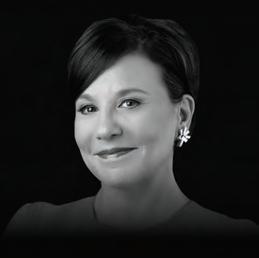
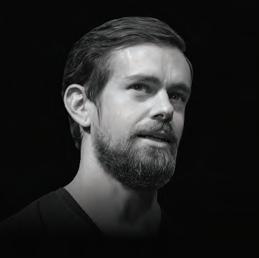



Tom Kalil, an advisor to two presidents and a billionaire, is now working to recruit the ultra-wealthy to fund world-changing science and tech.
BY SEÁN CAPTAIN
Not many people get the ear of the President. Tom Kalil has had that role twice. He sat on the National Economic Council throughout the Clinton administration and was deputy assistant to the President for technology and economic policy, working on projects including the National Nanotechnology Initiative and the BRAIN Initiative to understand nature’s most complex machine. He later spent all eight years of the Obama administration on the Office of Science and Technology Policy. He was deputy director for technology and innovation during the president’s second term.
Kalil has also played prominent roles at the Clinton Global Initiative, UC Berkeley, and the Center for American Progress. Until recently, he worked with multibillionaire Eric Schmidt at the science- and techfocused Schmidt Futures philanthropic organization. Then in May, Kalil launched and became CEO of Renaissance Philanthropy, which aims to recruit high-net-worth individuals, families, and foundations to fund transformational science, technology, and innovation projects.
Kalil joined Worth for a wideranging conversation, which we’ve condensed to focus on the most impactful points.
How would you describe what you’ve been doing in your life?
I think the key is to identify ambitious goals that the nation can and should attempt to achieve and mobilize the resources needed to achieve those goals. I did this for both President Clinton and President Obama, and then, when I left the White House in 2017, I started doing it with Eric Schmidt and [am] continuing to do it now with Renaissance Philanthropy.
Was there a particular event or inspiration that made you want to embark on this course?
I first became interested in these issues because of concerns in the late 1980s that the United States was not investing enough in science and technology and was losing market share—not only in traditional industries like auto, steel, and machine tools but also in high-tech sectors like semiconductors and semiconductor manufacturing equipment. So, one of my first jobs was representing the semiconductor industry in Washington, DC…
In 1992, I went to Little Rock and worked on the issues team of thenGovernor Clinton’s presidential campaign. I had the opportunity to write some of his position papers on science and technology. Then, I got a job working for the National Economic Council to help implement those ideas.
Can you think of one or two times when things didn’t work well and what lessons you took from that experience?
One of the things that really hit me was that the federal government’s capacity to invest in science, technology, and innovation is concentrated in a relatively small number of agencies. For national security, we have agencies like DARPA [the Defense Advanced Research Projects Agency] … I was convinced that we should be making these types of investments, not just for national security but also for other areas, including education and lifelong learning…So we convinced the president [Obama] that this was a good idea and that we should try it out, but ultimately, we could not get Congress to support it. Recently [in 2023], they funded the National Center for Advanced Development for Education, NCADE. So one of the things I take from that is that you should never mistake a clear view for a short distance and that just because you have a good idea doesn’t mean it will happen right away. [Edit note: Kalil confirmed directly and provided that link to the news story.]
A lot of your work has been advising very powerful people. Are there moments of huddling with a president and having a close discussion?
An example of ideas that I worked on that the president got behind and got personally involved in was our work on STEM [science, technology, engineering, and math] education… And that’s an example of something President Obama got personally involved in…
So, for example, we built a coalition of over 300 organizations that were all committed to helping prepare and recruit 100,000 high-quality math and science teachers.
We have universities, the National Science Foundation, DARPA, a lot of VCs putting money into science, tech, innovation. Why is there a need for an additional funding source?
Suppose a philanthropist wants to try something new. In that case, they don’t need to get 60 votes in the United States Senate…[On the other hand], two early career scientists [Adam Marblestone and Sam Rodriques] pointed out that there was a class of really important science and technology projects that was difficult to do as a venturebacked startup...If you brought it to [a VC], they’d say, “Come back to us in X years when the technology has been de-risked.”
These projects are also challenging to do in an academic setting because they require a larger group of people than you have in a single academic lab…So, what they proposed was to create non-profit science startups. So because they’re philanthropically funded, they can work on things that are difficult to monetize. But because they [have] an organizational structure that looks more like a startup, they can do things that would be very difficult to do in an academic setting…
These are projects that are working to lower the cost of mapping the brain by a factor of 100 [E11 Bio], lowering the cost of single-cell proteomics by a factor of 100 to a thousand [Parallel Squared], developing the technology that we need for MRV—the monitoring, reporting, and verification for ocean-based carbon dioxide removal [[C]Worthy].
We’ve been doing research showing that, among younger, high-net-worth millennials, there’s less interest and less giving towards philanthropy and maybe less faith or trust in its effectiveness. How do you take on that challenge?

I think there’s a particular type of agenda-setting that will inspire philanthropy. And it has several elements. The first is the goal. If I told you what the goal is and you were a philanthropist, your view would be, “Boy, I would view that as an important part of my legacy”…The second is the “why now?” What has changed about the world that makes something previously impossible now within reach? And the third is, “Why is there an important role for philanthropy?” How can philanthropy be catalytic of followon funding by either the government or the private sector?
What are some examples of the things that you’re most excited about working on?
One of the projects that is currently being supported is called Forest Neurotech, and it is developing a focused ultrasound on a chip. And this could lead to new minimally invasive brain-machine interfaces that would lead to not only increases
in fundamental understanding of neuroscience, but also in our ability to intervene in things like treatmentresistant depression.
I think that more broadly, there’s an opportunity to leverage not only AI, but other technologies as well. So simulation, self-driving labs, large data sets in ways that have the potential to massively accelerate the pace of scientific research...
If you could speak to our readers, what would you ask of them?
Identify some issue that they’re passionate about and try to work with people who have deep expertise in that domain and who can give them creative ideas for what they could do with their philanthropy… What we’re excited about doing is partnering with those philanthropists and A, finding out what they care about, but B, helping them identify transformational opportunities for them to provide philanthropic support for some of these projects.



In an era of dynamic shifts in financial landscapes and the increasing intricacy of personal wealth management, Worth magazine understands the necessity for guidance that anticipates the needs of the affluent. The Leading Advisors program, which has been recognizing top-tier wealth management firms since its establishment in 2002, is now relaunched with a fresh, data-driven focus. This reinvigoration is more than just a renewal of commitment; it’s a direct response to the evolving demands of our readers searching for reliable and insightful financial stewardship.
The genesis of the Leading Advisor program was to spotlight the prowess and integrity of independent Registered Investment Advisor (RIA) firms that stand out in a crowded marketplace. However, as the financial world has grown in complexity, so too have the concerns of our readers. High-net-worth individuals face various challenges, from navigating volatile markets to planning for intergenerational wealth transfer, requiring sophisticated and personalized advice.
The relaunch aims to address today’s environment by providing a curated list of advisors who are leaders in their field and pioneers in adapting to market changes and the evolving needs of affluent clients. Working with our partners at ISS Market Intelligence, Worth’s editorial staff evaluated more than 41,000 RIAs and financial advisors in the United States and identified the top 300 firms.
The core value of the Leading Advisor program lies in its rigorous selection process and the credibility it bestows upon listed advisors. Each firm featured has successfully cleared stringent benchmarks:
n Assets Under Management (AUM) of Over $500 Million: Demonstrates substantial experience and trust in handling significant wealth.
n Predominantly High-Net-Worth Clients: Shows specialized expertise in managing the complex financial situations typical of wealthier clients.
n Substantial Planning Clientele: Indicates a focus on comprehensive financial planning rather than simple asset management.
n Independence from Broker-Dealers: Ensures advice is unbiased and purely client-centric.
These criteria spotlight firms that manage wealth and craft tailored strategies considering the broader financial picture. Thus, they enhance our readers’ ability to make informed choices about who manages their wealth.
At Worth, our commitment extends far beyond the mere presentation of data. The Leading Advisor program is constructed on a bedrock of editorial integrity and independence, devoid of any influence from the firms we evaluate. This independence is pivotal in upholding our readers’ trust and ensures that our listings genuinely reflect merit and excellence in wealth management. Our methodology is transparent and comprehensive, ensuring that the advisors we feature are among the industry’s best. We believe in the importance of not just growth but growth by design. This means that our
featured firms are actively enhancing their capabilities and offerings to serve their clients better, not merely growing their assets under management by riding market trends.
The relaunch of the Leading Advisor program reaffirms Worth’s dedication to excellence in financial journalism and our commitment to serving as a vital resource for the high-net-worth community. Worth is more than a magazine; it’s a platform where the best in the business converge to discuss, innovate, and shape the future of wealth management.
We will update The Leading Advisor list annually as new company data is released.
If you want to learn more about the list, license the Leading Advisor logo, or learn about Worth’s other marketing capabilities, please contact Kevin Haniffy at Kevin.Haniffy@Worth.com.
Abacus Planning Group, Inc. Columbia, SC
$1,507 M (AUM)
Abbrea Capital, LLC Greenbrae, CA
$1,042 M (AUM)
Aberdeen Wealth Management, LLC
Lake Bluff, IL
$525 M (AUM)
Accredited Investors Wealth Management Minneapolis, MN
$2,956 M (AUM)
Acropolis Investment Management, LLC Chesterfield, MO
$1,737 M (AUM)
Adero Partners, LLC Pleasanton, CA
$3,377 M (AUM)
Agili, PC Richmond, VA
$973 M (AUM)
Alesco Advisors, LLC Pittsford, NY
$4,430 M (AUM)
Align Impact, LLC Santa Monica, CA
$512 M (AUM)
Allworth Financial, LP Folsom, CA
$19,891 M (AUM)
AlphaCore Capital, LLC
La Jolla, CA
$2,325 M (AUM)
Altfest Personal Wealth Management New York, NY
$1,579 M (AUM)
Andersen McLean, VA
$4,217 M (AUM)
Argos Capital Partners, LLC
Saint Louis, MO
$1,390 M (AUM)
Arlington Partners, LLC Birmingham, AL
$6,097 M (AUM)
Armstrong, Fleming & Moore, Inc. Washington, DC
$877 M (AUM)
Aspen Capital Management Boise, ID
$850 M (AUM)
Asset Management Group, Inc.
Stamford, CT
$591 M (AUM)
Atlas Capital Advisors, Inc.
San Francisco, CA
$784 M (AUM)
Atwood & Palmer, Inc.
Kansas City, MO
$1,246 M (AUM)
Austin Asset Austin, TX
$1,266 M (AUM)
Autumn Lane Advisors, LLC
Houston, TX
$896 M (AUM)
Avidian Wealth Solutions, LLC Houston, TX
$3,673 M (AUM)
Avion Wealth Spring, TX
$688 M (AUM)
Bahl & Gaynor Inc Cincinnati, OH
$16,346 M (AUM)
Bailard, Inc.
San Mateo, CA
$5,298 M (AUM)
Baker Street Advisors, LLC
San Francisco, CA
$13,106 M (AUM)
Balentine Atlanta, GA
$4,361 M (AUM)
Ballentine Partners Waltham, MA
$9,287 M (AUM)
Bartlett & Co. Wealth Management, LLC Cincinnati, OH
$6,949 M (AUM)
Bason Asset Management Denver, CO
$618 M (AUM)
BBR Partners, LLC
New York, NY
$24,082 M (AUM)
Beacon Pointe Advisors, LLC
Newport Beach, CA
$23,246 M (AUM)
Beaird Harris Dallas, TX
$1,670 M (AUM)
Bedel Financial Consulting, Inc. Indianapolis, IN
$1,809 M (AUM)
Biltmore Family Office, LLC Charlotte, NC
$2,323 M (AUM)
BIP Wealth, LLC Atlanta, GA
$2,310 M (AUM)
Black Coral Financial Advisors, LLC
Budd Lake, NJ
$810 M (AUM)
Blankinship & Foster, LLC
Solana Beach, CA
$690 M (AUM)
Bleakley Financial Group, LLC
Fairfield, NJ
$9,176 M (AUM)
BlueSky Wealth Advisors, LLC
New Bern, NC
$612 M (AUM)
Bordeaux Wealth Advisors
Menlo Park, CA
$4,007 M (AUM)
Boston Financial Management, LLC Boston, MA
$3,683 M (AUM)
Boston Research and Management, Inc. Manchester, MA
$503 M (AUM)
Bradley Foster & Sargent, Inc.
Hartford, CT
$6,849 M (AUM)
Brandywine Oak Private Wealth, LLC
Kennett Square, PA
$1,184 M (AUM)
Breeds Hill Capital LLC
Charlestown, MA
$1,705 M (AUM)
Bridgewater Advisors, Inc.
New York, NY
$1,904 M (AUM)
Brighton Jones, LLC Seattle, WA
$9,458 M (AUM)
Brown Advisory Norfolk, VA
$6,607 M (AUM)
Bryn Mawr Capital Management, LLC Philadelphia, PA
$2,726 M (AUM)
BSW Wealth Partners Boulder, CO
$1,624 M (AUM)
Burton Enright Welch, Walnut Creek, CA
$923 M (AUM)
Cabot Wealth Management
Salem, MA
$863 M (AUM)
Callan Capital, LLC
La Jolla, CA
$1,477 M (AUM)
Campbell Wealth Management, Inc
Alexandria,VA
$800 M (AUM)
Canal Capital Management, LLC Richmond, VA
$917 M (AUM)
Capital Counsel, LLC
New York, NY
$1,978 M (AUM)
Capstone Financial Advisors, Inc.
Downers Grove, IL
$1,825 M (AUM)
Carret Asset Management, LLC
New York, NY
$3,115 M (AUM)
Cerity Partners, LLC
New York, NY
$53,331 M (AUM)
Certuity, LLC
North Palm Beach, FL
$3,642 M (AUM)
Chatham Wealth Management
Chatham, NJ
$506 M (AUM)
Chequers Financial Management, LLC
San Francisco, CA
$643 M (AUM)
Chevy Chase Trust Company Bethesda, MD
$36,006 M (AUM)
Choreo, LLC Minneapolis, MN
$12,190 M (AUM)
Circle Advisers, Inc.
New York, NY
$675 M (AUM)
Circle Wealth Management, LLC Summit, NJ
$11,627 M (AUM)
Clayton Financial Group, LLC
Saint Louis, MO
$1,197 M (AUM)
Clearstead, Hartland & Co., LLC Cleveland, OH
$10,228 M (AUM)
CMH Wealth Management, LLC Portsmouth, NH
$556 M (AUM)
Coastal Bridge Advisors
Westport, CT
$2,815 M (AUM)
CoastEdge Partners, LLC
La Jolla, CA
$2,167 M (AUM)
Colony Family Offices, LLC
Charlotte, NC
$2,185 M (AUM)
Conservest Capital Advisors, Inc.
Wynnewood, PA
$1,697 M (AUM)
Constellation Wealth Advisors
Cincinnati, OH
$3,047 M (AUM)
Coons Advisors
Columbus, OH
$503 M (AUM)
Corda Investment Management, LLC Houston, TX
$1,447 M (AUM)
Corient
Newport Beach, CA
$118,192 M (AUM)
Covenant Partners, LLC Nashville, TN
$815 M (AUM)
Creative Capital Management Investments, LLC
San Diego, CA
$586 M (AUM)
Creative Planning Leawood, KS
175,272 M (AUM)
Crescent Grove Advisors
Lake Forest, IL
$3,913 M (AUM)
Crestone Asset Management LLC Boulder, CO
$3,647 M (AUM)
Crestwood Advisors Boston, MA
$4,057 M (AUM)
Crewe Advisors
Salt Lake City, UT
$1,621 M (AUM)
Dearborn Partners, LLC Chicago, IL
$3,564 M (AUM)
Diversified Management, Inc. Milwaukee, WI
$1,439 M (AUM)
Douglas C. Lane & Associates
New York, NY
$7,046 M (AUM)
Maslow Wealth Advisors
Austin, TX
$1,429 M (AUM)
Edelman Financial Engines
Santa Clara, CA
$270,770 M (AUM)
Edge Capital Group, LLC Atlanta, GA
$5,219 M (AUM)
Ehrenkranz Partners, LP
New York, NY
$16,601 M (AUM)
Embree Financial Group Chicago, IL
$1,628 M (AUM)
Empirical Wealth Management Seattle, WA
$4,179 M (AUM)
Ensemble Capital Management, LLC
San Francisco, CA
$1,411 M (AUM)
Envoi, LLC Minneapolis, MN
$2,587 M (AUM)
Evensky & Katz, LLC Miami, FL
$2,896 M (AUM)
Evergreen Capital Management, LLC Bellevue, WA
$3,863 M (AUM)
Evermay Wealth Management, LLC Arlington, VA
$800 M (AUM)
Exchange Capital Management, Inc.
Ann Arbor, MI
$610 M (AUM)
F L Putnam Investment Management Co.
Wellesley Hills, MA
$4,303 M (AUM)
FBB Capital Partners Bethesda, MD
$1,636 M (AUM)
Ferguson Wellman Capital Management, Inc. Portland, OR
$7,146 M (AUM)
Fi3 Financial Advisors, LLC Indianapolis, IN
$657M (AUM)
Fiduciary Wealth Partners, LLC
Boston, MA
$1,263 M (AUM)
Fielder Capital Group Nashville, TN
$835 M (AUM)
Financial Advisory Corporation Grand Rapids, MI
$796 M (AUM)
Financial Solutions Advisory Group Chicago, IL
$650 M (AUM)
Firestone Capital Management, Inc. Miami, FL
$593 M (AUM)
Fort Point Capital Partners, LLC San Francisco, CA
$1,157 M (AUM)
Foster & Motley, Inc. Cincinnati, OH
$1,961 M (AUM)
Frank, Rimerman Advisors, LLC
Palo Alto, CA
$1,704M (AUM)
Franklin, Parlapiano, Turner & Welch, LLC
Houston, TX
$651 M (AUM)
Freestone Capital Management, LLC
Seattle, WA
$8,221 M (AUM)
FRG Family Wealth Advisors
Bellevue, WA
$567 M (AUM)
Fulcrum Capital, LLC
Seattle, WA
$746 M (AUM)
Full Sail Capital, LLC
Oklahoma City, OK
$1,477 M (AUM)
Garde Capital, Inc.
Seattle, WA
$1,404 M (AUM)
Geller Advisors, LLC
New York, NY
$5,006 M (AUM)
Geometric Wealth Advisors, LLC
Washington, DC
$680 M (AUM)
GHP Investment Advisors, Inc.
Denver, CO
$1,985 M (AUM)
Gilman Hill Asset Management, LLC
New Canaan, CT
$705 M (AUM)
Glassman Wealth Services, LLC
Vienna, VA
$1,801 M (AUM)
Godsey & Gibb Wealth Management
Richmond, VA
$1,164 M (AUM)
Goodman Financial Corporation
Houston, TX
$580 M (AUM)
Grand Wealth Management, LLC
Grand Rapids, MI
$510 M (AUM)
Granite Group Advisors, LLC
Stanford, CT
$565 M (AUM)
Gratus Capital, LLC
Atlanta, GA
$2,103 M (AUM)
Graypoint, LLC
Albany, NY
$3,372 M (AUM)
Greenwich Wealth Management, LLC
Greenwich, CT
$2,046 M (AUM)
Gresham Partners, LLC
Chicago, IL
$9,527 M (AUM)
Grey Street Capital, LLC Chicago, IL
$1,676M (AUM)
GSG Advisors, LLC
Mount Laurel, NJ
$559 M (AUM)
Guyasuta Investment Advisors, Inc.
Pittsburgh, PA
$1,858 M (AUM)
Hall Capital Partners, LLC
San Francisco, CA
$46,676 M (AUM)
Hamilton Point Investment Advisors, LLC
Chapel Hill, NC
$793 M (AUM)
Haymarket Wealth Management, LLC
Madison, NJ
$526 M (AUM)
HeadInvest Portland, ME
$830 M (AUM)
Heritage Financial Services
Westwood, MA
$1,931 M (AUM)
Heritage Wealth Advisors Richmond, VA
$3,082M (AUM)
HighTower Advisors, LLC
Chicago, IL
$105,230 M (AUM)
Hollow Brook Wealth Management, LLC
Katonah, NY
$957 M (AUM)
Householder Group Estate & Retirement Specialists
Scottsdale, AZ
$1,081 M (AUM)
Howard Financial Services, Ltd.
Dallas, TX
$989 M (AUM)
HTG Investment Advisors, Inc.
New Canaan, CT
$719 M (AUM)
Innovia Wealth, LLC
Grand Rapids, MI
$1,414 M (AUM)
ISTO Advisors, LLC
Troy, MI
$641 (AUM)
IWP Wealth Management, LLC
Denver, CO
$3,631 (AUM)
Jackson, Grant Investment Advisers, Inc.
Stamford, CT
$522 M (AUM)
JFG Wealth Management, LLC
Denver, CO
$648 M (AUM)
JMG Financial Group, Ltd.
Downers Grove, IL
$4,501 M (AUM)
Joel Isaacson & Co., LLC
New York, NY
$5,911 M (AUM)
Johnson Financial Group, LLC
Denver, CO
$1,999 M (AUM)
Johnson Wealth, Inc.
Milwaukee, WI
$7,746 M (AUM)
Jordan Park Group, LLC
San Francisco, CA
$13,733 M (AUM)
Klingenstein Fields Advisors
New York, NY
$4,590 M (AUM)
Klingman and Associates, LLC
New York, NY
$2,777 M (AUM)
Kovitz Investment Group Partners, LLC Chicago, IL
$7,294 M (AUM)
Legacy Advisors, LLC
Plymouth Meeting, PA
$2,803 M (AUM)
Lido
Los Angeles, CA
$13,102 M (AUM)
Lifecycle Financial Planners, Inc.
Bloomfield Hills, MI
$536 M (AUM)
Lindbrook Capital, LLC Calabasas, CA
$2,968 M (AUM)
Linscomb & Williams Houston, TX
$4,257 M (AUM)
LNW Seattle, WA
$11,911 M (AUM)
Lodestar Private Asset Management, LLC Alamo, CA
$831 M (AUM)
Loring, Wolcott & Coolidge Fiduciary Advisors, LLP Boston, MA
$9,688 M (AUM)
LVM Capital Management, Ltd. Portage, MI
$975 M (AUM)
Lyell Wealth Management, LP
Menlo Park, CA
$863 M (AUM)
Main Street Research, LLC
Sausalito, CA
$1,817 M (AUM)
Maple Capital Management, Inc. Montpelier, VT
$1,366 M (AUM)
McRae Capital Management, Inc. Morristown, NJ
$585 M (AUM)
McShane Partners Charlotte, NC
$650 M (AUM)
Meridian Wealth Advisors, LLC Austin, TX
$1,061 M (AUM)
Meritas Wealth Management, LLC Larkspur, CA
$523 M (AUM)
Mill Creek Capital Advisors, LLC Conshohocken, PA
$7,876 M (AUM)
MIO Partners, Inc. New York, NY
$43,715M (AUM)
Modera Wealth Management, LLC Westwood, NJ
$6,801 M (AUM)
Moneta Group Investment Advisors, LLC
Saint Louis, MO
$30,651 M (AUM)
Monograph Wealth Advisors, LLC
El Segundo, CA
$1,783 M (AUM)
Morton Wealth Agoura Hills, CA
$2,378 M (AUM)
Moss Adams Wealth Advisors, LLC
Seattle, WA
$3,334 M (AUM)
Mount Yale Investment Advisors, LLC
Denver, CO
$1,862 M (AUM)
Mozaic, LLC
Beverly Hills, CA
$2,897 M (AUM)
myCIO Wealth Partners, LLC
Philadelphia, PA
$12,007 M (AUM)
NavPoint Financial, Inc.
Prior Lake, MN
$550 M (AUM)
New England Private Wealth Advisors, LLC
Wellesley Hills, MA
$2,359 M (AUM)
NorthRock Partners, LLC
Minneapolis, MN
$4,192 M (AUM)
NorthStar Asset Management, Inc.
Boston, MA
$612 M (AUM)
NPF Investment Advisors
Grand Rapids, MI
$1,996 M (AUM)
O’Brien Wealth Partners, LLC
Waltham, MA
$834 M (AUM)
Oxford Financial Group, Ltd.
Carmel, IN
$15,588 M (AUM)
Paragon Advisors, Inc.
Beachwood, OH
$930M (AUM)
Parkside Advisors, LLC
Berkeley, CA
$523 M (AUM)
Pathstone Englewood, NJ
$48,258 M (AUM)
Paul Comstock Partners
Houston, TX
$2,858 M (AUM)
PDS Planning, Inc.
Dublin, OH
$1,046 M (AUM)
Peak Asset Management, LLC
Louisville, CO
$703 M (AUM)
Pennington Partners & Co., LLC
Bethesda, MD
$1,704 M (AUM)
Perennial
New York, NY
$592 M (AUM)
Personal CFO Solutions, LLC
Chester, NJ
$961 M (AUM)
Pin Oak Investment Advisors, Inc.
Houston, TX
$617 M (AUM)
Pine Valley Investments
Marlton, NJ
$965 M (AUM)
PrairieView Partners, LLC
Saint Paul, MN
$831 M (AUM)
Private Advisor Group, LLC
Morristown, NJ
$28,519 M (AUM)
Private Capital Management, LLC Denver, CO
$1,501 M (AUM)
Proffitt & Goodson, Inc.
Knoxville, TN
$531 M (AUM)
Prowell Financial Management, LLC
Exton, PA
$6,407 M (AUM)
Punch & Associates
Investment Management, Inc.
Minneapolis, MN
$1,773 M (AUM)
QuadCap Wealth Management, LLC
Frisco, TX
$639 M (AUM)
Rappaport Reiches
Capital Management
Skokie, IL
$764 M (AUM)
Relative Value Partners, LLC
Northbrook, IL
$2,226 M (AUM)
Reynders, McVeigh Capital Management, LLC
Boston, MA
$3,655 M (AUM)
Riverview Capital Advisers
Boston, MA
$527 M (AUM)
Roble, Belko and Company, Inc.
Sewickley, PA
$850 M (AUM)
Roffman Miller Associates, Inc.
Philadelphia, PA
$2,094 M (AUM)
Rossmore Private Capital, LLC
Glastonbury, CT
$1,029 M (AUM)
Roundview Capital, LLC Princeton, NJ
$1,175 M (AUM)
RTD Financial Advisors, Inc.
Philadelphia, PA
$1,925 M (AUM)
RZH Advisors, LLC
Stamford, CT
$1,402 M (AUM)
Sage Financial Group, Inc.
Conshohocken, PA
$2,702 M (AUM)
Sand Hill Global Advisors, LLC
Palo Alto, CA
$3,038 M (AUM)
Sargent Investment Group
Bethesda, MD
$1,013 M (AUM)
Satovsky Asset Management, LLC New York, NY
$684 M (AUM)
SBK Financial, Inc. Richmond, VA
$994 M (AUM)
Schaper Benz & Wise Investment Counsel, Inc. Neenah, WI
$1,200 M (AUM)
Schechter Investment Advisors, LLC Birmingham, MI
$2,847 M (AUM)
Sensible Financial Planning and Management, LLC Waltham, MA
$705 M (AUM)
Sequent Asset Management, LLC Houston, TX
$761 M (AUM)
Seven Bridges Advisors, LLC New York, NY
$4,616 M (AUM)
Seven Post Investment Office, LP San Francisco, CA
$6,745 M (AUM)
Shade Tree Advisors, LLC
Saratoga Springs, NY
$619 M (AUM)
Sigma Investment Counselors Northville, MI
$1,699 M (AUM)
Signature Estate & Investment Advisors
Los Angeles, CA
$20,400 M (AUM)
SignatureFD, LLC
Atlanta, GA
$6,147 M (AUM)
Silicon Valley Capital Partners, LP San Jose,CA
$634 M (AUM)
Silvercrest Asset Management Group, LLC
New York, NY
$28,905 M (AUM)
SilverOak Wealth Management, LLC Minneapolis, MN
$1,355 M (AUM)
Simon Quick Advisors, LLC
Morristown, NJ
$5,104 M (AUM)
Single Point Partners Boston, MA
$640 M (AUM)
SlateStone Wealth, LLC Jupiter, FL
$1,370 M (AUM)
Socius Family Office, LLC Fort Lauderdale, FL
$728 M (AUM)
Southeast Asset Advisors, LLC
Thomasville, GA
$3,239 M (AUM)
St. Clair Advisors, LLC Cleveland, OH
$744 M (AUM)
Stack Financial Management, Inc.
Whitefish, MT
$1,701 M (AUM)
Stage Harbor Financial
Needham Heights, MA
$775 M (AUM)
Stansberry Asset Management, LLC
New York, NY
$876 M (AUM)
Steigerwald, Gordon & Koch - Wealth Advisors
Leesburg, VA
$916 M (AUM)
Sterling Investment Advisors, Ltd.
Berwyn, PA
$746 M (AUM)
Stone Point Wealth, LLC
Miami, FL
$321 M (AUM)
Strata Wealth Advisors, LLC
Dallas, TX
$576 M (AUM)
Strategic Wealth Partners
Deerfield, IL
$3,036 M (AUM)
Strategic Wealth Partners, Ltd.
Independence ,OH
$796 M (AUM)
Summit Financial Strategies, Inc.
Columbus, OH
$1,561 M (AUM)
Summit Rock Advisors, LP
New York, NY
$19,852 M (AUM)
Syverson Strege West Des Moines, IA
$666 M (AUM)
Tanglewood Total Wealth Management, Inc.
Houston, TX
$1,207 M (AUM)
The Arkansas Financial Group, Inc.
Little Rock, AR
$667 M (AUM)
The Clarius Group, LLC
Seattle, WA
$3,721 M (AUM)
The Colony Group, LLC
Boston, MA
$18,880 M (AUM)
The Fairman Group, LLC
Wayne, PA
$673 M (AUM)
The Financial Advisory Group, LLC
Houston, TX
$1,176 M (AUM)
The Investment Counsel Company
Las Vegas, NV
$1,181 M (AUM)
The Mather Group, LLC
Chicago, IL
$8,719 M (AUM)
Three Bell Capital, LLC
San Francisco, CA
$2,701 M (AUM)
Tiller Private Wealth, Inc.
Bethlehem, PA
$525 M (AUM)
Tobias Financial Advisors
Fort Lauderdale, FL
$641 M (AUM)
Tolleson Private Wealth Management
Dallas, TX
$7,594 M (AUM)
Tortoise Investment Management, LLC
West Harrison, NY
$1,237 M (AUM)
Total Wealth Planning, LLC Cincinnati, OH
$866 M (AUM)
Tower Bridge Advisors
Conshohocken, PA
$1,866 M (AUM)
True North Advisors, LLC Dallas, TX
$3,006 M (AUM)
Valeo Financial Advisors, LLC
Carmel, IN
$7,104 M (AUM)
Venturi Private Wealth Austin, TX
$1,973 M (AUM)
Veratis Advisors, Inc. Cary, NC
$3,681 M (AUM)
Veris Wealth Partners, LLC
San Francisco, CA
$2,020 M (AUM)
Verity Investment Partners Beaufort, SC
$840 M (AUM)
Wade Financial Advisory, Inc. Campbell, CA
$605 M (AUM)
Waldron Private Wealth Bridgeville, PA
$3,569 M (AUM)
Wallington Asset Management
Indianapolis, IN
$930 M (AUM)
Warner Financial, Inc. Bethesda, MD
$540 M (AUM)
Warwick Partners Bryan, TX
$1,433 M (AUM)
Waters, Parkerson & Co., LLC
New Orleans, LA
$2,303 M (AUM)
Waypoint Capital Advisors, LLC
Minneapolis, MN
$524 M (AUM)
Waypoint Wealth Counsel, LLC Atlanta, GA
$609 M (AUM)
Waypoint Wealth Partners
Mill Valley, CA
$781 M (AUM)
Wealth Architects, LLC Mountain View, CA
$1,486 M (AUM)
Wealthspire Advisors Westport, CA
$2,453 M (AUM)
Wealthstream Advisors, Inc.
New York, NY
$1,075 M (AUM)
Welch & Forbes, LLC Boston, MA
$6,811 M (AUM)
Wellspring Financial Advisors, LLC Cleveland, OH
$ 3,630 M (AUM)
Wescott Financial Advisory Group, LLC Philadelphia, PA
$3,386 M (AUM)
West Financial Advisors, LLC Des Moines, IA
$511 M (AUM)
Westmount Asset Management, LLC Los Angeles, CA
$4,259 M (AUM)
Wharton Business Group, LLC Malvern, PA
$3,421 M (AUM)
Whitney & Company Rochester, NY
$794 M (AUM)
Windsor Advisory Group, LLC Columbus, OH
$1,879 M (AUM)
Woodmont Investment Counsel, LLC Nashville, TN
$1,248 M (AUM)
Zuckerman Investment Group Chicago, IL
$1,259 M (AUM)
ZWJ Investment Counsel, Inc. Atlanta, GA
$2,968 M (AUM)
Disclaimer
Worth magazine is a publisher and does not recommend or endorse investment, legal, insurance, or tax advisors. The listing of any firm in the 2024 Worth Leading Advisors Program is conducted by our editorial team (at times in partnership with certain research organizations) and does not constitute a recommendation or endorsement by Worth magazine of any such firm and is not based upon Worth magazine’s experience with, or prior dealings with, any advisor. The information presented for each firm and/or advisor, including but not limited to any related profile, statistical data, presentation, report, commentary, recommendation, or strategy, has been provided by such advisor and/or third party data sources without independent verification by Worth magazine. Any such information is the sole responsibility of the advisor and/or third party data sources. Worth magazine makes no representation or warranty as to the accuracy or completeness of such information, assumes no liability for any inaccuracies or omissions therein, and disclaims responsibility for the suitability of any particular investment recommendation or strategy for any person. Nothing contained in Worth magazine constitutes or should be construed as any form of investment, legal, insurance, or tax advice or as a recommendation to buy, sell, hold, or trade any securities, financial instruments, or assets. Readers are advised to consult their legal, financial, insurance, and tax advisors prior to making any investment or pursuing any investment strategy. Past, model, or hypothetical performance is not indicative of future results.
BY JENNIFER KIM, MS, CFP ® , CMFC ® , CHFC ® , CLU ®
The numbers can almost make your head spin. Depending on the source, the coming “Great Wealth Transfer” from Boomers to Gen Xers and Millennials can range from $50 trillion (NBC News) to $72 trillion (USA Today) to $90 trillion (CNN). And not to sound flip, but when you’re operating in this sort of monetary stratosphere, what’s $40 trillion here or there?
One could argue that, whatever the actual figure, there certainly seems to be “enough to go around.” But the real question is: How much and to whom will this astronomical sum “go around”?
Begin with the danger of lumping a group by any single measure, in this case age. That is, 44-to-59 year olds (Gen X) and 28-to-48 year olds (Millennials). Shouting about a multi-trillion-dollar wealth transfer can leave the impression that everyone in these age groups will hit the inheritance lotto. Most will not, of course, but some will. However, even recipients operating in the upper reaches of this financial boon might want to hold off yacht shopping until mom and dad leave the bonds of earth.
Putting aside for a moment how we might counsel those heirs on the financial nuts-and-bolts of planning for a large financial influx, and the importance of doing
ABOUT THE ADVISOR

that while the benefactors are still with us, another important question vis a vis the Great Transfer is this:
Will those hyped sums actually materialize and find their way into future generations’ bank accounts? One major reason they may not: Unforeseen expenses, especially as regards healthcare for the benefactors.
While CNN seems optimistic about the Transfer with this March 1, 2024, headline:
“Millennials Stand to Become the Richest Generation in History, After $90 Trillion Wealth Transfer,” other media outlets sound warnings. For example:
An NBC December 29, 2023, headline reads, “The ‘Wealth Transfer’ from Boomers Won’t Save Gen X and Millennials,” and the story states, “Experts say baby boomers will give more than $50 trillion to their heirs. But for many, health care costs will claim the bulk of that wealth.”
And USA Today concurs with this April 1, 2024, headline, “Hey, Gen X, Z and Millennials: Here’s Why You May Miss Out on the Great Wealth Transfer.” The headline is followed by a story that opens with a description of how the health misfortunes of one wealthy Boomer couple drained dry their financial legacy.
Our purpose here is not to put a negative spin on the Great Transfer phenomenon, but to caution both the givers and receivers of the Transfer to, quite simply, plan now, while all are present, no matter how great or small the Transfer amount.
And what of those offspring of ultra-high net worth benefactors who do, in fact, receive a lotto-size windfall intact? While they may have lived an affluent life growing up, including already having a yacht, a sudden influx of assets could trigger a dramatic shift in multiple aspects of their lives. Not to mention, it may exacerbate frictions among siblings. For example:
Let’s say there are three millennial siblings of a successful entrepreneur. One became an artist, one a social worker, and one worked for years with the founder running and building the business. Should all three receive an equal share of those millions?
And on a much larger societal scale, will this influx of money into the hands of the already wealthy worsen the widening divide between the different financial strata in our society?
In short, the “Great Wealth Transfer,” like all things in life, has many layers and subtleties that need addressing. And the best place to start is to sit down, now, with all family members in attendance, and with a proven financial professional guiding the discussion.
jkim@seia.com
Jennifer Kim, MS, CFP®, CMFC®, ChFC®, CLU®, Managing Senior Partner at SEIA, brings over two decades of experience in investment management and insurance, specializing in estate planning, retirement planning, and corporate benefits. She’s a licensed independent insurance broker with Signature Comprehensive Insurance Services, LLC (CA Insurance License #OB11807). Since 1993, Jennifer has contributed to Worth Magazine and Investors Business Daily through multiple articles covering a diverse range of financial topics, and has also been featured in Los Angeles Magazine, Angeleno, and Vanity Fair. Actively engaged in community service, she serves as President of the Harvard Westlake Korean American Parent Association and on AVIVA Family and Children’s Services’ financial committee. An alumna of Chi Alpha Delta sorority at UCLA, Jennifer supports charities like the National Giving Alliance (NGA) and Covenant House. She resides in Los Angeles with her husband and four children Jennifer holds a Bachelor of Arts in Economics
$20.3 Billion in assets managed by SEIA and its affiliates as of 3/31/2024. from UCLA and a Master of Science in Personal Financial Planning from the College for Financial Planning. She became a CERTIFIED FINANCIAL PLANNER™ practitioner in 1998 and has earned additional professional designations including Chartered Life Underwriter® (CLU®) and Chartered Financial Consultant® (ChFC®) from The American College of Financial Services, and completed the Chartered Mutual Fund CounselorSM (CMFC®) education program in 1999.
Disclaimer
The reported Assets Under Management (AUM) represents the combined total of Signature Estate & Investment Advisors, LLC (SEIA) and its affiliated entities as of 3/31/2024. AUM includes portfolios continuously supervised or managed by SEIA and its affiliates. The AUM encompasses assets like stocks, bonds, ETFs, mutual funds, and cash, among others. For more details on the professional designations listed above, including description, minimum requirements, and ongoing education requirements, please contact (310) 712-2323 or visit seia.com/disclosures. SEIA is an SEC-registered investment adviser; however, such registration does not imply a certain level of skill or training and no inference to the contrary should be made. Securities offered through Signature Estate Securities, LLC member FINRA/SIPC. Investment advisory services offered through SEIA, 2121 Avenue of the Stars, Suite 1600, Los Angeles, CA 90067, (310) 712-2323. seia.com







































STERLING INVESTMENT ADVISORS

TANGLEWOOD TOTAL WEALTH MANAGEMENT


































THE COLONY GROUP SIGNATURE ESTATE & INVESTMENT ADVISORS
































































STONE POINT WEALTH

VERITY INVESTMENT PARTNERS


The Milken Institute Global Conference ‘24 brought together the best in the world to partner in tackling the world’s toughest issues.
This spring, The Milken Institute’s 27th annual Global Conference took place in Los Angeles at The Beverly Hilton. Over the course of four fast-paced days and attracting more than 4,500 attendees, it featured panels on everything from the climate crisis to the perils of AI to equitable clinical trials in healthcare. Speakers ranged from Bill Clinton to Elon Musk to ousted House Speaker Kevin McCarthy to Emmy winner Kerry Washington. The ultimate aim? According to Milken Institute CEO Richard Ditizio, the conference hopes to create a space where brilliant people “bring their best thinking to the world’s worst problems.” Worth Media was honored to be a media partner.
Here are some highlights (by subject):
The biggest takeaway in this sphere, at least when it came to generating headlines, was Musk’s pronouncement that he didn’t see a place for AI in the space exploration arena (yet). But more extensive and substantive conversations were had on the topic, among them: the “AI’s Ethical Frontier: Responsible Regulation…By Whom?” panel. Rapper/ producer will.i.am, California Attorney General Rob Bonta, and Undersecretary for Policy at the U.S. Department of Homeland Security Rob Silvers discussed whether federal or state regulations were the best path forward when it came to creating policy frameworks. Also discussed was the role of business’s accountability—and in a theatrical but powerful twist, will.i.am engaged a chatbot of his own making to talk ethics and technology.
Protecting the environment is key to the Milken Institute’s mission, and a plethora of panels addressed it. “Climate Outcomes 2035: New Pathways to Accelerate Capital Deployment for Net Zero and Nature” featured Deputy Assistant Secretary of Climate at the Department of the Treasury Adam Wang-Levine and ClimateWorks CEO Helen Mountford talking about options to better reach the Paris Agreement’s goals. The “Rewriting the Rules of Global Conservation” panel featured Jennifer Morris, the CEO of the Nature Conservancy; and Iván Duque Márquez, the President of Colombia, discussing ways in which ecology and economics are intertwined. Also unveiled at the conference was the winner of The Milken-Motsepe Green Energy Grand

Prize: the initiative Aftrak. Its solar microgrids and custom tractors have increased farmer income, tripled agricultural yields, and brought electricity to remote parts of Africa. It was awarded $1 million.
Diversity, Equity, and Inclusion
Again, controversy ruled the day—at least in terms of media coverage. When New York Governor Kathy Hochul was describing her aim to make technology more widely accessible, she said, “Right now we have young Black kids growing up in the Bronx who don’t even know what the word ‘computer’ is.” (The New York Times devoted an article to the gaffe. Hochul said she misspoke and regretted it.) But insight was found in other discussions on the topic. “The DEI Shake-Up: Assessing Progress and Pushback” featured Pershing Square Capital Founder Bill Ackman and Operation HOPE Chairman John Hope Bryant. It approached affirmative action through the lens of data specifically. Also during the conference, the Milken Institute honored the graduates of its Historically Black Colleges and Universities Fellowship program with a ceremony, and featured the panel “Powering Progress: HBCUs as Hubs for Talent and Innovation.”
To be sure, this is the tip of the iceberg when it comes to the 200 panels at the conference. In parting, Ditizio again offered words of wisdom to attendees. “When I welcomed you a few days ago, I noted that the only way we’ll be able to tackle these challenges…is by finding partners able to work together,” he said. “[So] don’t buy into the easy pessimism…Challenge yourself with the harder, brighter path of being an optimist. And look for [others]…to walk with you on this journey.”

The green path is bumpy. Electric cars are moving from early-adopter euphoria to slower mainstream acceptance (p. 98). Battery-powered air taxis may soon debut—maybe not in the U.S. (p. 100). Investors are still looking for the right formula for grid-scale batteries (p. 104). And experts share ideas on how to incentivize more climate progress (p. 106). Plus, what basic understanding do we all need to make the most of AI (p. 102)?
Innovators and early adopters drove the initial boom. Now, we’re confronted by the reality of persuading the majority.
BY GABRIELLE DORÉ
Tesla CEO Elon Musk recently sent a company-wide email stating, “We have made the difficult decision to reduce our headcount by more than 10% globally.” That’s over 14,000 employees.
Musk stated that this new batch of layoffs is due to a “duplication of roles”; however, there is a more plausible culprit. For the first time in the company’s history, its stock has been down over 31% year-to-date, as reported by Business Insider. Furthermore, Fast Company reports that sales have fallen by 8.5% each year since 2020. The company’s analysts describe this as a disaster, as some of Tesla’s competitors—such as Hyundai, Kia, Toyota, and BMW— have increased their sales in Q1.
But Tesla isn’t alone. Ford, for example, has recently announced a delay in rolling out its new electric pickups and SUVs line. Ford explained that it will first work on adding gas-electric hybrids, citing a slower-than-expected EV sales market as the reason for the change.
EV MARKET
ISN’T
Over the past few months, we have all heard about how the slowing EV market keeps us from hitting our CO2 emission-reduction goals. But there is no reason to panic, as the industry follows the natural product adoption process.
Any marketing or sociology course will likely include Everett M. Rogers’s idea of the “adoption curve.” It details the degree to which consumers adopt a new technology or product. Any population can be split into five categories: innovators, early adopters, early majority, late majority, and laggards.
Innovators make up about 2.5% of the overall population. They’re eager to try anything new, not scared off by risk or the idea of failure. You can find them on crowdfunding sites like Indiegogo or Kickstarter, where they still invest in products in their conceptual stage.
Then you have early adopters, who make up a whopping 13.5%. They’re willing to work around or ignore kinks in a product. But unlike inno-
vators, they’re not as willing to risk failure. Thus, they’ll test it out before preaching it to the choirs. Think of them as the first people to own a Blackberry or iPhone. Were there bugs? Yes. Did they care? No. Did they preach about the usefulness of either product? Also, yes.
Then, you get to the early and late majority, who comprise 68% of the population together. The only real difference between the two is that the early majority is more trustworthy of data that shows a product or technology does solve a problem, at which point they are willing to try it out.
Lastly, there are laggards, who make up the remaining 16%. These few refuse to try new tech even if a product is objectively better than its predecessor. They won’t naturally adopt it; instead, they must be convinced of its use and value repeatedly before they even think it might be worth a look.
DID THE CONSUMERS GO?
So, how does this connect back to Tesla and EVs?
Environmentalists, journalists, and market analysts alike were

excited about early growth because they looked at sales data driven by innovators and early adopters. We’re confronted by the reality of persuading the majority—which takes time. We jumped the gun in our excitement.
Let’s be honest: EVs have kinks that most do not want to deal with. Consumer Reports’ latest annual car reliability survey found that “EVs from the past three model years [have] 79% more problems than conventional cars.” The most common issues are with the battery and charging system, which would be the equivalent of a traditional car having an issue with its gas tank.
If you’re wondering where the majority is comfortable, that’s hybrid and plug-in hybrid electric vehicles (PHEVs). The latter cars can run on battery power for an average day around town and then switch to a gas-electric mix if they have to go further. When Pat Ryan, CEO of the

car shopping app CoPilot, spoke with NPR, he stated, “The mainstream has adopted hybrids, so hybrid sales are white-hot.” Also, some PHEVs qualify for federal tax credits.
Going back to the iPhone example, we can use its adoption as a roadmap of expectations for EVs. Innovators bought the product in 2008-2009; the early adopters then naturally came in with the iPhone 3GS as the product still had some bugs but nothing that would risk failure. Then, with the iPhone 4, the market exploded in 2012. The early and late majority saw the mountain of evidence on how having constant access to their emails and the internet added something to their personal or professional lives but without the bugs. But that was after three years of innovators and early adopters acting as the guinea pigs.
“With EVs, we are currently in limbo between the early adopters and the early majority because of persisting issues with charging, speed, range and overall reliability—just like the iPhone before the 4.”
With EVs, we are currently in limbo between the early adopters and the early majority because of persisting issues with charging speed, range, and overall reliability—just like the iPhone before the 4. To have the same boom as the iPhone, EV automakers must do what Apple did—a complete upgrade.
The iPhone 4 introduced now staple features, including the retina display and Facetime. Overall, it had over 100 new features and upgrades. Steve Jobs effectively took an iron to all of the 3G and 3GS’s wrinkles (antenna gate notwithstanding), such as spotty network connections and issues caused by the battery. Sound familiar?
So, as EV production begins to roll back to a more realistic pace, note that this is due to a combination of the natural adoption cycle and the need for automakers to iron out EVs’ proverbial wrinkles.
Nations like the United Arab Emirates are marshaling funds and regulatory support more aggressively than the electric planemakers’ home country is.
BY SEÁN CAPTAIN
Since even before the Wright Brothers, there have been attempts—some with modest success—to build a flying car. Although a practical road, and airworthy vehicle looks no more likely than a century ago, planes that do the job of taxi cars may arrive soon. And while the U.S. has been a leader in “flying car” efforts over the years, it may not be the first place where service takes flight.
IN
Two of the world’s top air taxi companies—U.S.-based Archer Aviation and Joby Aviation—recently announced plans to launch electric plane services in the United Arab Emirates as soon as 2025. Both companies are active in the U.S., too. Archer is partnering with United Airlines for service in New York City, Los Angeles, and the San Francisco Bay Area. Joby and Delta Airlines are also targeting New York and LA. However, the UAE may come first, thanks to generous funding and regulatory flexibility.
In February, Joby announced several deals, including an agreement with Dubai’s Road and Transport Authority that Joby says will provide it a six-year monopoly in the UAE’s biggest city. (Archer disputes this and says it will be able to operate in Dubai and any other emirate anytime.) Joby also signed a deal with a company called Skyports to build four helipads, or “vertiports,” in the city.
“The infrastructure piece is being addressed in this partnership, which makes it feel a bit more real,” says Evan Deahl, engagement manager at Alton Aviation Consultancy. (According to Deahl, Alton has no business relation-
ships with companies covered in this article.)
On March 22, Joby’s president of operations, Bonny Simi, told Bloomberg that “we’ll be able to launch in Dubai first.” She was less definitive when I asked her to confirm. “Joby has several routes to launching early commercial operations, including in the United States via obtaining our FAA type certificate and in the United Arab Emirates through our work with the GCAA, the local regulatory authority,” she wrote in an email. Simi added that “the government agencies of both Dubai and Abu Dhabi have consistently demonstrated their commitment to being world leaders in the adoption of this technology.”
Then in April, Archer announced what it called “multi-hundred-million-dollar investments” with the Abu Dhabi Investment Office, including building vertiports in the Emirates’ capital. Archer is also locating its international headquarters in Abu Dhabi and will manufacture planes in the country. Asked if this meant the UAE would be its debut country, Archer’s chief commercial officer, Nikhil Goel, didn’t quite answer, but said, “There’s no other city in the world where I’ve seen so much support and
positive responses as I have in Abu Dhabi.”
The reticence to outright commit, or continue committing, to a UAE debut may be for fear of ruffling feathers. NASA technologist Mark Moore kicked off the air-taxi movement in 2009 with a design concept for eVTOL (electric vertical takeoff and landing) aircraft that rise up like helicopters, then typically reconfigure into airplanes for more efficient flight. (A few, such as China’s EHang and Germany’s Volocopter, fly like quadcopters or helicopters, but tend to have shorter range.)
With NASA as the mother and the Federal Aviation Administration as a (mostly) enthusiastic stepfather, eVTOL has become a source of pride for the U.S. However, other countries may make it easier.
“There are some key success factors for…rapid launch for vehicles in certain markets,” says Deahl. One is government funding, which Goel also calls out. “In order to launch air taxis in the UAE, you’re going to need, at the very least, half a billion dollars,” he says. “The UAE has made it incredibly economically attractive for us to do that without taking on any additional economic burden.”
The Emirates may also show more regulatory flexibility, says Deahl, including perhaps allowing planes to fly experimentally before they are fully certified. In contrast, a June 2023 report from the Department of Transportation’s Inspector General called out the FAA for hampering eVTOL adoption due to “regulatory gaps and lack of consensus”—which the agency said are addressed in a new “blueprint” plan.
It’s also critical, says Deahl, to have customers willing to buy what he expects to be pricey tickets—despite Archer and Joby saying they will be in line with a high-end Uber ride. Goel says that Archer likely won’t subsidize rides to kickstart the business, unlike car service in the early days of Uber (where he worked on the company’s now-defunct air taxi program).

Then there’s public acceptance. “Particularly in the United States, there’s this concept of nimbyism,” says Deahl. He points to the Santa Monica airport closing due in part to noise and pollution complaints. EVTOLs are far cleaner and quieter than traditional planes and helicopters, but perceptions could be hard to overcome.
There’s plenty of competition beyond the UAE. The latest “Market Map“ by Unmanned Publications Ltd. lists 207 cities in 57 countries that are pursuing programs. “I actually expect the bulk of the urban air taxi market to be outside of the U.S.,” says Goel.
Joby’s international efforts focus on wealthy countries. “We are also laying the groundwork for service in the United Kingdom, South Korea, and Japan,” writes Simi. (Rival Volocopter aims to introduce flights in Paris around the Summer Olympics. It’s also targeting Rome, Osaka, and Neom in Saudi Arabia.)
Archer is looking farther. “I think India will be the largest urban air taxi market in the world,” says Goel. Archer is partnering with InterGlobe Enterprises, a travel and hospitality conglomerate that includes the coun-

try’s largest air carrier, IndiGo, with an agreement to buy up to 200 of Archer’s four-passenger Midnight aircraft for $1 billion. They will collaborate with other companies to build vertiports, train pilots, and operate planes.
U.S. eVTOL maker Eve is planning to launch with partner carrier Hunch in Bangalore in 2026 (and in San Francisco with United Airlines the same year).
Alton also expects competition from UAE neighbors Saudi Arabia, Bahrain, and Oman. “They are governments who are keen to be innovators and keen to take a more prominent space on the global stage,” says Deahl. With miles of desert or water between cities, their geographies make short-hop air travel appealing. (The four-passenger Joby S4 and Archer Midnight, for instance, can fly about 100 miles per charge.) Other areas with rough terrain, such as Malaysia, are also key markets, says Deahl.
In China, “The government is extremely supportive of developing what they call a ‘low altitude economy,’” says Deahl’s Singapore-based colleague, Alan Lim. In December 2023, China’s EHang became the first company to have a government-certified eVTOL— and an autonomous one, to boot. It
also announced a partnership with Wings Logistics Hub to work towards certification in the UAE and sell up to 100 aircraft.
EHang’s two-person EH216-S quadcopter has a range of just 35 km (22 miles). “Its capabilities are limited to tourism and demonstration flights,” says Deahl, but he expects EHang’s VT-30 to be the key player once certified. A combination copter and plane (like most eVTOLs), this two-seater has a promised range of 300km (186 miles).
The winning plane maker and country may depend on certification timetables, as most governments have similar guidelines. “I expect all of them will finish around the same time, plus or minus three to six months,” says Goel. But the first services will be modest. “We’re not going to go throw 200 aircrafts in New York City airspace,” he says. “It’s going to start with a dozen aircraft.”
It’s not the first planes that matter, but the first dense network of them, says Joshua Ng, another Alton analyst executive based in Singapore. “I think we need to think about, when is there going to be 100 eVTOL aircrafts flying anywhere?” he says.
Artificial intelligence will play an ever-more important role in our lives. What skills do individuals and workforces need to be successful?
BY CHRISTOPHER ALLBRITTON
Artificial intelligence integration in workplaces is set to leap from under 5% in 2023 to more than 80% by 2026, according to research firm Gartner, and many employees are already eager to level up their tech skills. LinkedIn’s 2024 “Workplace Learning Report” found that four in five employees want to improve their proficiency with AI.
This upskilling will require understanding AI’s capabilities and limitations, knowing how to spot and manage its “hallucinations,” and grasping the legal and ethical implications.
Wharton School professor Ethan Mollick wrote in his new book, Co-Intelligence, that out of 1,016 professions studied by several research teams, “AI overlaps most with the most highly compensated, highly creative, and highly educated work.” Only 36 professions had no overlap. (Dancers and bricklayers are pretty safe, while telemarketers are on the endangered species list.)
Jobs, he writes, are a collection of tasks, including, in his case, writing, editing, researching, teaching, filling out paperwork, and other grinds. AI can take over some of those tasks, freeing us up to use our unique human talents to manage and curate AI’s output.
Oded Netzer, a professor at Columbia Business School and the author of Decisions Over Decimals: Striking the Balance between Intuition and Information, put it bluntly: “You won’t be replaced by AI, but you will be replaced by someone who knows what to do with AI.”
Many of the experts I spoke with think that AI literacy in the coming years will mean understanding the technology’s technical, practical, and ethical aspects, summed up by three questions: Can AI do this task? How do I get it to do this task? And should it?
“Learning about the limitations and strengths of AI systems, I think, is going to be a really important part of AI literacy,” said NYU Stern School of Business professor Arun Sundararajan. This understanding, he said, could include knowing the difference between traditional computer programming and machine learning (ML).


New battery technologies promise better, cheaper grid storage.
BY MICHAEL PUTTRÉ
As intermittent power sources, solar photovoltaic and wind energy require “baseline” power to fill in. That typically comes from traditional sources including coal, gas, and nuclear power. But utilities are increasingly exploring energy storage systems that charge up on renewable energy to provide that backup power instead.
Lithium ion is the go-to technology for utility-scale batteries; however, it is an imperfect solution for long-duration energy storage, known as LDES. A report from the U.S. Government Accountability Office said that while lithium-ion batteries remain popular in the utility sector, high demand in other industries makes them an increasingly expensive solution. Also, the GAO reported other risks for grid operators, including fire and limited battery life. Perhaps most importantly, lithium-ion batteries do not have the storage capacity to last through the night or to ride out extended power outages.
Some utilities are investing in other grid battery options for LDES as alternatives to fossil fuels or expensive lithium-ion batteries. The catch is that some of these technologies are relatively new commercially.
Kara Rodby, a principal at Volta Energy Technologies, an Illinoisbased venture capital firm focused on energy storage, said the problem is that the alternative battery sector is dominated by startups just this side of the laboratory. These companies rely on investors rather than commercial orders for funding.
“There’s no doubt that LDES techs make more economic sense for eightplus-hour storage needs,” Rodby said, “but there’s a chicken-and-the-egg problem of when that market will be developed and when startups can deliver a product at their theoretical price points.
Market uncertainty is underscored by the fact that most LDES battery tech companies are upstarts rather than established manufacturers with long track records. Rodby said utilities interested in LDES tend to want to partner with potential suppliers—who may front much of
the costs—on pilot projects rather than fully committing to a tech provider that might not be around in five years.
Yet, power providers have to start somewhere. Arizona’s Salt River Project (SRP), a not-for-profit utility near Phoenix, plans to expand its existing 20 MW of solar capacity rapidly. It will add 55 MW, which it says is enough to power 12,000 homes. The company has contracted 2,000 MW of its goal to add 2,500 MW of new solar by 2025.
Arizona’s solar resources are among the best in the world. Even so, they provide peak capacity for only about one-third of the day, according to Jerald “Chico” Hunter, manager of innovation and development at the SRP. “You solve any intermittency issues as a consequence of building long-duration storage for night use,” Hunter said.
Looking for alternatives to lithium-ion cells, SRP chose Germanybased CMblu Energy for a 5 MW pilot project using the company’s SolidFlow batteries based on flow battery technology. These store energy in separate electrolyte tanks, one posi-
tive and the other negative, that is pumped into contact across a membrane to discharge electricity (or for recharging). Unlike lithiumion batteries, tanks can be sized to fit storage requirements and discharge over extended periods. CMblu’s batteries use solid carbon to increase storage density and are modularized for stacking.
The company says the system can power about 1,125 homes for 10 hours. Hunter said that he appreciates the fact that the technology is new. Still, CMblu has utility-scale projects underway in Austria and Wisconsin and claims to have a secure supply chain for its components.
“Markets where there’s higher solar penetration are important in terms of driving that longerduration storage,” said CMblu USA president Giovanni Damato. “We’re seeing that in Arizona and California, really across the southwest. As solar spreads, LDES will increase penetration across the U.S.’’
Beyond lithium-ion and flow batteries, more exotic approaches, such as thermal batteries that store potential energy as heat, are emerging from laboratories and moving toward commercialization. Boston-based Fourth Power, for example, is building a 1 MWh demonstration facility that stores energy in molten tin.
Volta’s Rodby said that renewable energy penetration is certainly driving LDES development. However, startups will need to grow customers and production lines to become thriving suppliers.
“Overall, I think this is where strategic engagement can help make an investment case,” she said. “A utility company might be able to buy enough units to drive down that cost. I personally look for partnerships that are clearly trending towards a real commercial partnership, as demo projects and pilots are a dime a dozen.”
Shifts in science, economics, and politics are creating the need for new motivations to get both individuals and large organizations on board.
BY MARSHALL HONOROF
At the April Techonomy Climate West 2024 conference, everyone wanted to save the world for a different reason. Gen Z will be living here for a long time to come. Scientists emphasize that humans aren’t the only creatures on our planet. The tech industry aims to put advances in AI and robotics to work. Big business sees financial opportunities.
The event featured 22 speakers who tackled climate change from scientific, industrial, financial, technological, and nonprofit perspectives. They discussed everything from robotics to biodiversity to social activism to conscious capitalism (the idea that investments should serve society at large). But one throughline came up again and again: incentives.
Finding compelling incentives and appealing to them can motivate behavioral changes in a way that more general principles can’t. As humans face a new environmental reality, spurring them into action may be climate mitigation’s next big challenge.
In his presentation “The Conscious Consumer,” Kedar Karkare, cofounder of Karma Wallet, discussed how individuals can use their personal finances to promote change. When people buy goods and services from popular brands, they want to know whether those brands use their profits for good or ill.
“[U.S.] consumers spend $17 trillion a year on daily purchases,” Karkare said. “There is this growing
movement, which I felt in myself, that I’d like to try and use my money to make a difference.”
Karkare observed that to instigate substantive societal changes, only about 3.5% of the population must participate in some form of political action. Furthermore, nonviolent movements tend to be more effective than violent ones—and choosing where to spend your money is about as nonviolent as it gets. Karma Wallet aspires to be a social revolution through a payment app. (Disclosure:
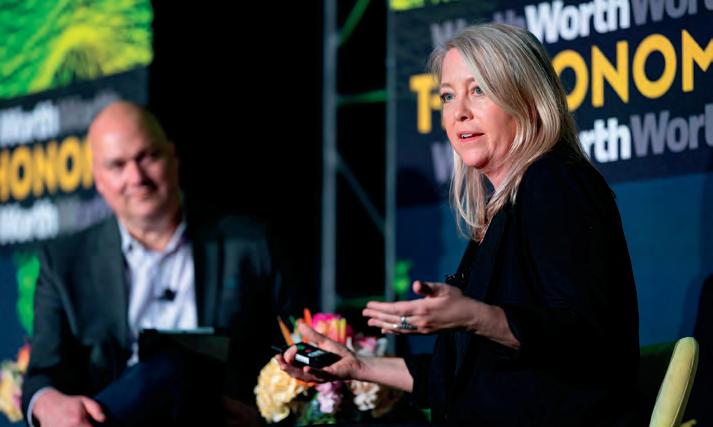
Worth is collaborating with Karma Wallet on research projects.)
Karma Wallet evaluates thousands of businesses and determines whether they practice what they preach. The organization draws data from more than 40 sources, including environmental advocacy groups, corporate initiatives, and government agencies. It then rates companies based on their performance in four categories: sustainability, climate action, community welfare, and diversity and inclusion.
Karma Wallet is only five years old. Karkare and his team are still ironing out where their data comes from and how to weigh independent research against company-provided information. “The data, to some extent, is out there,” Karkare said, “so let’s just pull it into one place.”
Millie Baird, vice president of the Environmental Defense Fund, and Karen Tuxen-Bettman, senior program manager at Google, gave a presentation called “Tackling The Methane Challenge From Space.” In it, the two researchers discussed how even the fossil fuel industry can adopt better practices when profits are on the line.
Methane accounts for 16% of global greenhouse gas emissions, and traps heat almost 30 times more effectively than carbon dioxide. According to Baird, finding a way to curb methane levels could have outsized benefits, especially since repairing leaks is both simple and cost-effective.
“If we’re talking about making a difference in our lifetimes, the leverage you get from looking at methane is enormous,” Baird said.

Baird and Tuxen-Bettman discussed their methane monitoring pilot program, which took place in Oakland, California. While a local environmental justice group had previously attempted to alert people in power to the dangers of methane leaks, it was challenging to do so without hard data on the topic.
To gather that information, the EDF did something unprecedented: It launched its own satellite. MethaneSAT can accurately measure gas levels from space, honing in on millions of sources across 50 different regions on Earth. The data from MethaneSAT will be publicly available, meaning that scientists, activists, government agencies, and fossil fuel companies will have access to it.
“It’s even more powerful when we all have that knowledge,” Baird said. “That’s the accountability piece. That’s the incentive that [big companies] need.”
Raj Kapoor, cofounder and managing partner of VC firm Climactic, gave a talk entitled “Investing In The Second Wave of Climate Tech.” In it, he discussed how the tech industry can help fight climate change—as long as it frames its solutions as potentially profitable.
“What is the software and hardware and technology that can be created that can lower emissions but also provide business value at the same time?
That double-win is aligned with capitalism,” Kapoor said.
For tech companies to sell green initiatives—and, in turn, help to fight climate change—they’ll have to convince big businesses that climate mitigation is cheaper than the alternative.
“I don’t think we’re going to get big impact in climate without for-profit,” Kapoor said.
He cited a company he’s currently evaluating for investment as an example (which he declined to name).
This business produces induction ovens and stoves, which may soon be in high demand in New York City. Last summer, the NYC Housing Authority announced that it would replace tens of thousands of gas stoves with induction models.
Kapoor also touched on the confluence of robotics, AI, and synthetic biology in assisting climate mitigation.
“We have to install 10 or 20 times the amount of solar to meet [our] needs … and there’s just no way humans can do it fast enough,” he said.
Training robots to mimic complex human behaviors, such as picking up panels and navigating outdoor environments, seemed intractable. However, Kapoor suggested that AI allows robots to “learn” these skills much faster.
“There are a dozen startups. And they’re all showing progress on less than $1 million,” he said.
Justin Winters, cofounder and executive director of the nonprofit One Earth, gave the day’s final presentation, “Identifying The Next Generation of Nature Preserves.”
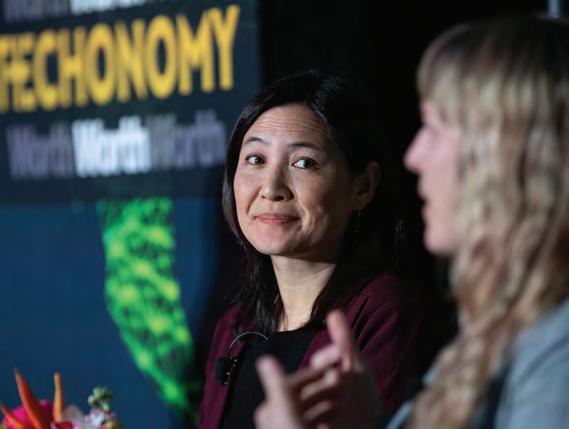
“We’re in a moment where there are no silver bullet solutions,” she said. “There is not one single technology that will solve all of this.”
Winters discussed the One Earth Climate Model, which drew data from more than 50 academic, corporate, and nonprofit sources. The model proposed limiting Earth’s global temperature increase to 1.5 degrees Celsius by 2050. But that could only work if a dozen major industries launched complex decarbonization initiatives.
One Earth proposes three pillars of climate mitigation. The first is a transition to 100% clean, renewable energy by 2050. The second is restoring 50% of Earth’s land and oceans for the proliferation of native flora and fauna. The third is employing regenerative agriculture to renew farmlands and reduce food waste.
Each pillar has dozens of smaller steps, from improving public transportation to promoting meal planning. But each step also offers concrete incentives. For example, individuals could benefit from eating more sustainable diets, while corporations could benefit from government initiatives in green tech.
Winters also explained that only about 3% of investments in climate mitigation go toward nature conservation. Less than 2% of philanthropic capital funds climate and environment organizations.
“Philanthropy could play a radical role in helping us solve this, but people must embrace it as a leading strategy.” (This is one focus for Renaissance Philanthropy, founded by Tom Kalil, profiled on p. 86.)
The reward would be a technologically progressive, culturally diverse, and ecologically rich planet.

Following the annual Watches & Wonders fair in Geneva, here are the watches that best represent the trends we expect for the year to come.
BY CAIT BAZEMORE
Each spring, the global watch industry sets its sights on one moment: the annual Watches & Wonders fair (the New York Fashion Week of watches). For the event, retailers, media, and collectors flock to Geneva to be the first to experience the newest timepieces from top brands and get a pulse on the latest trends, we can expect to see for the launches that will continue to roll out through the remainder of the year. The week of the fair is jam-packed—a whirlwind of watches upon watches that quickly blur together into one collective timekeeper. But as the dust settles, a few models rise to the surface, and specific colors, textures, shapes, and concepts emerge. At the start of 2024, you may remember our predictions for the trends we anticipated and hoped to see. Now, in the wake of a massive influx of new models into the market, the results are in. And guess what? We nailed some significant themes we’re seeing across the industry.
In 2021, Hermes unveiled a new flagship collection called the H08. With a sporty design incorporating materials like graphene composite and DLC-coated titanium and a larger 39mm build, the model took on a more masculine edge. This year, the brand shifted its focus on its female client base with a more modestly sized counterpart to the H08—enter the Hermes Cut. While the Cut is marketed as a women’s watch, the base model is firmly unisex. It features a 36mm case (possibly the most accessible size a watch can be) and a classic stainless steel construction, available on a bracelet or rubber strap. The bracelet version is incredibly versatile and effortless daily wear, while the other variations get a more feminine twist with two-tone options or diamonds.
VACHERON CONSTANTIN X YIQING YIN EGERIE
Vacheron Constantin is no stranger to collaborative work.
The brand recently partnered with the Metropolitan Museum on a collection of timepieces featuring renderings of famous works of art. However, the brand went a more traditional route for this most recent collaboration, tapping haute couture designer Yiqing Yin. Together, the duo developed a unique concept watch and a moonphase in a limited series of 100 pieces. The highly feminine moon phase collection features a perfectly sized 37mm rose gold case, gem-set bezel, and lilac mother-of-pearl dial decorated with a “pleats” motif, representing Yin’s signature color and pattern. Between twelve and three o’clock, the moon phase is also rendered in lilac mother-of-pearl and diamond
accents. While it isn’t an everyday wear, this statement piece represents the unique flair that results when two great artists blend their design languages.
MONTBLANC 1858 GEOSPHERE 0 OXYGEN CARBO2 LE 1969
For one of its latest releases, Montblanc has put its efforts toward sustainability on full display. With the launch of the limited-edition Geosphere, the brand debuts the development of an entirely new sustainable case material, a nano-fiber composite called CARBO2. Here, Montblanc uses a method that captures CO2 from biogas production and mineral waste from recycling factories, resulting in a powder combined with carbon fiber and used for the watch’s middle case. In recent years, the development of new materials in watchmaking has taken on a new level of weight and importance, allowing the industry to lean into the more technical aspects of watchmaking while keeping in mind the aesthetic of the final product—no small feat. With the 1858 Geosphere 0 Oxygen CARBO2 LE 1969, Montblanc demonstrates its investment in more sustainable practices by harnessing the research for the use of sequestered CO2 to produce carbon-fiber composites.
When it comes to archival materials—from product sketches to machinery and parts—Zenith has one of the most robust heritage departments. This allows the Maison to bring new life to past designs, like the Defy Revival A3648. This model marks the first time the brand has returned one of its early dive watches. It retains the Defy’s trademark angular case shape and the signature black and bright orange color scheme of the
original A3648 from 1969. In addition, the revival is fitted with the same five-link steel bracelet with a folding buckle and maintains 600-meter water resistance. Of course, the modern iteration also has some upgrades in the form of sapphire crystal, SuperLumiNova, and the Elite 670 automatic manufacture movement. Vintage-inspired models remain increasingly popular across the board, but, candidly, their execution can be hit or miss—Zenith is a brand that has consistently achieved the right balance between past and future.
Independent watchmaking can take many forms, from singular artisans producing only a few custom timepieces a year to brands that, more broadly, lack ownership from a larger entity. Nomos falls in the latter camp, founded in 1990 by Roland Schwertner, who continues to manage the company today. From its beginnings, Nomos has created playful and accessible watches, and its latest releases fully epitomize this design philosophy. Here, the brand’s flagship model, the Tangente, gets 31 unique color combinations to suit every style preference. What makes this brand particularly notable among independents is its affordable price tag, with most models falling below $5,000. This allows any enthusiast an entry point to independent watchmaking that might otherwise be unattainable from more bespoke artisans.
Grand Seiko has built a reputation for its exceptional dials, and now the brand has upped the ante with an entirely new manufacturing technique. The method is put on full display

“Montblanc demonstrates its investment in more sustainable practices by using sequestered CO2 to produce carbon-fiber composites.”
in its new SBGC275. Here, Grand Seiko has employed a patented technique called “Optical Multilayer Coating” that uses a physical vapor deposition process in which several layers of nanoscale film create an effect that results in a different hue based on the angle of view. Depending on the position and the way the light reflects, the watch may appear a bold red, fiery orange, or deep magenta. Observing this watch as it morphs with the body’s natural movement and light is truly a sight to behold—it’s an eye-catching, mesmerizing chameleon for the wrist.
A. LANGE & SOHNE DATOGRAPH
For A. Lange & Sohne, 2024 marks the 25th anniversary of one of its most important models: the Datograph. The Datograph represents the brand’s first chronograph complication—a milestone for any brand. However, integrating a new element to the layout made the model even more significant with the date window positioned prominently at twelve o’clock (giving the model its name). Over the years, Lange has evolved the collection, notably with the Datograph Up/Down in 2012. This variation offered the addition of an increased power reserve of 60 hours and a power reserve indicator at six o’clock, giving the dial a highly symmetrical balance. For the 25th anniversary, Lange offers the next evolution of the Up/Down in 18-karat white gold and a classic blue dial in a run of just 125 pieces. Between its historical significance and timeless design, this limited-issue model will surely become one of the brand’s most highly coveted pieces for generations to come.
DRESS WATCHES: PARMIGIANI
FLEURIER TORIC
Before quiet luxury became a widespread trend, Parmigiani Fleurier fully embodied this philosophy: refined, understated, timeless. Through fads, the brand has held steadfast to this design approach, and with the growing popularity of stealth wealth, Parmigiani is primed to shine. This trend has also paved the way for the resurgence of the dress watch, a category that has been left in the shadow of the sports watch for the past several years. Now, people are ready to elevate their style again with one of the most classic design codes, and Parmigiani’s


latest Toric model is the perfect place to start. The brand offers a pure time-only iteration and a rattrapante chronograph. Both are distinct for their dials—designed as cleanly as possible— even with the addition of the complication.

NON-ROUND CASE SHAPES: PATEK PHILIPPE TWENTY-FOUR
If there’s one trend prediction where we may have missed the mark, it’s dial shape. Classic round dials seem to have prevailed across brands, and it will be interesting to see if this style continues to dominate throughout the new watches released this year. However, a small handful of brands presented some options for those seeking an alternative to the traditional round shape, including Patek Philippe. This year, Patek’s premiere ladies’ collection, the Twenty-4, notches its 25th anniversary, and its latest incarnation is fit for celebration. Despite its square geometry, the model is instantly recognizable for its rectangular case shape and integrated bracelet that curves perfectly on the wrist. The newest version showcases a stunning purple lacquer dial and diamond accents. In typical Patek fashion, it’s simply breathtaking.

















Uncover the hidden world of southern Spain’s ethical wine bars, where sustainability meets and overlaps with centuries-old traditions.
BY DEBORAH GRAYSON AND JONATHAN RUSSO
It seems that everywhere one turns in Spain, there is wine. Not just in the usual places like bars, stores, and restaurants but in unexpected venues like the butcher shop, cheese vendors, artisanal pastelerías, coffee shops, and even mini-marts at gas stations. All feature local and small producers. This isn’t surprising, because Spain is the second-largest wine producer in the world after Italy. Spain also has the world’s largest surface area of vines, with almost a million hectares spread across some 4,300 wineries. However, only 11% is devoted to organic grapes. Today, 85% of organic Spanish wine is slated for export. The numbers and our experiences confirm that being organic is not a significant criterion Spaniards use when deciding what to drink.
Wine culture has run deep for centuries, and wine bars abound. A charming example is Vineria San Telmo in Sevilla. The chatty, charismatic owner, Juan Manuel Tarquini Alexeew, opened endless bottles of his ethical wines for us. All are among his personal favorites, coming from dedicated small producers. Our favorites were those made from Mencia grapes found in the Ribeira Sacras region. While ethical wine bars are rare, natural wine sellers exist. We found Al Sur de Granada, a petite corner store in Granada. This tiny establishment packs a big punch. Along with selling 120+ wines from small producers, employee Jessica Merlo teaches in-person and online natural wine classes. Her goal is to help consumers understand these wines’ value proposition and distinctive characteristics. Spanish sommeliers from across the country are attending.

In Spain, wine bars go hand-inhand with small plates of food, known as tapas, served with drinks. We heard multiple stories about the origin of this custom. None of them seemed overly plausible, but we were told that in the 13th C, King Alfonse X was ill, and his doctor prescribed nine glasses of wine a day. Fearing he would become inebriated, Alfonse consumed a small amount of food with each glass of wine. He was so pleased with the result that he decreed taverns must do the same.
There is another version of the origin story: a royal servant was afraid flies would get into pre-poured glasses of wine, so he put a “top” (in Spanish, “tapa”) on each glass. While surveying his handiwork, he thought the empty plates looked silly, so he added a bit of food (a slice of cheese or ham) to each. People were so pleased with their culinary morsels that the practice remained.

Or, finally, for culinary pragmatists: Since the Spanish eat such a late dinner, tapas serve as a tide-me-over until 10:00 pm, a respectable supper hour.
Most people drink wines from hyper-local producers. In the north, Catalonians drink wine from Catalonia. In Andalusia, where we were, consumption is so specific people often drink what their neighbors bottle.
Everyone knows their local vineyards. So, it’s unsurprising that an olive and almond farmer from Ronda sent us down the road to Bodega Schatz, a Biodynamic producer.
Friedrich Schatz traces his winemaking roots back to 1641 when his Tyrolean family emigrated to Germany, where they made wine for hundreds of years. Friedrich was in line to inherit the business but instead struck out in search of a more favorable growing environment, which he found in 1982 in this unique Spanish micro-climate. He explained, “We’re
only 50km from Africa, 80km from the Atlantic Ocean, and the nearby Sierras de Nievas have a cooling effect, so much so that in the past, wealthy Spaniards came to Ronda during the heat of summer.” As an aside, he added, “They didn’t want a seaside suntan because that was a sign of servitude.”
According to Friedrich, the nearby town of Grazalema is the rainiest place in Europe from October to May, and then nothing falls for the next six months, an ideal pattern for growing organic grapes.
Friedrich wasn’t the first to realize the terroir around Ronda was perfect for viniculture. The area traces its winemaking history back to the Phoenicians (800BC) and experienced a golden age under the Romans (100BC). But, by the time Friedrich arrived, 2,200 years after the Romans, the fields he purchased contained indigenous grapes, which weren’t productive and didn’t match the wine he envisioned himself making.
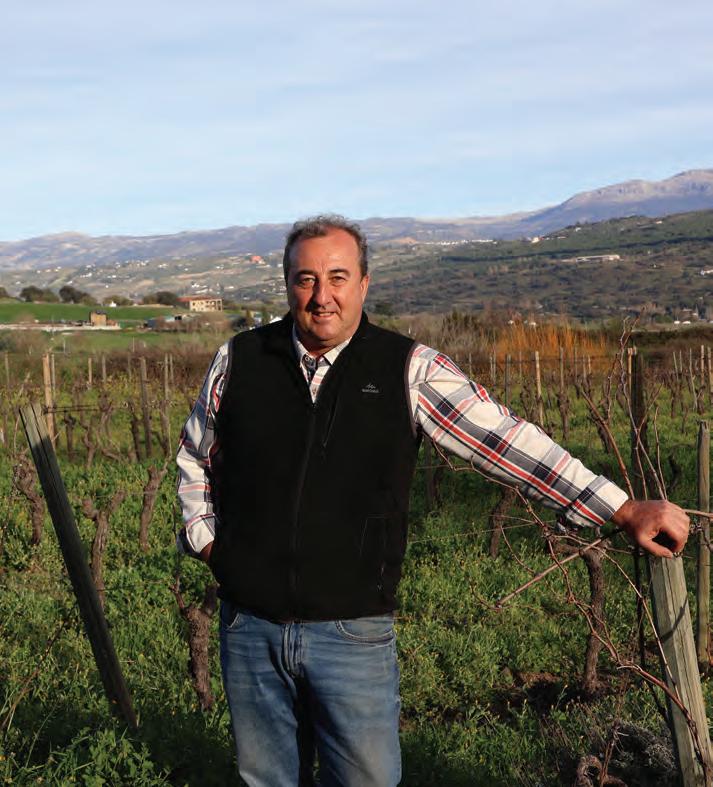
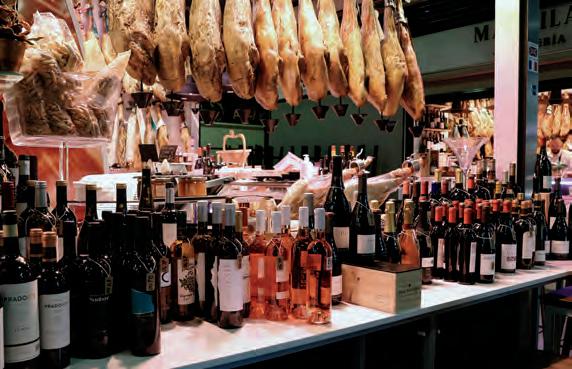
So, he ripped out the vines and planted varieties he knew from further north, like Chardonnay, Pinot Noir, Petit Verdot, Lemberger, and Moscatel Negro. He firmly believed that biodynamic principles combined with his intensive, focused efforts would allow these grapes to express their characteristics fully.
We’ve visited many vineyards, but this winemaker’s keen attention to
Biodynamic farming practices exceeded anything we’ve encountered. For example, all Biodynamic farmers must bury compost, known as “tea,” in a cow’s horn. Friedrich insists the horn be from a seven-year-old cow because this is the ideal number of moon cycles for the animal to have experienced.
Additionally, he leaves vineyard cuttings combined with charcoal (from
burnt cuttings) where they fall so that the mixture can serve as a cooling mulch and water storage system during the hot, dry summer months, thus reducing his carbon dioxide “footprint.” He also plants legumes between the vines to boost the soil’s nitrogen level.
To say Friedrich and his wife are ‘hands-on” is an understatement. They do All harvesting by hand, which is an achievable task because different varietals ripen at different times. However, as suggested in Biodynamic farming, he only picks on a “fruit” or “flower” day, corresponding to the moon’s relationship to various constellations.
He employs fiberglass storage tanks in the cellar because they maintain their temperature without adding heating/cooling elements—another energy-saving measure. The little energy the vinting requires comes from solar panels, the first installed in Andalusia.
Aging is done in oak barrels with precision we’ve seldom encountered. Friedrich uses five different oaks from three other countries because, according to him, “My father and I both felt the specific wood heavily influences the wine.” He added, “We never add yeast during fermentation. The natural yeast on healthy plants makes the best wine.”
Lastly, Friedrich employs a crystallization analysis done by a specialized outside lab, enabling him to determine whether the wine’s structure is perfect or has deficiencies that must be corrected. “This technique allows us to determine the health of the soil and the roots, which assists us in making interventions as the grapes grow.” He must be doing something right because half of his wines are exported to regions as far away as Asia.
While Andalusia is most famous as the home of bullfighting, a more peaceful pastime thrives throughout the province. So, the next time you’re in Southern Spain’s Andalusia province, live like a local and find a wine bar with tapas and ethical wines.
You may have seen the images: The single redroofed “miracle house” left after Maui’s Lahaina fire burned nearly the rest of the town down. The masses of blue tarps on homes damaged by Florida’s Hurricane Ian months after the destruction.
What these images reflect, albeit from different angles, is one inarguable fact: A resilient roof is key to maintaining home safety in our age of increasing climate catastrophes. How to protect oneself? Historically, it entailed a compromise. Steel roofing is the strongest, most sustainable, and more cost-effective option, but it hasn’t traditionally been recommended for the approximately 40% of Americans who live in coastal counties due to its perceived vulnerability to saltwater corrosion and rusting. Until now.
COASTALUME steel is a steel roofing and siding product made specifically to withstand coastal weather challenges. A collaboration between U. S. Steel and Dupont™, The COASTALUME product combines GALVALUME® coated steel, which incorporates zinc and aluminum to make it more durable, and Tedlar® PVF film, which resists corrosion, UV damage, and cracking. The new product can be used at locations as close as 300 feet from breaking surf, bays, marshes, and saltwater and brackish water sources. And its makers are so confident it’s best-in-class that they will also offer what they believe to be a first of its kind warranty. COASTALUME steel substrate - meaning its core metal - is covered for 25 years, and the film coating is covered for 50.
The COASTALUME steel is arriving at an important time. Atlantic hurricane season starts this month, and unusually warm sea water and the return of the El Nina weather pattern have experts predicting it may be among the most extreme in history.
The COASTALUME product’s advantages excel during hurricane season. Its steel can withstand wind speeds up to 140 mph, which puts it ahead of the competition - particularly asphalt shingles, which can incur damage in 80 to 100 mph winds. COASTALUME steel is also resistant to mold, mildew, and acid rain, and protects against leaks. The COASTALUME product’s advantages also span the seasons. Areas that require hail ratings will benefit from steel incurring less denting, dinging and scratches than most alloys of aluminum. And those in dry and sunny climates will appreciate that the COASTALUME product is fire-retardant. (Again, the latter distinguishes it from homes with asphalt shingles, which can burn due to the oil content in their tar.)

Still, one might ask, do the advantages of COASTALUME steel extend beyond weatherproofing and into, say, design? Indeed. The COASTALUME product comes in more than 30 colors, including wood grains, metallics and stone finishes. (Custom shade-matching is available as well.) Also attractive to homeowners, builders and architects is steel’s sustainability. Steel is the most recycled material in the world - besting aluminum, paper, glass and plastic combined. The COASTALUME steel product may also allow a home’s inhabitants to spend less on cooling systems, due to its absorption of radiant heat. Mark Carlisle, Construction Marketing Manager at U. S. Steel, says solar panels work particularly well in tandem with COASTALUME steel roofing. “If you have an asphalt roof and you install solar panels and after 20 years the asphalt shingles fail” - asphalt roofs typically last a third as long as steel ones - “you need to uninstall all the solar panels (risking damage to the panels), put a new roof on and then reinstall the solar panels. That adds significant cost. But if you have a steel system…the roof may outlive the solar.” Yet another advantage: Tedlar is free of PFAS, the “forever chemicals” found in many roof paint topcoats.
In the end, says Dave Durham, Special Projects Manager - Commercial at U. S. Steel, the most important aspect for coastal customers will likely be the COASTALUME steel product’s safety advantages. Durham has been at the company for three decades and says: “I’m always focused on resilience.” He adds, “There’s too much at stake to accept anything less.”
GALVALUME® is a registered trademark of BIEC International Inc.
Collaboration can lead to great art, among both real and artificial intelligences.
BY JASON ASHLOCK

MUSEUM
WHITNEY MUSEUM OF AMERICAN ART
Apple’s recent advertisement for the slimmest iPad was a crushing faux pas. Instruments of creativity—a trumpet, a set of oil paints, a drafting board, a stack of hard-bound books—crushed beneath the weight of a hydraulic compactor seemingly borrowed from a nearby scrapyard. (And you thought Apple’s “Mother Nature” advert was heavy-handed.) All tools of human artistic expression are now contained in an elegant piece of hardware may have been
the metaphor Apple intended. It was not, however, the metaphor the ad relayed. Consumers everywhere saw something more sinister, a signal that the emerging AI-industrial complex will soon render your artistry as irrelevant as a 1982 Datsun. Tragedy is in the eye of the transgressed.
The age of AI anxiety and opportunism is upon us, labor’s cries of forthcoming Armageddon clashing with the cheerleading of technooptimist investors and our collective gasping at the creative facility of tools like DALL-E. Long before the current hysteria, a quiet artist from Britain spent the better part of his accomplished career building an artificial intelligence software for artmaking he named AARON. A timely exhibition at the Whitney Museum of Art placed Cohen’s ur-AI project on view, including a robot using his code
to draw based on a series of prompts and a diverse selection of works produced by the computer program. The effect is at turns dreamy and disconcerting.
AARON is old-fashioned, which means he learned to draw without massive data sets extracted from the cloud to inform his composites. Instead, from the 1970s to 1990s, Cohen hand-coded instructions for objects, anatomy, botany, and relationships in a logic framework that itself constitutes a kind of functional art. The output is remarkable for such a process and wildly convincing that AARON is drawing from visual experience when, in fact, it is drawing only from Cohen’s semantics. Canvases are sometimes rudimentary, sometimes lofty, and always delightfully strange—but in an organic way that avoids the creepy uncanniness of today’s Midjourney. The quiet halls of the Whitney may levitate the works above their station, but the human figures, sketched independently by AARON and painted by Cohen, are deeply compelling. How can a machine make such decisions about length, setting, angle, and arrangement? How can it create coherence, composition, and even a sense of story from Cohen’s manual? “Legs,” Mark Zuckerberg once said of avatars in his absurd metaverse, “are hard.” AARON got them mostly right.
“If what AARON is making is not art,” Cohen once asked, “what is it exactly, and in what ways, other than its origin, does it differ from the ‘real thing?’ If it is not thinking, what exactly is it doing?” Cohen could not answer his question, and neither can we. Or at least not sufficiently. What we can answer is a simpler question: What was Cohen doing? Collaborating. With a tool more advanced than a brush, not yet as sophisticated as a large language model in a shared creativity that supercharges our capacity to imagine the artistic partnership between human and machine. Apple, take note.
Ten years ago, a feeble reviewer in the UK took a dim view of Lucius’s debut album Wildewoman: “Unconvincing” said the Guardian. More than a decade later, as the band releases a fully re-recorded version of the groundbreaking album, it’s rather the review that failed to persuade. Wildewoman has become practically talismanic. Not only the starting gun for the band’s long-distance run toward global stardom and industry accolades, but the album has also become a prototype for songwriting that harmonizes two seemingly impossible progressions: the stretching of genre boundaries that keeps a listener guessing and the illusory charm that makes one tap a foot, shout a chorus, and try shamelessly to harmonize.
About those harmonies. Wildewoman’s release was a catapult for the band’s frontwomen Jess Wolfe and Holly Laessig, whose voices imbricate in ways impossible to imitate. Their mysterious coalescence has contributed to the sonic atmosphere of dozens of the most notable acts in the world, each magnetized not only by the duo’s mystical harmonics, but by the polymathic musicality on display in Wildewoman. Find another pair equally at home with Ozzy Osbourne and Brandi Carlile, who can blend as naturally with the esoteria of Roger Waters and the stadium hooks of The Killers. Later, Lucius albums were themselves derivations of the themes of their debut. The genre limit-testing continued in the band’s electric eclecticism, bounding from indie folk to synth-pop to retro-punk to downright disco— and always with a gymnast’s nonchalance. Less attentive reviewers have skewered this migratory tendency as a challenge of identity. For those who lean in closer, the refusal of boundaries
is clearly a feature, not a bug. The band’s too kind to leave you untethered anyway: there is always the thread of lush atmospherics, the complete world-building made possible when emotive lyricism meets immersive soundscape. And beneath all that aural magnificence runs the relentless, resonant tropes, rendered across a dance of declaratives, narratives, and imperatives: heartbreak and hope, distance and doubt, recapture and regret, vulnerability, and verve.
From their early 2010s basement shows in Brooklyn, where this reviewer first encountered Lucius, it was apparent that their tradecraft exceeded the matching garments and symmetrical bobs and eyebrowraising cover art. Their business remains alchemy, blending intimate and inscrutable to create inimitable. They were then, and are now, both a friend within reach and a spirit beyond comprehension. We are lured in with a whisper to be awakened by a scream. Their startlingly courageous release of Wildewoman is in keeping with the original’s promise to find another way back home.

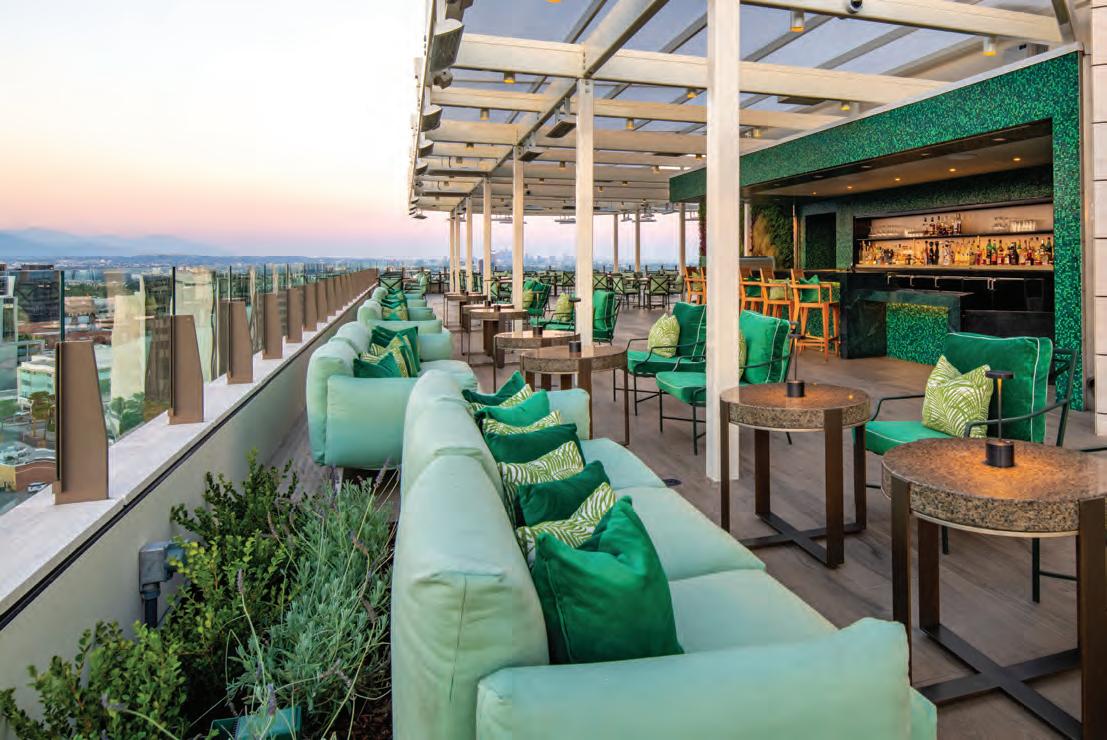
BY KIRSTEN CLUTHE
Los Angeles, synonymous with glittering celebrities, sprawling movie studios, and an endless supply of sunshine, holds countless opportunities for exploration. With curiosity and a sense of adventure, you can go deeper into the City of Angels to uncover a tapestry of experiences that showcase the city’s rich cultural diversity. Here’s a guide to some quieter corners to help you discover your version of LA.
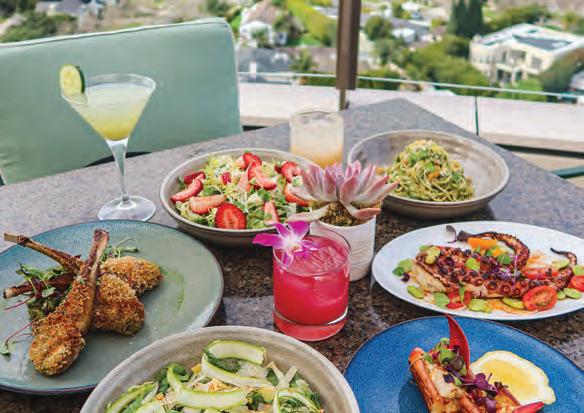
Nestled in the vibrant heart of West Hollywood, Palihouse exudes a charming “home away from home” ambiance. This boutique hotel perfectly blends vintage elegance with modern comforts, offering guests a stylish retreat in West Hollywood, undoubtedly one of LA’s most dynamic neighborhoods.
Vibe: The decor at Palihouse West Hollywood is a harmonious blend of old-world charm and contemporary chic. The lobby welcomes guests with a sophisticated mix of vintage furnishings, plush velvet sofas, and antique rugs that create a warm, inviting atmosphere. The walls are adorned with eclectic artwork and framed vintage photographs, while the lighting fixtures, a mix of crystal chandeliers and industrial lamps, add a touch of glamour and modernity. The suites are spacious and thoughtfully designed, featuring vintage-inspired decor with a modern twist. Expect custom-made furniture, classic marble counter-
tops, and luxurious bedding. Each suite feels like a stylish apartment, with a fully equipped kitchen, cozy living/dining nook, Nespresso coffee maker, and bar set up with premium spirits.
The Pool: The Palihouse’s outdoor pool is intimate and tranquil, surrounded by lush greenery and stylish lounge areas. It’s an ideal spot for a refreshing dip or simply lounging with a good book and a cocktail from the poolside service.
Lobby Cafe and Bar: The on-site restaurant boasts a charming outdoor courtyard with bistro-style seating. Inside, you’ll find a blend of rustic and refined elements and a refined all-day cafe menu. The bar is a stylish extension of the hotel’s vintage-modern aesthetic, with leather armchairs, low wooden tables, and dim, ambient lighting that creates a cozy, relaxed vibe. The bar offers an extensive selection of craft cocktails, fine wines, and local beers Palihouse West Hollywood offers guests an immersive experience with its thoughtful design, luxurious amenities, and prime location.
Mid-WIlshire / West Hollywood / Beverly Hills
LACMA
The Los Angeles County Museum of Art (LACMA) on Museum Row is another cornerstone of the city’s vibrant arts scene. As the largest art museum in the West, LACMA’s diverse collection spans centuries and cultures, offering visitors an eclectic mix of visual experiences. There’s always something new to discover from the urban lights installation to rotating exhibitions.
Established in 1934, this historic market offers an array of gourmet foods, fresh produce, and unique shops. It’s
a perfect spot to grab a quick bite or enjoy a leisurely meal while soaking in the lively atmosphere. Notable spot: Monsieur Marcel is a delightful French gourmet market and bistro in the farmer’s market.
One way to capture a travel experience is with scent. Luckyscent, the boutique perfume retailer known for its unparalleled variety of niche fragrances, has a location on Beverly Blvd in West Hollywood so you can find your perfect scent right in the neighborhood (they also have locations in DTLA and New York City). The knowledgeable staff demystifies the fragrance experience, and even if you’re a seasoned collector, you’ll undoubtedly find something new and different at the Scent Bar.
*Palihouse also has its own fragrance: Saint Pali, a limited unisex fragrance comprising over 18 rare and organic essential oils. You can smell and purchase at the front desk.
A short stroll from Palihouse on 3rd Street, AOC Wine Bar is a testament to Los Angeles’ culinary prowess. Cofounded in 2002 by celebrated chef Suzanne Goin and renowned sommelier Caroline Styne, AOC offers a dining experience reminiscent of the iconic Chez Panisse. The rustic chic ambiance, with an open-air dining area and a cozy fireplace, makes AOC a perfect spot to unwind.
A culinary landmark housed in a historic 1929 building, Republique offers an all-day dining experience that marries classic French techniques with modern flavors. Republique’s menu celebrates Los Angeles ‘ diverse culinary heritage, from freshly baked pastries in the morning to sumptuous dinners at night. The communal tables and open kitchen create a stunning atmosphere where diners can witness the magic of cooking unfold, all to a soundtrack that includes the likes of The Clash, Gang of Four,
Foreigner, and Led Zeppelin. Don’t miss the baguette with Rodolphe Le Meunier butter and pan drippings.
The Rooftop by JG at Waldorf Astoria
Perhaps the best dining experience ‘with a view’ in LA, The Rooftop by JG in Beverly Hills offers a stunning panorama of the Hollywood Hills and downtown city skyline. Helmed by Michelin-starred chef Jean-Georges Vongerichten, the menu celebrates fresh, seasonal ingredients, focusing on vibrant, flavorful dishes. As you imagine, the cocktail program offers signature cocktails like the passion fruit mojito and the lavender-infused gin and tonic.
Downtown Los Angeles (DTLA) is a cultural hub that blends the old with the new and the gritty with the glittery. One of the most prominent architectural styles in downtown LA is Art Deco, characterized by its bold geometric shapes, lavish ornamentation, and use of luxurious materials. You’ll also see Modernist, Post-Modern, and adaptive reuse among the many historic landmarks still standing among the giants downtown.
Instead of hitting the Staples Center for a game or a concert, walk through some of DTLA’s most unique locations, starting with a world-class museum, The Broad.
A contemporary art museum known for its striking architecture and impressive collection. Explore works by iconic artists like Jeff Koons, Yayoi Kusama, and Jean-Michel Basquiat. Don’t miss the Infinity Mirrored Room for a truly mesmerizing experience.
Take a ride on Angel’s Flight, the historic funicular railway transporting Angelenos since 1901 and featured in many films and television shows. This short but scenic trip offers a unique city view and connects you directly to your next destination.


Grand Central Market: Step off Angel’s Flight and head straight to Grand Central Market, a bustling food hall that has been a downtown staple since 1917. With diverse food vendors offering everything from gourmet tacos to artisanal coffee, it’s the perfect spot to experience the incredible culinary diversity of Southern California.
The Bradbury Building: Beaux-Arts style, popular in the early 20th century, known for grandeur and classical details. The Bradbury Building, constructed in 1893, is one of downtown LA’s most famous Beaux-Arts structures. Its unassuming brick exterior contrasts with the breathtaking interior, featuring open-cage elevators, marble staircases, and a beautiful atrium flooded with natural light. It has been the backdrop for numerous films and is a must-see for architecture enthusiasts.
The Last Bookstore: Wrap up your DTLA visit at The Last Bookstore and pick something up to read poolside back at the hotel. A haven for book lovers and one of the most iconic independent bookstores in LA, The Last Bookstore is a place where you can wander through its labyrinth of books, explore the art installations, and discover hidden gems in the vinyl section.
Escape the city’s hustle and bustle with a scenic hike in Malibu. The trails here offer breathtaking views of the Pacific Ocean, rugged cliffs, and lush canyons. Whether you choose the moderate Solstice Canyon trail or the more challenging Backbone Trail, Malibu’s natural beauty provides a serene backdrop for outdoor enthusiasts.
Before or after your beach walk, Zinqué in Malibu offers a high design, low-key neighborhood atmosphere, and a menu featuring French-inspired dishes. Attached to the cafe is a market and concept store with a curated offering of European and local artisan & culinary goods.


Jeffrey
Vicky




Worth chairman Jim McCann interviews Carmine Di Sibio, former CEO of Ernst & Young (EY), about his nearly four-decade career, the evolving role of AI in the firm, and his plans for the future.
BY JIM MCCANN
At the recent Milken Global Conference, Jim McCann sat down with Carmine Di Sibio, who is concluding his remarkable 39year career at EY in June. Reflecting on his journey and looking ahead, Di Sibio shared his insights on the transformative trends shaping the future, particularly the geopolitical landscape and the rise of artificial intelligence.
As he transitions from his role, Di Sibio remains optimistic about EY’s direction and his next chapter, leaving a legacy of innovation and mentorship.
This conversation has been edited for length and clarity.
Jim McCann: As you reflect on 39 years at the firm, how has that world changed?
Carmine Di Sibio: We didn’t even have computers when I started. When I was with the predecessor firm, Arthur Young, about three or four years in, we started getting these computers.
What do the next five or 10 years look like in your eyes?
Number one, I think today the world is changing. Geopolitics is changing the world. We’ll see where it is 10 years from now, but there are issues in terms of crossborder, truly operating globally.
The China relationship is a big factor. I think that is going to change some things.
Second, obviously, is AI. How’s AI going to change EY and this profession? There is no doubt that AI will be a huge tool for us to do
more work, better work. But we truly still believe in people. And so, we think of AI as a tool. Now, it’ll make some things more efficient, and it’ll make some things smarter. It’s going to be a balance.
It seems to me that you have a dual responsibility there. One is to learn the technology, but at the same time you’re the facilitator. You’re the consultant that is helping all your clients learn how to use this technology.
Absolutely. Jim. We look at AI in three different buckets. One is how do we help our clients use AI? Today, we’re doing a lot of use cases with our clients in all different sectors. Like health care and financial services.
The second is using AI to better our business. We’re a big Microsoft shop, we bought 20,000 licenses of Copilot, and we’re training our people. So that should increase our
productivity. If you asked me, “What percentage is that increase in your productivity already?” I would say it’s still early, but the initial numbers are going to be 20, 30, 40%.
The last bucket is around what I call “Good AI.” We want our people and our leaders involved with government and NGOs to make sure that what we’re doing with AI is making the world better. In our case, building a better working world.
You really are a hiring machine. So many young people want to go to work at EY because they get paid to learn. It’s just like graduate school for them, right?
It is. If you look at corporates today, and how many people in the finance organization of any corporate come from a big four firm, it’s a huge percentage. We train, really, the world when it comes to finance, accounting, and consulting. It’s a great model.
It’s a great model for [EY] because they’re all alumni of the firm. And we hope to maintain great relationships, and then eventually, end up being hired for work.
And you’re deliberate about staying connected?
Yes, we have a whole alumni relations group in the U.S. and globally that makes sure we stay connected.
Once you join EY, it’s a lifetime relationship, whether you’re here for two or three years, or you’re here for 39. Obviously, the longer you’re here, the more of a relationship with the firm there is. But some of our best clients are alumni.
You’re writing another book right now on good, proper transition. And it’s amazing to see because you’re very involved in

Janet [Truncale] coming into your role. What do you hope the Wall Street Journal, or maybe Worth, is writing about the transition a year from now? What are you hoping they say?
I have known Janet for 30 years; she has been one of my mentees for 30 years. So, I could not be prouder of EY having a great leader. She’s the first global chair and CEO of a big four firm that’s a woman. We’re all very proud of that.
EY, going forward, I think number one, will have a big focus on AI, and a big focus on productivity
and growth. Janet will look at how you unlock value going forward. It might be a different type of transaction or a different way of working, including potentially private capital and so forth. But she has a whole team that’s going to be looking at that going forward.
A year from now, what’s on the portfolio of things you’re working on?
I’m going to do a lot of different things. I’ll go on a few boards, and I will do some private equity work. I was announced on the PayPal board. The first meeting’s in July, It’ll be fun.
“I could not be prouder of EY having a great leader. She’s the first global chair and CEO of a big four firm that’s a woman. We’re all very proud of that.”
HERE ARE OUR PICKS TO BRING YOU THROUGH THE SUMMER. FROM THE PARIS OLYMPICS TO RAADFEST, WE’VE GOT YOU COVERED.

JULY 21-24, SAN DIEGO, CA
The AHA Leadership Summit convenes senior healthcare executives, clinicians, and experts to explore innovative strategies for enhancing care quality and value. The event emphasizes financial stability, workforce challenges, and improving patient experiences through operational excellence, creative partnerships, and new delivery models.
AUGUST
August 26-September 8
New York, NY
The U.S. Open is one of tennis’s four Grand Slam tournaments. It attracts the world’s top players competing in thrilling matches across men’s and women’s singles, doubles, and mixed doubles. Known for its electric atmosphere and high-stakes competition, it is a highlight of the tennis calendar.
September 4-5
JULY 26-AUGUST 11
PARIS, FRANCE
The XXXIII Olympiad will bring together global athletes to compete in a diverse array of sports. This historic event marks the third time Paris has hosted the Olympics, promising a spectacular celebration of athletic excellence, cultural exchange, and international unity.
Mountain View, CA
The ALTSV (Alternative Investments Silicon Valley) forum gathers over 500 institutional investors, family offices, and financial advisors to discuss alternative investment strategies and market trends.
July 22-24
Newport, RI
This forum gathers family office executives, private investors, and industry experts to discuss investment strategies, wealth management, and family governance. It includes panel discussions, roundtable sessions, and networking opportunities.
September 5-8
Anaheim, California
The world’s largest event focused on anti-aging and longevity, RAADfest brings together experts, scientists, and enthusiasts to discuss age reversal technologies. Attendees can expect a mix of presentations, workshops, and networking opportunities to learn about the latest breakthroughs in the field.
September 18 Miami, FL
This one-day, 250-person conference explores the use of generative AI and machine learning in enterprise settings. It brings together industry leaders and specialists for sessions on AI, machine learning, and predictive analytics, offering a mix of use cases, technical talks, and workshops.


Open the door to the incomparable value of all-inclusive, ultra-luxury cruising on Seabourn. You’ll feel right at home in our intimate, yacht-like atmosphere, pampered by intuitive, personalized service. Ensconced in your spacious ocean-front suite, you can explore all seven continents, savor gourmet dining that rivals the finest restaurants in the world, and enjoy complimentary premium wines and spirits. All with the added benefit that you only have to unpack once.



